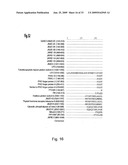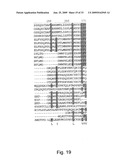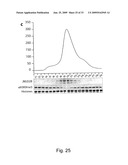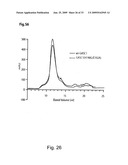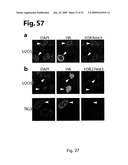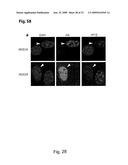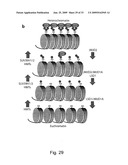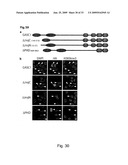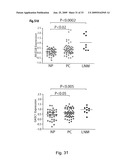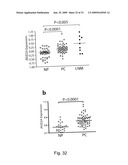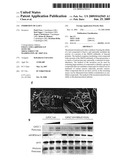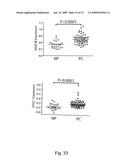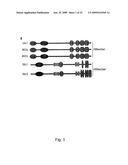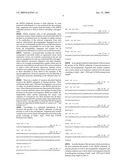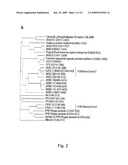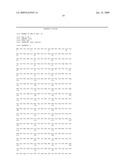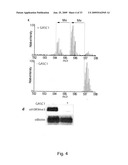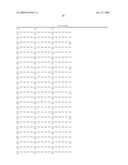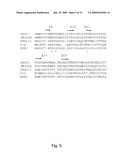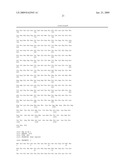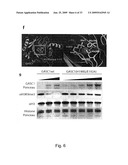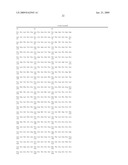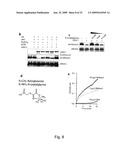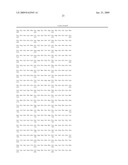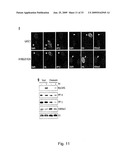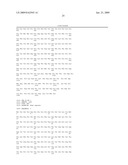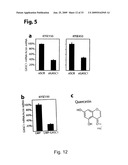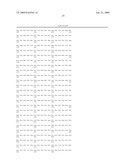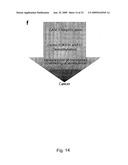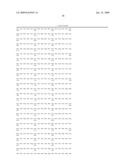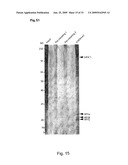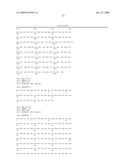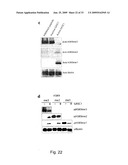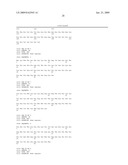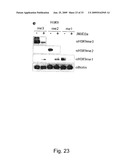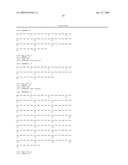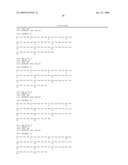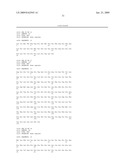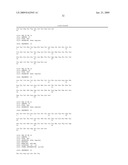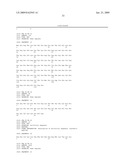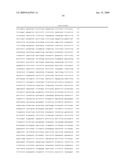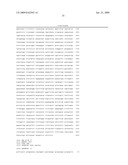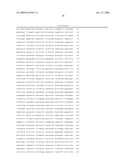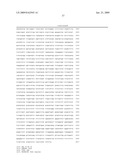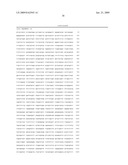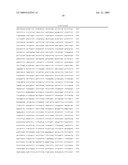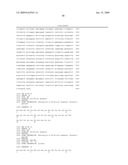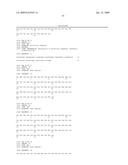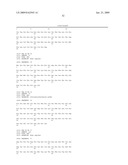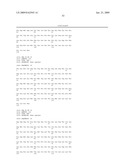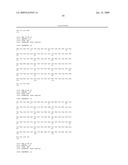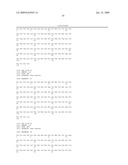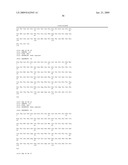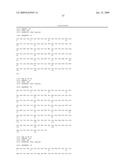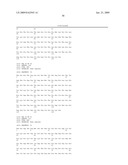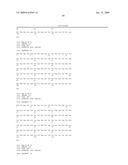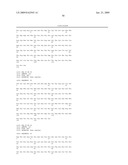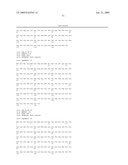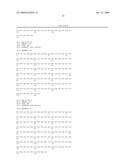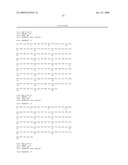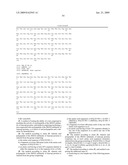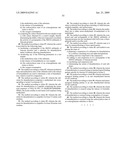Patent application title: INHIBITION OF GASC1
Inventors:
Paul Cloos (Copenhagen, DK)
Karl Agger (Copenhagen, DK)
Jesper Christensen (Copenhagen, DK)
Klaus H. Hansen (Copenhagen, DK)
Kristian Helin (Copenhagen, DK)
IPC8 Class: AG01N3368FI
USPC Class:
436501
Class name: Chemistry: analytical and immunological testing biospecific ligand binding assay
Publication date: 2009-06-25
Patent application number: 20090162945
Claims:
1-22. (canceled)
23. A method of testing the ability of a test compound to modulate the activity of a polypeptide of the JMJD2 subfamily of Jumonji proteins, said method comprising incubating a test compound with a polypeptide of the JMJD2 subfamily of Jumonji proteins, a co-factor of said polypeptide and a substrate for demethylation.
24. The method according to claim 23, wherein said polypeptide of the JMJD2 subfamily of Jumonji proteins is selected from the group comprising:a) the amino acid sequence of SEQ ID NO: 1;b) a fragment of at least 100 amino acids of the amino acid sequence of SEQ ID NO: 1;c) an amino acid having at least 45% sequence identity to either the sequence in a) or the sequence in b), or both.
25. The method according to claim 23, wherein said polypeptide of the JMJD2 subfamily of Jumonji proteins is selected from the group comprising:a) the amino acid sequences of SEQ ID NO: 1 (GASC-1 (JMJD2c)), SEQ ID NO: 2 (JMJD2a), SEQ ID NO: 3 (JMJD2b).b) a fragment of at least 100 amino acids of any one of the amino acid sequences in a);c) an amino acid having at least 75% sequence identity to any one of the sequences in a) and/or any one of the sequences in b).
26. The method according to claim 23, wherein said polypeptide of the JMJD2 subfamily of jumonji proteins comprises one or more amino acid sequences (domains) selected from the group consisting of: SEQ ID NOs: 4, 10 and 16 (JmjN), SEQ ID NO: 5, 11 and 17 (JmjC), SEQ ID NO: 6, 7, 12, 13, 18 and 19 (PHD), and SEQ ID NO: 8, 9, 14, 15, 20 and 21 (Tdr/TUDOR).
27. The method according to claim 23, said method comprising the additional steps of:a) monitoring in a test sample any of the following parameters:i) the methylation state of the substrate;ii) the release of formaldehyde;iii) the carboxylation state of an α-ketoglutarate substrate co-factor;iv) the oxygen consumptionb) comparing the values obtained for the test sample in step a) with values obtained for a control sample, thereby determining the ability of the test compound to modulate the activity of a polypeptide of the JMJD2 subfamily of Jumonji proteins
28. The method according to claim 27, wherein the control is provided by the following steps:a) Incubating a polypeptide of the JMJD2 subfamily of Jumonji proteins and a substrate for demethylation under conditions allowing demethylationb) monitoring any of the following parameters in a test sample:i) the methylation state of the substrate;ii) the release of formaldehyde in a test sample;iii) the carboxylation state of an α-ketoglutarate substrate co-factor;iv) the oxygen consumption
29. The method according to claim 27, wherein incubation time and methylation state of the substrate and/or the release of formaldehyde are used to determine a rate of demethylation, which is used for comparison
30. The method according to claim 23, wherein the substrate for demethylation comprises a methylated site corresponding to lysine 9 on histone H3.
31. The method according to claim 23, wherein the substrate for demethylation is a peptide comprising the amino acid sequence of SEQ ID NO: 25 (RQIKIWFQNRRMKWKK), the lysine residue in said amino acid sequence being methylated.
32. The method according to claim 23, wherein the substrate for demethylation is a peptide of at least 15 amino acid residues.
33. The method according to claim 23, wherein the substrate for demethylation is a peptide of at least 20 amino acid residues.
34. The method according to claim 23, wherein the substrate is selected from the group consisting of: bulk histones, synthetic peptides, and nucleosomes.
35. The method according to claim 30, wherein the methylated site is either mono-methylated, di-methylated or tri-methylated
36. The method according to claim 23, wherein the compound and said polypeptide of the JMJD2 subfamily of Jumonji proteins are also incubated with Fe(II) ions, α-ketoglutarate and/or ascorbic acid.
37. The method according to claim 27, wherein step a) is done by immunoblotting or mass-spectrometry.
38. The method according to claim 23, said method comprising the steps of:i) preparing a suspension of a substrate for demethylation in a solution containing iron and alpha-ketoglutarateii) adding said test compound to the suspensioniii) adding to said suspension in ii) a polypeptide of the JMJD2 subfamily of Jumonji proteinsiv) incubating said suspension andv) determining the extent of demethylation of said substrate.
39. The method according to claim 38, wherein the extent of demethylation is assayed using an immunological binding partner specific for histone H3 methylated at lysine 9.
40. The method according to claim 39, wherein said immunological binding partner is an anti trimethylated histone H3-K9 antibody.
41. The method according to claim 39, wherein said immunological binding partner is an anti dimethylated histone H3-K9 antibody.
42. The method according to claim 38, wherein the extent of demethylation is assayed using the release of formaldehyde.
43. The method according to claim 38, wherein the extent of demethylation is assayed using consumption of oxygen.
44. The method according to claim 38, wherein the extent of demethylation is assayed using the carboxylation state of an α-ketoglutarate substrate co-factor.
Description:
FIELD OF INVENTION
[0001]The present invention relates to a method for identifying compounds that are capable of acting as activity modulators of the JmjC domain containing proteins and which are useful for prevention and/or treatment of diseases in which genomic instability is involved in the pathogenesis.
BACKGROUND OF THE INVENTION
[0002]Methylation of lysine and arginine residues on histone tails constitutes important epigenetic marks delineating transcriptionally active and inactive chromatin. For instance, methylation of lysine 9 on histone H3 (H3-K9) is associated with epigenetically silenced chromatin1-3. In contrast to other histone modifications such as acetylation and phosphorylation, methylation has been regarded as irreversible because of the high thermodynamic stability of the N--CH3 bond. Recently however, Shi and coworkers4 identified the protein LSD1, a nuclear amine oxidase homologue, as a histone demethylase highly specific for mono- and di-methylated H3-K4. This enzyme demethylates its substrates through an amine oxidase reaction. However, LSD1 is unable to demethylate tri-methylated lysine H3-K4, most likely due to the absence of a protonated nitrogen required for oxidation4. Just prior to the completion of the present study, Tsukada et al. demonstrated that the Jumonji protein FBXL11 (JHDM1a) can specifically demethylate di-methyl H3-K36 in a Fe(II) and α-ketoglutarate-dependent manner5. Although the reaction mechanism for FBXL11-mediated demethylation at least in theory could utilize tri-methyl H3-K36 as substrate, no such activity could be demonstrated5. Thus, although the identification of LSD1 and FBXL11 as histone demethylases constituted important milestones for epigenetic research demonstrating the dynamic regulation of methyl marks, they have not resolved the question of the reversibility of tri-methylated lysine marks.
[0003]As documented by studies of the SUV39H1 knockout mouse, loss of the tri-methyl variant of the H3-K9 mark results in chromosomal aberrations and predisposes to cancer. Hence enzymes capable of reversing this mark have long been sought, although their existence has been questioned. The latter view has been reinforced by the fact that tri-methylated H3-K9 is required for the establishment and maintenance of heterochromatin, a "very stable and heritable chromatin state". The identification of such enzymes and inhibitors of their activity would provide a novel approach to the prevention and treatment of cancers.
SUMMARY OF THE INVENTION
[0004]The present invention provides a method of testing the ability of a test compound to bind to and optionally modulate the activity of a protein of the JMJD2 subfamily of Jumonji proteins, said method comprising incubating a test compound with a protein of the JMJD2 subfamily of Jumonji proteins, a co-factor of said protein and, optionally, a substrate for demethylation.
[0005]In a presently preferred embodiment of the invention, the method comprises the steps of:
i) preparing a suspension of a substrate for demethylation in a solution containing iron and alpha-ketoglutarate;ii) adding said test compound to the suspension;iii) adding to said suspension in ii) a protein of the JMJD2 subfamily of Jumonji proteinsiv) incubating said suspension and; andv) determining the extent of demethylation of said substrate.
DEFINITIONS
[0006]The term `nucleic acid molecule` refers to an oligomer or polymer of ribonucleic acid (RNA) or deoxyribonucleic acid (DNA) or mimetics thereof. This term includes molecules composed of naturally-occurring nucleobases, sugars and covalent internucleoside (backbone) linkages as well as molecules having non-naturally occurring nucleobases, sugars and covalent internucleoside (backbone) linkages which function similarly or combinations thereof. Such modified or substituted nucleic acids are often preferred over native forms because of desirable properties such as, for example, enhanced cellular uptake, enhanced affinity for nucleic acid target and increased stability in the presence of nucleases and other enzymes, and are in the present context described by the terms "nucleic acid analogues" or "nucleic acid mimics". Preferred examples of nucleic acid mimetics are peptide nucleic acid (PNA-), Locked Nucleic Acid (LNA-), xylo-LNA-, phosphorothioate-, 2'-methoxy-, 2'-methoxyethoxy-, morpholino- and phosphoramidate-containing molecules or the like.
[0007]A "polynucleotide sequence" (e.g. a nucleic acid, polynucleotide, oligonucleotide, etc.) is a polymer of nucleotides comprising nucleotides A, C, T, U, G, or other naturally occurring nucleotides or artificial nucleotide analogues, or a character string representing a nucleic acid, depending on context. Either the given nucleic acid or the complementary nucleic acid can be determined from any specified polynucleotide sequence.
[0008]With respect to the present invention the term `polypeptide` refers to an amino acid chain of any length, including a full-length protein, oligopeptides, short peptides and fragments thereof, wherein the amino acid residues are linked by covalent bonds. All polypeptide sequences in the present specification and claims are, also when not explicitly stated, written from the N-terminal to the C-terminal end in the conventional format.
[0009]Numbering of a given amino acid polymer or nucleotide polymer "corresponds to" or is "relative to" the numbering of a selected amino acid polymer or nucleic acid polymer when the position of any given polymer component (e.g. amino acid, nucleotide, also referred to generically as a "residue") is designated by reference to the same or an equivalent position in the selected amino acid or nucleotide polymer, rather than by the actual numerical position of the component in the given polymer. Thus, for example, the numbering of a given amino acid position in a given polypeptide sequence corresponds to the same or equivalent amino acid position in a selected polypeptide sequence used as a reference sequence.
[0010]A "variant" is a polypeptide comprising a sequence, which differs (by deletion of an amino acid, insertion of an amino acid, and/or substitution of an amino acid for a different amino acid) in one or more amino acid positions from that of a parent polypeptide sequence. The variant sequence may be a non-naturally occurring sequence, i.e. a sequence not found in nature.
[0011]In the present context, the term "synthetic peptide" refers to a peptide, including a short peptide that has been synthesized in vitro. The term further encompasses peptides or short peptides that have been modified by substitution with unusual or non-natural amino acids.
[0012]"Naturally occurring" as applied to an object refers to the fact that the object can be found in nature as distinct from being artificially produced by man. For example, a polypeptide or polynucleotide sequence that is present in an organism (including viruses, bacteria, protozoa, insects, plants or mammalian tissue) that can be isolated from a source in nature and which has not been intentionally modified by man in the laboratory is naturally occurring. "Non-naturally occurring" as applied to an object means that the object is not naturally-occurring i.e. the object cannot be found in nature as distinct from being artificially produced by man.
[0013]A "fragment" or "subsequence" refers to any portion of a given sequence. It is to be understood that a fragment or subsequence of a sequence will be shorter than the sequence itself by at least one amino acid or one nucleic acid residue. Thus, a fragment or subsequence refers to a sequence of amino acids or nucleic acids that comprises a part of a longer sequence of amino acids (e.g. polypeptide) or nucleic acids (e.g. polynucleotide) respectively.
[0014]The term `sequence identity` indicates a quantitative measure of the degree of homology between two amino acid sequences or between two nucleic acid sequences of equal length. If the two sequences to be compared are not of equal length, they must be aligned to give the best possible fit, allowing the insertion of gaps or, alternatively, truncation at the ends of the polypeptide sequences or nucleotide sequences. The sequence identity can be calculated as
( N ref - N dif ) 100 N ref , ##EQU00001##
wherein Ndif is the total number of non-identical residues in the two sequences when aligned and wherein Nref is the number of residues in one of the sequences. Hence, the DNA sequence AGTCAGTC will have a sequence identity of 75% with the sequence AATCAATC (Ndif=2 and Nref=8). A gap is counted as non-identity of the specific residue(s), i.e. the DNA sequence AGTGTC will have a sequence identity of 75% with the DNA sequence AGTCAGTC (Ndif=2 and Nref=8).
[0015]In all polypeptide or amino acid based embodiments of the invention, the percentage of sequence identity between one or more sequences is based on alignment of the respective sequences as performed by clustalw software (http:/www.ebi.ac.uk/clustalW/index.html) using the default settings of the program. These settings are as follows: Alignment=3Dfull, Gap Open 10.00, Gap Ext. 0.20, Gap separation Dist. 4, Protein weight matrix: Gonnet. With respect to the nucleotide-based embodiments of the invention, the percentage of sequence identity between one or more sequences is also based on alignments using the clustalW software with default settings. For nucleotide sequence alignments these settings are: Alignment=3Dfull, Gap Open 10.00, Gap Ext. 0.20, Gap separation Dist. 4, DNA weight matrix: identity (IUB).
[0016]In the present context "complementary sequence" refers to nucleotide sequences which will hybridise to a nucleic acid molecule of the invention under stringent conditions. The term "stringent conditions" refers to general conditions of high stringency. The term "stringency" is well known in the art and is used in reference to the conditions (temperature, ionic strength and the presence of other compounds such as organic solvents) under which nucleic acid hybridisations are conducted. With "high stringency conditions", nucleic acid base pairing will occur only between nucleic acid fragments that have a high frequency of complementary base sequences, as compared to conditions of "weak" or "low" stringency.
[0017]As an example, high stringency hybridisation conditions comprise (1) low ionic strength and high temperature for washing, such as 0.015 M NaCl/0.0015 M sodium citrate, pH 7.0 (0.1×SSC) with 0.1% sodium dodecyl sulfate (SDS) at 50° C.; (2) hybridisation in 50% (vol/vol) formamide with 5×Denhardt's solution (0.1% (wt/vol)) highly purified bovine serum albumin/0.1% (wt/vol) Ficoll/0.1% (wt/vol) polyvinylpyrrolidone), 50 mM sodium phosphate buffer at pH 6.5 and 5×SSC at 42° C.; or (3) hybridisation in 50% formamide, 5×SSC, 50 mM sodium phosphate (pH 6.8), 0.1% sodium pyrophosphate, 5×Denhardt's solution, sonicated salmon sperm DNA (50 μg/ml), 0.1% SDS, and 10% dextran sulfate at 42° C. with washes at 42° C. in 0.2×SSC and 0.1% SDS.
[0018]The term "isolated nucleic acid" may refer to a nucleic acid (e.g. DNA or RNA) that is not immediately contiguous with both of the coding sequences with which it is immediately contiguous (i.e. one at the 5' and one at the 3' end) in the naturally occurring genome of the organism from which the nucleic acid of the invention is derived. Thus, this term includes e.g. a cDNA or a genomic DNA fragment produced by polymerase chain reaction (PCR) or restriction endonuclease treatment, whether such cDNA or genomic DNA fragment is incorporated into a vector, integrated into the genome of the same or a different species than the organism, including e.g. a virus, from which it was originally derived, linked to an additional coding sequence to form a hybrid gene encoding a chimeric polypeptide, or independent of any other DNA sequences. The DNA may be double-stranded or single-stranded, sense or anti-sense.
[0019]A "recombinant polynucleotide" or a "recombinant polypeptide" is a non-naturally occurring polynucleotide or polypeptide that includes nucleic acid or amino acid sequences, respectively, from more than one source nucleic acid or polypeptide, which source nucleic acid or polypeptide can be a naturally occurring nucleic acid or polypeptide, or can itself have been subjected to mutagenesis or other type of modification. A nucleic acid or polypeptide may be deemed "recombinant" when it is artificial or engineered, or derived from an artificial or engineered polypeptide or nucleic acid. A recombinant nucleic acid (e.g. DNA or RNA) can be made by the combination (e.g. artificial combination) of at least two segments of sequence that are not typically included together, not typically associated with one another, or are otherwise typically separated from one another. A recombinant nucleic acid can comprise a nucleic acid molecule formed by the joining together or combination of nucleic acid segments from different sources and/or artificially synthesized. A "recombinant polypeptide" (or "recombinant protein") often refers to a polypeptide (or protein) which results from a cloned or recombinant nucleic acid or gene. The source polynucleotides or polypeptides from which the different nucleic acid or amino acid sequences are derived are sometimes homologous (i.e. have, or encode a polypeptide that encodes, the same or a similar structure and/or function), and are often derived from different isolates, serotypes, strains, species, of organism or from different disease states, for example.
[0020]The term "recombinant" when used with reference, e.g. to a cell, nucleotide, vector, protein, or polypeptide typically indicates that the cell, nucleotide, or vector has been modified by the introduction of a heterologous (or foreign) nucleic acid or the alteration of a native nucleic acid, or that the protein or polypeptide has been modified by the introduction of a heterologous amino acid, or that the cell is derived from a cell so modified. Recombinant cells express nucleic acid sequences (e.g. genes) that are not found in the native (non-recombinant) form of the cell or express native nucleic acid sequences (e.g. genes) that would be abnormally expressed under-expressed, or not expressed at all. The term "recombinant" when used with reference to a cell indicates that the cell replicates a heterologous nucleic acid, or expresses a peptide or protein encoded by a heterologous nucleic acid. Recombinant cells can contain genes that are not found within the native (non-recombinant) form of the cell. Recombinant cells can also contain genes found in the native form of the cell wherein the genes are modified and re-introduced into the cell by artificial means. The term also encompasses cells that contain a nucleic acid endogenous to the cell that has been modified without removing the nucleic acid from the cell; such modifications include those obtained by gene replacement, site-specific mutation, and related techniques.
[0021]The term "recombinantly produced" refers to an artificial combination usually accomplished by either chemical synthesis means, recursive sequence recombination of nucleic acid segments or other diversity generation methods (such as, e.g. shuffling) of nucleotides, or manipulation of isolated segments of nucleic acids, e.g. by genetic engineering techniques known to those of ordinary skill in the art. "Recombinantly expressed" typically refers to techniques for the production of a recombinant nucleic acid in vitro and transfer of the recombinant nucleic acid into cells in vivo, in vitro, or ex vivo, where it may be expressed or propagated.
[0022]"Conservative" as used herein means (i) that the alterations are as conformationally neutral as possible, that is, designed to produce minimal changes in the tertiary structure of the mutant peptide or polypeptides as compared to the native protein. Conformational neutrality is desirable for preserving biological activity. Rules exist which can guide those skilled in the art to make alterations that have high probabilities of being conformationally neutral, see e.g. (77) and (78). Some of the more important rules include (1) replacement of physicochemically similar, i.e. synonymous, residues is less likely to produce conformational changes because the replacing amino acid can play the same structural role as the replaced amino acid; and (2) alteration of evolutionarily conserved sequences is likely to produce deleterious conformational effects because evolutionary conservation suggests sequences may be functionally important.
[0023]Unless otherwise defined herein or below in the remainder of the specification, all technical and scientific terms used herein have the same meaning as commonly understood by those of ordinary skill in the art to which the invention belongs.
DETAILED DESCRIPTION OF THE INVENTION
[0024]The present invention is based on the discovery that compounds capable of acting as activity modulators of the JmjC domain containing proteins are useful for prevention and/or treatment of diseases in which genomic instability is involved in the pathogenesis. In particular, modulators of the JmjC domain containing proteins are useful for prevention and/or treatment of cancer. The present invention further pertains to the identification of the Jumonji protein; gene amplified in squamous cell carcinoma 1 (GASC1) as a protein capable of interacting with di-methylated and tri-methylated lysine 9 on histone H3 (H3-K9). GASC1 belongs to the JMJD2 subfamily of the Jumonji family. The inventors of the present invention have shown that the JMJD2 family of proteins are histone-demethylases demethylating tri- and di-methylated H3-K9. Furthermore, the inventors have demonstrated that ectopic expression of GASC1 and JMJD2 members dramatically decreases tri- and di-methylated H3-K9, increases mono-methylated H3-K9, delocalises HP1 and reduces heterochromatin in vivo. Thus, in addition to being the first identified histone tri-methyl demethylase, proteins of the JMJD subfamily of the Jumonji family are also involved in cancer development. Inhibitors of the catalytic activity of these enzymes are therefore important candidates for development of novel anti-cancer therapies.
[0025]The present invention thus pertains to a method of identifying, screening, characterising or designing a compound which is capable of modulating the activity of a protein of the JMJD2 subfamily of Jumonji proteins. The method of the invention can be used for screening large numbers of compounds to identify a group of compounds that are candidate compounds for clinical use for treatment of certain cancers especially prostate cancers. Other compounds that do not have activity in the screening assays can be eliminated from further consideration as candidate compounds. The method of the invention therefore has utility in the pharmaceutical industry.
[0026]According to the present invention a compound which inhibit the binding of a protein of the JMJD2 subfamily of Jumonji proteins to its substrates (histone peptides, histones or nucleosomes) or cofactors (a-ketoglutarate or iron) can be identified in competitive binding assays. Alternatively, the binding of a test compound to a protein of the JMJD2 subfamily of Jumonji proteins, or its substrates or cofactors can be measured directly. This latter type of assay is called a direct binding assay. Both direct binding assays and competitive binding assays can be used in a variety of different formats, similar to the formats used in immunoassays and receptor binding assays generally known in the art. For a description of different formats for binding assays, including competitive binding assays and direct binding assays, see Basic and Clinical Immunology 7th Edition (D. Stites and A. Terr ed.) 1991; Enzyme Immunoassay, E. T. Maggio, ed., CRC Press, Boca Raton, Fla. (1980); and "Practice and Theory of Enzyme Immunoassays," P. Tijssen, Laboratory Techniques in Biochemistry and Molecular Biology, Elsevier Science Publishers B. V. Amsterdam (1985), each of which is incorporated herein by reference.
[0027]In competitive binding assays, for example, a test compound compete with a labeled analyte for specific binding sites on a binding agent bound to a solid surface. In this type of format, the labeled analyte can be labeled histone peptides and the binding agent can be a protein of the JMJD2 subfamily of Jumonji proteins which is bound to a solid phase. Alternatively, the labeled analyte can be labeled JMJD2 protein and the binding agent can be a solid phase histone peptide. The concentration of labeled analyte bound to the capture agent is inversely proportional to the ability of a test compound to compete in the binding assay. The amount of inhibition of labeled analyte by the test compound depends on the binding assay conditions and on the concentrations of binding agent, labeled analyte, and test compound that are used. Under specified assay conditions, a test compound is said to be capable of inhibiting the binding of the substrate (i.e. histone peptides) or co-factor to a protein of the JMJD2 subfamily of Jumonji proteins in a competitive binding assay, if the amount of binding of the labeled analyte to the binding agent is decreased by 10% or more. When a direct binding assay format is used, a test compound is said to inhibit the binding the substrate (i.e. histone peptides) or co-factor (i.e. a-ketoglutarate) to JMJD2 enzyme when the signal measured is twice the background level or higher.
[0028]In a competitive binding assay, the sample compound competes with labeled protein for binding to a specific binding agent. As described above, the binding agent may be bound to a solid surface to effect separation of bound labelled protein from the unbound labelled protein. Alternately, the competitive binding assay may be conducted in liquid phase, and any of a variety of techniques known in the art may be used to separate the bound labeled protein from the unbound labeled protein. Following separation, the amount of bound labeled protein is determined. The amount of protein present in the sample is inversely proportional to the amount of labelled protein binding.
[0029]Alternatively, a homogenous binding assay may be performed in which a separation step is not needed. In these types of binding assays, the label on the protein is altered by the binding of the protein to its specific binding agent. This alteration in the labelled protein results in a decrease or increase in the signal emitted by label, so that measurement of the label at the end of the binding assay allows for detection or quantitation of the protein.
[0030]The binding assay formats described herein employ labeled assay components. The label can be in a variety of forms. The label may be coupled directly or indirectly to the desired component of the assay according to methods well known in the art. A wide variety of labels may be used. The component may be labeled by any one of several methods. Traditionally, a radioactive label incorporating 3 H, 125 I, 35 S, 14 C, or 32 P is used. Non-radioactive labels include ligands which bind to labeled antibodies, fluorophores, chemiluminescent agents, enzymes, and antibodies which can serve as specific binding pair members for a labelled ligand. The choice of label depends on sensitivity required, ease of conjugation with the compound, stability requirements, and available instrumentation. For a review of various labelling or signal producing systems which may be used, see U.S. Pat. No. 4,391,904, which is incorporated herein by reference.
[0031]The terms "histone peptides" and "substrate" refer to those fragments of histones that bind to JMJD2 protein. Methods of production of JMJD2 and histone proteins, for use in screening assays are known to those of skill in the art.
[0032]In particular, the method may be a method of testing the ability of a test compound to bind to and optionally modulate the activity of a protein of the JMJD2 subfamily of Jumonji proteins, said method comprising incubating a test compound with a protein of the JMJD2 subfamily of Jumonji proteins, a co-factor of said protein and, optionally, a substrate for demethylation. Particularly, it is within the scope of the present invention to identify a compound which is capable of inhibiting the activity of a protein of the LMJD2 subfamily of Jumonji proteins.
[0033]Typically, the method utilise polypeptides of the JMJD2 subfamily of Jumonji proteins and typically a GASC1 polypeptide. In particular, the method utilise a human GASC1 polypeptide or a fragment of this polypeptide, or variants of these. Accordingly, in an important embodiment the invention provides a method, wherein said protein of the JMJD2 subfamily of Jumonji proteins is selected from the group comprising: [0034]a) the amino acid sequence of SEQ ID NO: 1; [0035]b) a fragment of the amino acid sequence of SEQ ID NO: 1; [0036]c) an amino acid having at least 45% sequence identity to either the sequence in a) or the sequence in b), or both.
[0037]Cloned members of the JMJD2 subfamily of jumonji proteins include GASC1 (Swis prot accession number Q9H3R0, and its homologues JMJD2a and JMJD2b (Swis prot accession numbers O75164 and O94953, respectively).
[0038]An equally important embodiment of the invention pertains to a method, wherein said protein of the JMJD2 subfamily of Jumonji proteins is selected from the group comprising: [0039]a) the amino acid sequences of SEQ ID NO: 1 (GASC-1 (JM32Dc)), SEQ ID NO: 2 (JMJD2a), SEQ ID NO: 3 (JMJD2b). [0040]b) a fragment of any one of the amino acid sequences in a); [0041]c) an amino acid sequence having at least 45% sequence identity to any one of the sequences in a) and/or any one of the sequences in b).
[0042]The skilled person will realize that the presently known members of the JMJD2 subfamily of Jumonji proteins are approximately 45% identical by sequence when the amino acid sequences are aligned to a best fit. Therefore, for the present application the amino acid sequences used are at least 45% identical to the sequence of any of the members of the JMJD2 subfamily of Jumonji proteins. In particular, the sequence identity may be at least 45%, such as at least 46%, 47%, 48%, 49%, 50%, 52.5%, 55%, 57.5%, 60%, 62.5%, 65%, 67.5%, 70%, 72.5%, 75%, 77.5%, 80%, 82.5%, 85%, 87.5%, 90%, 92.5%, 95%, 97.5%, 98%, 98.5%, 99% or 99.5%.
[0043]In order to incorporate the functional features of the native polypeptide members of the JMJD2 subfamily of Jumonji proteins it is further preferred that the fragments are of at least 100 amino acids, such as at least 105, 110, 115, 120, 125, 130, 135, 140, 145, 150, 155, 160, 165, 170, 175, 180, 185, 190, 195, 200, 210, 220, 230, 240, 250, 260, 270, 280, 290, 300, 320, 340, 360, 380, 400, 420, 440, 460, 480, 500, 520, 540, 560, 580, 600, 620, 640, 660, 680, 700, 750, 800, 850, 900, 950, 1000, or at least 1050 amino acids.
[0044]Preferably, the fragments are of at least 150 amino acids, such as at least 151, 152, 153, 154, 155, 156, 157, 158, 159, 160, 162, 164, 166, 168, 170, 172, 174, 176, 178, 180, 182, 184, 186, 188, 190, 192, 194, 196, 198 or 200 amino acids.
[0045]The present invention further contemplates analogues of the amino acid sequences formed by conservative amino acid substitution. The principle behind conservative amino acid substitution is that certain amino acid pairs have compatible side chains such that, when one amino acid is substituted for the other, there will be only minimal changes in the tertiary structure of the peptide. Rules for conservative substitutions are explained in Bowie et al. Science 247 (1990) 1306-1310. It is an object of the present invention to utilise polypeptides, fragments and variants that retain the ability of the JMJD2 subfamily proteins to bind substrate. In some preferred embodiments it is also preferred that the polypeptides, fragments and variants retain the ability of the JMJD2 subfamily proteins to bind co-factors, including α-ketoglutarate.
[0046]Where required, each of the polypeptides, fragments and variants, where required, may be provided either in purified or un-purified form, for example as cellular extracts or by purification of the relevant component from such extracts. Alternatively, the polypeptides, fragments and variants can be recombinantly produced by recombinant expression techniques, and purified for use in the assay. Alternatively, the polypeptides, fragments and variants can be expressed recombinantly in a cell for use in cell based assays.
[0047]Typically, a polynucleotide encoding the relevant component is provided within an expression vector. Such expression vectors are routinely constructed in the art and may for example involve the use of plasmid DNA and appropriate initiators, promoters, enhancers and other elements, such as for example polyadenylation signals which may be necessary and which are positioned in the correct orientation in order to allow full protein expression. Suitable vectors would be very readily apparent to those of skill in the art, such as those described in more detail in the examples of the present application. Promoter sequences may be inducible or constitutive promoters depending on the selected assay format.
[0048]There are a number of common structural features found in the JMJD2 subfamily of Jumonji proteins. These include the JmjN, JmjC, PHD and Tdr sequences, one or more of which are preferred features of the JMJD2 jumonji proteins. These functional domains are characterised by the presence of certain particular amino acid residues located at key positions in the amino acid sequence. While not readily distinguishable when merely inspecting the amino acid sequence of a protein by eye, these domains may be determined using the SMART program (http:/smart.embl-heidelberg.de/smart). The algorithm on which the SMART program is based are described in further details in Letunic et al.58 and Schultz et al.59
[0049]Accordingly, in a preferred embodiment of the invention the protein of the JMJD2 subfamily of jumonji proteins as well as the polypeptides, fragments and variants comprise one or more amino acid sequences selected from the group consisting of JmjN-, JmjC-, PHD and TUDOR domains from Jmjd2a:
TABLE-US-00001 JmjN (AA 13-55): (SEQ ID NO: 4) RIMTFYPTMEEFRNFSRYIAYIESQGAHRAGLAKVVPPKEWKP JmjC (AA 142-308): (SEQ ID NO: 5) EKHVDEWNIGRLRTILDLVEKESGITIEGVNTPYLYFGMWKTSFAWHTED MDLYSINYLHFGEPKSWYSVPPEHGKRLERLAKGFFPGSAQSCEAFLRHK MTLISPLMLKKYGIPFDKVTQEAGEFMITFPYGYHAGFNHGFNCAESTNF ATRRWIEYGKQAVLCSC PHD (AA 709-767): (SEQ ID NO: 6) MCFTSTGCSTDINLSTPYLEEDGTSILVSCKKCSVRVHASCYGVPPAKAS EDWMCSRCS PHD (AA 829-885): (SEQ ID NO: 7) KCIFCKKRRKRTAGCCVQCSHGRCPTAFHVSCAQAAGVMMQPDDWPFVVF ITCFRHK TUDOR (AA 897-954): (SEQ ID NO: 8) QSITAGQKVISKHKNGRFYQCEVVRLTTETFYEVNFDDGSFSDNLYPEDI VSQDCLQF TUDOR (AA 955-1011): (SEQ ID NO: 9) GPPAEGEVVQVRWTDGQVYGAKFVASHPIQMYQVEFEDGSQLVVKRDDVY TLDEELP
[0050]In an equally preferred embodiment of the invention the protein of the JMJD2 subfamily of jumonji proteins as well as the polypeptides, fragments and variants comprise one or more amino acid sequences selected from the group consisting of JmjN-, JmjC-, PHD and TUDOR domains from Jmjd2b:
TABLE-US-00002 JmjN (AA 14-56): (SEQ ID NO: 10) KIMTFRPTMEEFKDFNKYVAYIESQGAHRAGLAKIIPPKEWKP JmjC (AA 143-309): (SEQ ID NO: 11) DDDVAQWNIGSLRTILDMVERECGTIIEGVNTPYLYFGMWKTTFAWHTED MDLYSINYLHFGEPKSWYAIPPEHGKRLERLAIGFFPGSSQGCDAFLRHK MTLISPIILKKYGIPFSRITQEAGEFMITFPYGYHAGFNHGFNCAESTNF ATLRWIDYGKVATQCTC PHD (AA 731-789): (SEQ ID NO: 12) MCFTSGGENTEPLPANSYIGDDGTSPLIACGKCCLQVHASCYGIRPELVN EGWTCSRCA PHD (AA 851-907): (SEQ ID NO: 13) KCVYCRKRMKKVSGACIQCSYEHCSTSFHVTCAHAAGVLMEPDDWPYVVS ITCLKHK TUDOR (AA 917-974): (SEQ ID NO: 14) RAVSLGQVVITKNRNGLYYRCRVIGAASQTCYEVNFDDGSYSDNLYPESI TSRDCVQL TUDOR (AA 975-1031): (SEQ ID NO: 15) GPPSEGELVELRWTDGNLYKAKFISSVTSHIYQVEFEDGSQLTVKRGDIF TLEEELP
[0051]In embodiments of the invention which currently are the most preferred the protein of the JMJD2 subfamily of jumonji proteins as well as the polypeptides, fragments and variants comprise one or more amino acid sequences selected from the group consisting of JmjN-, JmjC, PHD and TUDOR domains from Jmjd2 (GASC1):
TABLE-US-00003 JmjN (AA 15-57): (SEQ ID NO: 16) KIMTFRPSMEEFREFNKYLAYMESKGAHRAGLAKVIPPKEWKP JmjC (AA 144-310): (SEQ ID NO: 17) DEGVDEWNIARINTVLDVVEEECGISIEGVNTPYLYFGMWKTTFAWHTED MDLYSINYLHFGEPKSWYAIPPEHGKRLERLAQGFFPSSSQGCDAFLRHK MTLISPSVLKKYGIPFDKITQEAGEFMITFPYGYHAGFNHGFNCAESTNF ATVRWIDYGKVAKLCTC PHD (AA 689-747): (SEQ ID NO: 18) MCFIYSEENIEYSPPNAFLEEDGTSLLISCAKCCVRVHASCYGIPSHEIC DGWLCARCK PHD (AA 809-865): (SEQ ID NO: 19) KCIFCRHRVKRVSGACIQCSYGRCPASFHVTCAHAAGVLMEPDDWPYVVN ITCFRHK TUDOR (AA 877-934): (SEQ ID NO: 20) KVISVGQTVITKHRNTRYYSCRVMAVTSQTFYEVMFDDGSFSRDTFPEDI VSRDCLKL TUDOR (AA 935-991): (SEQ ID NO: 21) GPPAEGEVVQVKWPDGKLYGAKYFGSNIAHMYQVEFEDGSQIAMKREDIY TLDEELP
[0052]It should be acknowledged that the amino acid sequences of these domains may be altered by substitution without loosing function. Comprised by the present invention therefore are protein of the JMJD2 subfamily of jumonji proteins as well as the polypeptides, fragments and variants comprise one or more amino acid sequences which are at least 75% identical to any one of the sequences above, such as at least 80%, 85%, 90%, 95%, 98%, 99%, or at least 99.5% identical to any of the above sequences.
[0053]It is to be understood that the protein of the JMJD2 subfamily of jumonji proteins and a potential modulator of the activity may be incubated together under conditions which in the absence of any inhibitor of the enzyme activity provide for de-methylation of lysine 9 on histone H3. Since GASC1 is a Fe(II)- and α-ketoglutarate dependent de-methylase, the protein of the JMJD2 subfamily of Jumonji proteins is typically contacted with a substrate in the presence of a co-substrate. Typically, α-ketoglutarate, Fe(II) and ascorbic acid are used as the co-substrate, but it is within the scope of the present invention to use other co-substrates.
[0054]Various approaches to determining the activity of a protein of the JMJD2 sub-family of jumonji proteins and of the polypeptides, fragments and variants described above are available to the skilled person, including measurements of substrate and/or co-substrate utilization as well as measurement of product and/or by-product formation. In particular embodiments of the invention, the method thus comprises the additional steps of: [0055]a) monitoring in a test sample any of the following parameters: [0056]i) the methylation state of the substrate; [0057]ii) the release of formaldehyde; [0058]iii) the carboxylation state of an α-ketoglutarate substrate co-factor; [0059]iv) the oxygen consumption [0060]b) comparing the values obtained for the test sample in step a) with values obtained for a control sample, thereby determining the ability of the test compound to modulate the activity of a protein of the JMJD2 subfamily of Jumonji proteins.
[0061]Additionally, the method of the invention may incorporate measurements of any downstream effects of the factors mentioned above. In particular, since GASC action may affect transcription of certain genes it is possible to envision the use of gene reporter assays for measuring GASC activity. Such assays may rely on the measurements of activation of transcription of genes that are naturally repressed by a protein of the JMJD2 subfamily of Jumonji proteins. In addition, one may contemplate in vitro assays relying on the use genetically engineered reporter constructs including a promoter that is subject to methylation and a transcriptionally linked reporter gene.
[0062]In particular embodiments these reporter assays may involve the use of a gene which encodes a fluorescent reporter; currently one of the most commonly used fluorescent reporters is Green Fluorescent Protein (GFP).
[0063]Determination may be quantitative or qualitative. Both quantitative and qualitative determinations may, as stipulated above, be carried out in the presence of a control. If a control is used it may, depending on which assay method is used, be provided by the following steps: [0064]a) Incubating a protein of the JMJD2 subfamily of Jumonji proteins and a substrate for demethylation under conditions allowing demethylation [0065]b) monitoring any of the following parameters in a test sample: [0066]i) the methylation state of the substrate; [0067]ii) the release of formaldehyde in a test sample; [0068]iii) the carboxylation state of an a-ketoglutarate substrate co-factor; [0069]iv) the oxygen consumption
[0070]In some embodiments of the present invention the incubation time and methylation state of the substrate and/or the release of formaldehyde are used to determine a rate of demethylation, which is used for comparison.
[0071]As the natural substrate for GASC1 is histone H3 it will be understood that in some embodiments of the invention the substrate for demethylation comprises a methylated site corresponding to lysine 9 on histone H3. In a particular embodiment of the invention the substrate for demethylation is a peptide comprising the amino acid sequence of SEQ ID NO: 22 (TARKSTG).
[0072]The lysine residue in said amino acid sequence (SEQ ID NO: 22) corresponding to Lys9 in Histone H3 is methylated. In most embodiments of the invention it is preferred that the lysine residue is tri-methylated, but assays may also be performed wherein said lysine residue is di- or mono-methylated.
[0073]Currently, as a substrate it is preferred to use a peptide, such as a synthetic peptide, comprising N-terminal residues 6-12 of histone H3, such as residues 5-9,4-10, 3-10, 2-11, 1-12, 1-13, 1-14, 1-15, 1-20, 1-25, 1-30, 1-35, 1-40, 1-45, 1-50, 1-55, 1-60, 1-65, 1-70, 1-75, 1-80, 1-85, 1-90, 1-95 or 1-100 of histone H3. In the present application the full sequence of Histone H3 is provided in SEQ ID NO.: 23
[0074]In accordance with the above description of the substrate for demethylation, it is preferred that said substrate is a peptide of at least 6 amino acid residues, such as at least 7, 8, 9, 10, 11, 12, 13, 14, 15, 16, 17, 18, 19, 20, 21, 22, 23, 24, 25, 26, 27, 28, 29, 30, 32, 34, 36, 38, 40, 45, 50, 60, 70, 80, 90, 100, 120, 140, 160, 180, 200, 250, 300 350, 400, 500, 600, 700, 800, 900 or such as least 1000 amino acid residues. A peptide of 80 amino acid residues or less is conveniently obtained through chemical synthesis using commercially available services or apparatus.
[0075]The skilled artisan will realize that peptides which are at least 75% identical to the N-terminal residues of histone H3 as specified above, such as at least 77.5%, 80%, 82.5%, 85%, 87.5%, 90%, 92.5%, 95%, 97.5%, 98%, 98.5%, 99% or 99.5% identical to the N-terminal residues of histone H3. The peptides may incorporate substitutions as explained in detail above for the protein of the JMJD2 subfamily of Jumonji proteins. In particular, conservative substitutions may be preferred, following the same principles as described above.
[0076]In further preferred embodiments of the invention, as a minimum, the substrate comprises an amino acid sequence selected from the group consisting of:
[0077]In a currently most preferred embodiment, a synthetic peptide 43 amino acids long mimicking the N-terminal tail (1-40) of histone H3, ARTKQTARKSTGGKAPRKQLATKAARKSAPATGGVKKPHR (SEQ ID NO: 24) is used as a substrate.
[0078]It may further be preferred to use a substrate selected from the group consisting of: bulk histones, synthetic peptides, and nucleosomes.
[0079]As mentioned above the method of the invention may be performed with a substrate, wherein the methylated site is mono-methylated, di-methylated or tri-methylated
[0080]As mentioned above, α-ketoglutarate serves as a co-factor of GASC1 and is therefore be required in the method according to the invention. It is further within the scope of the invention to use as co-factor an analogue of a-ketoglutarate. Additionally, the GASC1 catalytic activity benefits from the presence of ascorbic acid, and in addition to α-ketoglutarate, Fe(II) ions may be important as a co-factor. Accordingly, in a preferred embodiment of the invention the compound and said protein of the JMJD2 subfamily of Jumonji proteins are also incubated with Fe(II) ions, and/or ascorbic acid. It is to be understood that the presence of ascorbic acid is not essential, but ascorbic acid may be needed in order to obtain the full catalytic activity since it converts the iron present in the reaction to the appropriate form, Fe(II).
[0081]A cell-free system may be applied when testing compounds acting directly on a protein of the JMJD2 subfamily of Jumonji proteins. The test system is contacted with the test compound and the ability of the test compound to regulate activity of said protein of the JMJD2 subfamily of Jumonji proteins is determined by measuring substrate (nucleosomes, histones or histone-peptides) conversion utilizing an immunoassay.
[0082]The peptide substrate of the protein of the JMJD2 subfamily of Jumonji proteins, or the product of its catalytic activity, may for instance be immobilised, e.g. on a plate or bead, and the methylation state or the de-methylation of the appropriate methylated site detected using an antibody or other binding molecule which binds the peptide with different affinity depending on the methylation state. Accordingly, immunological binding partners, which recognize either tri-, di- or mono-methylated histone H3-K9 constitute a part of the test system and will enable a fast determination of a compounds effect on the activity. Such binding partners, including substrate- and product-specific antibodies, are commercially available.
[0083]Assay methods of the present invention may also take the form of an in vivo assay. The in vivo assay may be performed using cell based, organ based or whole animal assays. Preferably, the in vivo assay is performed in a cell based system, for instance using a cell line in which the relevant polypeptides or peptides are expressed from one or more vectors introduced in the cell. The cell may, for example, be a yeast cell or a cell of mammalian origin.
[0084]In addition, the in vivo assays used in relation to the present invention may rely on isolated cells/primary cells or tissue sections. In a particular interesting embodiment the in vivo assay involves the use of the KYSE-150 cell line, which is a human esophageal squamous cell carcinoma established from the poorly differentiated esophageal squamous cell carcinoma resected from upper (cervical) esophagus of a 49-year-old Japanese woman after receiving radiotherapy (tumor was invading contiguous structures); described as carrying amplified oncogenes, c-erb-B (8×) and cyclin D1 (4×) and producing tumors in nude mice confirmed as human with IEF of AST, LDH, MDH
[0085]Measurements of the methylation state may, as presently preferred, be combined with the release of formaldehyde-3H by fluorography. A similar technique for measuring formaldehyde release by a formaldehyde-dehydrogenase coupled assay is also contemplated in the present invention.
[0086]In preferred embodiments of the invention the methylation state of the substrate and/or the release of formaldehyde and/or the carboxylation state of an α-ketoglutarate substrate co-factor and/or the oxygen consumption are measured by immunoassays (ELISA, RIA, IRMA, TRIFMA), immunoprecipitation, western blotting, BIAcore, x-ray crystallography, in solution NMR, mass-spectrometry, spectroscopic or fluorescence techniques.
[0087]In a currently preferred embodiment of the invention, the measurements of substrate utilization and/or product formation is performed by immunofluorescence analyses, preferably by confocal immunostainings. In the presently most preferred embodiments of the invention the peptide substrate is linked to biotin as explained in the examples.
[0088]When measuring the methylation state in assays relying on substrate specific antibodies a decreased level of binding of the immunological binding partner, as compared to suitable controls, means a decrease in tri- or di-methylated H3-K9 which correlate with an increase in the activity of a protein of the JMJD2 subfamily of Jumonji proteins. Binding of the immunological binding partner can be assessed by techniques generally know in the art, for example Western blot, ELISA, RIA, TRIFMA, immuno-precipitation or histology. Preferred techniques comprise high-throughput screening techniques as Fluorescence Polarisation, Time Resolved Fluorescence Resonance, energy Transfer Assay (TR-FRET), Scintillation Proximity Assay and "Fluorescence Quenching" Assay. The expression can be coupled to an easy detectable reporter protein, such as, but not limited to, β-galactosidase, chloramphenicol acetyltransferase (CAT), Green Fluorescent Protein, or luciferase.
[0089]For competition measurements a synthetic or natural occurring histone peptide might be supplied either in a labelled or unlabelled form. The antibodies may be used with or without modifications. The antibodies may be labelled by joining them, either covalently or non-covalently, with a reporter molecule. Suitable reporter molecules or labels, which may be used for ease of detection, include radionucleotides, enzymes, fluorescent molecules, chemiluminescent, or chromogenic agents as well as substrates, cofactors, inhibitors, magnetic particles, and the like. Antibodies or synthetic peptides of the kit might be immobilised, preferably on a solid surface like a micro-titter plate, possibly by conjugation to a suitable protein carrier like BSA, thyroglobulin, ovalbumin or keyhole limpet hemocyanine.
[0090]In a presently preferred embodiment of the invention, the method comprises the steps of:
i) preparing a suspension of a substrate for demethylation as defined in any of claims 8-13 in a solution containing iron and alpha-ketoglutarate;ii) adding said test compound to the suspension;iii) adding to said suspension in ii) a protein of the JMJD2 subfamily of Jumonji proteins as defined in any of claims 2-4;iv) incubating said suspension, preferably at a temperature of 35-38° C. for 10 minutes or more; andv) determining the extent of demethylation of said substrate.
[0091]It is further preferred that the extent of demethylation is assayed using an immunological binding partner specific for histone H3 methylated at lysine 9.
[0092]Also, it is preferred that said immunological binding partner is an anti trimethylated histone H3-K9 antibody. Equally preferred is the use of an anti dimethylated histone H3-K9 antibody as the immunological binding partner.
[0093]In a further preferred embodiment, the extent of demethylation is assayed using the release of formaldehyde. Further, the extent of demethylation may be assayed by measuring consumption of oxygen.
[0094]Alternatively, the extent of demethylation is assayed by measuring the carboxylation state of an α-ketoglutarate substrate co-factor.
[0095]As an example the buffer in i) comprises a final concentration of 50 mM Hepes pH 7.5, 50 mM KCl, 4 mM MgCl2, 1 mM α-ketoglutarate, 40 μM FeSO4, 2 mM ascorbic acid. For practical reasons it is further preferred that the suspension has a total volume of 10-50 μl.
[0096]Finally, in addition, in order to minimize degradation of the protein components of the reaction it may be advantageous to add one or more protease inhibitors to a final concentration of 1-5 μg/μl. As an example, aprotinine and leupeptine may be included as protease inhibitors.
[0097]With respect to the above description of the various aspects of the present invention and of the specific embodiments of these aspects it should be understood that any feature and characteristic described or mentioned above in connection with one aspect and/or one embodiment of an aspect of the invention also apply by analogy to any or all other aspects and/or embodiments of the invention described.
[0098]When an object according to the present invention or one of its features or characteristics is referred to in singular this also refers to the object or its features or characteristics in plural. As an example, when referring to "a polypeptide" it is to be understood as referring to one or more polypeptides.
[0099]Throughout the present specification the word "comprise", or variations such as "comprises" or "comprising", will be understood to imply the inclusion of a stated element, integer or step, or group of elements, integers or steps, but not the exclusion of any other element, integer or step, or group of elements, integers or steps.
BRIEF DESCRIPTION OF THE DRAWINGS
[0100]FIG. 1-2: Jumonji histone demethylases GASC1, FBXL11 and their human homologues. a, Diagram of the GASC1, FBXL11 and their human homologues with their domains: JmjC--Jumonji C domain, JmjN--Jumonji N domain, Tdr--Tudor domain, PHD--Plant homeodomain. CXXC--CxxC zinc finger domain, FBX--Fbox domain, LR--Leucine rich repeat. Functional domains are determined using the SMART program (http:/smart.embl-heidelberg.de/smart). b, Phylogenetic tree of the human JmjC-domain containing proteins. The phylogenetic tree is calculated based on the JmjC domains of the proteins using the Neighbour Joining (NJ) method. The sequences used for this calculation are provided in Supplementary Figure S2.
[0101]FIG. 3-6: GASC1 demethylates tri- and di-methylated histone H3K9. a, Purification of recombinant GASC1 by size exclusion chromatography. 0.5 ml fractions were collected and 10 μl of the material was incubated with bulk histones for 30 min. at 37° C. Demethylation activity was assayed by blotting for tri-methylated H3K9. b, Demethylation assay using selected fractions (F4, F6, F8, F9, F10, F1, F12, F14, F16) from the size-exclusion chromatography of GASC1. Fractions were assayed for demethylating activity by immunoblotting as indicated. c, Mass spectrometric analysis of demethylation of a H3K9me3 peptide (ARTKQTARKSTGGKAPRKQLATKAARKSAPATGGVKKPHRYC-Ttds-K(Biotin)-NH2) by purified GASC1. The peptide was analyzed by LC-MS on a LTQ-FT after treatment with GASC1 (+GASC1) and without GASC1 (-GASC1). The deviations of the measured, mono-isotopic masses from the calculated masses are given in brackets. The calculated neutral masses are H3K9me1: 5130.885 Da, H3K9me2: 5144.900 Da, H3K9me3: 5158.916 Da, mass difference as result of de-methylation: 14.016 da H3K9 (unmethylated) was not observed. The multiplicity of the individual peaks is caused by the natural occurrence of different isotopes as simulated by IsoPro 3.0 (http://members.aol.com/msmssoft/) for our peptide (molecular formula C223H390N75O61S2), charge state +10 and resolution 50,000 (simulated spectrum). d, Demethylation assay using recombinant GASC1 and synthetic tri-methylated H3K9 peptides as substrates. Peptides are incubated with 6 μg His-GASC1 in the presence of co-factors for 30 min. at 37° C., one third of the material was analyzed by western blotting, the rest was used for mass spectrometry analysis (FIG. 2e). e, Alignment of the JmjC domains of the human Jumonji proteins GASC1, JMJD2A, FIH and FBXL11 and the fission yeast Jumonji protein Epe1. Yellow highlighting indicates similar or identical amino acids. Black, red asterisks indicate residues predicted to be involved in iron binding and a-ketoglutarate, respectively. A green asterisks indicates residues mutated in GASC1 iron-binding mutants. Arrows indicate strands of the double-stranded β-helix numbered corresponding to β-strands 8-15 of FIH, as defined by the PDB sum entry for 1 h2k. f Predicted structure of GASC1 (blue) in complex with the tri-methylated H3 histone tail (1-11) (green) and its co-factors α-ketoglutarate (red) and iron (magenta), the lysine H3K9 methyl groups are marked in yellow. Left panel shows an overview, right panel shows a magnification of the iron-binding residues His190, His288, Glu192, (white sticks). g, Demethylation assay using varying amounts of wild-type and mutant (H190G/E192A) GASC1, using bulk histones as substrate.
[0102]FIG. 7-8: GASC1 demethylation occurs through a hydroxylation reaction dependent on iron and α-ketoglutarate. a, Proposed reaction scheme for GASC1-mediated demethylation of tri- and di-methylated H3K9. 1. Fe(II) (magenta) is bound to GASC1 by the facial triad of metal binding residues His190, Glu192 and His288 (blue text). 2. α-ketoglutarate (red) is bound, probably through residues Thr186 and Lys208 3. Iron (magenta) subsequently binds molecular oxygen 4. Next oxidative decarboxylation of α-ketoglutarate (red) produces carbon dioxide, succinate (red) and ferryl (FeIV═O, magenta). 5. Ferryl (magenta) subsequently hydroxylates a methyl group of lysine H3K9 (green), releasing formaldehyde. 6. Finally the hydroxylated histone tail (green) and succinate (red) can leave the GASC1 molecule leading it vacant for new demethylation cycle. b, Demethylation assay using synthetic H3K9me3 peptide as substrates. Peptides were incubated with 20 μg His-GASC1 in the presence of, or absence of its co-factors ascorbic acid, α-ketoglutarate and Fe2SO4, and EDTA, for 30 min. at 37° C., and analyzed by western blotting. The relative demethylation activity of GASC1 was quantified using a Fujifilm darkbox LAS 3000 reader and normalized to the loading control (α-biotin). H3K9me3 peptide (lane1) was set to 100%. Lane 2-7; H3K9me3 peptide incubated in demethylation buffer in the presence or absence of EDTA or co-factors as indicated. c, Demethylation assay using recombinant GASC1 and bulk histones as substrates. Histones were incubated with His-GASC1 in the presence of co-factors (FeSO4 and α-ketoglutarate) for 30 min. at 37° C., in the presence or absence of varying amounts of the α-ketoglutarate analog N-oxalylglycine. The methylation status was evaluated by western blotting. d, Binding mode of 2-ketoglutarate and N-oxalylglycine at the Fe(II) active site. e, Formaldehyde release by GASC1 mediated H3K9me3 demethylation. Formaldehyde release was measured using a demethylation-FDH-coupled assay4. The demethylation-FDH-coupled assays were carried out using fixed amount of the enzyme GASC1 (40 μg) but varying amounts of the substrate H3K9me3 peptide. Formaldehyde production was monitored by measuring NADH production at OD 340 nm. 50 μg H3K9 peptide (unmethylated) as substrate was used as negative controls.
[0103]FIG. 9-11: Ectopic expression of GASC1 leads to loss of H3K9 di- and tri-methylation in vivo. a, Confocal microscopy of Tig-3 cells transduced with pBabe-GASC1. Tri-methylated H3K9 is lost in Tig-3 cells over-expressing GASC1. White arrows indicate cells expressing HA-tagged GASC1. b, Loss of the ability to demethylate tri-methylated H3K9 in U2OS cells expressing the GASC1H190G/E192A mutants, evaluated by immunofluorescence. White arrows indicate cells expressing HA-tagged GASC1 or expressing the HA-tagged H190G/E192A GASC1 mutant. c, Loss of the ability to demethylate tri-methylated H3K9 in U2OS cells transfected with H190G/E192A GASC1 mutant, evaluated by western blotting. d, Loss of tri- and di-methylated H3K9 and increase of mono-methylated H3K9 in U2OS cells over-expressing JMJD2a. e, Loss of tri- and di-methylated H3K9 and increase of mono-methylated H3K9 in U2OS cells over-expressing JMJD2b. f, Confocal microscopy of 3T3 cells transfected with HA-tagged GASC1 or the HA-tagged H190G/E192A GASC1 mutant. White arrows indicate cells expressing HA-tagged proteins. HP1 is delocalized in cells over-expressing GASC1. g, Western blotting of total lysate and chromatin bound fraction from HEK 293 cells with tetracycline-(Tet) inducible GASC1-expression (Myc-tagged). Addition (+) or omission (-) of Tet as indicated.
[0104]FIG. 12-14: GASC1 expression induces growth and is positively correlated with tumourigenicity. a. Transfection of KYSE-150 and KYSE-450 with siRNA to GASC1 or scrambled siRNA control. The relative amount of GASC1 messenger RNA was determined by real-time quantitative RT-PCR. b, Transfection of KYSE-150 with LMP-GASC1 or empty LMP vector followed by selection for 3 days. The relative amount of GASC1 messenger RNA was determined by real-time quantitative RT-PCR. c, Binding mode of quercetin at the Fe(II) active site of GASC1. d, Demethylation assay using recombinant GASC1 and bulk histones as substrates. Histones were incubated with His-GASC1 in the presence of co-factors (FeSO4 and α-ketoglutarate) for 30 min. at 37° C., in the presence or absence of varying amounts of quercetin. The methylation status was evaluated by western blotting. e, Effect of quercetin on the H3K9me3 methylation status of KYSE-150 and U2OS cells as evaluated by immunofluorescence. f, Model for the involvement of GASC1 in cancer development.
[0105]FIG. 15 (S1): Histone peptide pulldown of HeLa nuclear proteins Pull-down assays were performed using HeLa cell nuclear extracts and histone H3 peptide tri-methylated at lysine 9. The Hela nuclear extract was pre-cleared with uncoupled streptavidin beads (preclearing 1) and then with streptavidin beads coupled to unmodified H3 histone (preclearing 2). The pre-cleared lysate was then incubated with H3 histone peptide trimethylated at K9 (H3K9me3), precoupled to streptavidin beads. Beads were washed and bound proteins were subsequently eluted, resolved by SDS PAGE and visualized by silver staining. Protein bands enriched in the H3K9me3 pull-down were subse-quently identified by mass-spectrometry. One of the enriched bands was identified as the jumonji protein GASC1 (see arrow). The HP1 α-γ proteins also enriched in the pull-down are likewise indicated. Molecular weight markers are indicated on the left.
[0106]FIG. 16-19 (S2): Alignment of the JmjC domain human Jumonji proteins. Proteins were aligned using Vector NTI applying a Clustal W algorithm. Conserved residues, blocks of similar residues and identical residues are shaded in grey. Numbers in parenthesis indicates residue number within the protein.
[0107]FIG. 20 (S3): Purification of His-tagged recombinant GASC1, GASC1 (H190G/E192A) mutant and JMJD2A and JMJD2b. Fractions 1-4 eluted from a cobalt-affinity column, were subjected to SDS-PAGE and Coomassie stained. Fractions F2 were further purified by size exclusion chromatography to obtain highly pure protein preparations.
[0108]FIG. 21-23 (S4): GASC demethylates H3K9me3 and H3K9me2. a, Demethylation assay using varying amounts of recombinant GASC1 and oligonucleosomes or bulk histones as substrates. b, Demethylation assay using recombinant GASC1 and bulk histones as substrates. Histones were incubated with varying amounts of His-GASC1 as indicated, in the presence of its co-factors for 30 min. at 37° C., and analyzed by western blot analysis. Heat inactivation (inact.), for 5 min. at 60° C., abrogated the demethylating activity of GASC1. c, Demethylation assay using recombinant GASC1 and synthetic tri-methylated H3K9 peptides as substrates. Peptides are incubated with 10 μg His-GASC1 in the presence of co-factors for 30 min. at 37° C. d, Demethylation assay using recombinant GASC1 or JMJD2a and synthetic tri- di- and mono-methylated H3-K9 peptides as substrates. Peptides are incubated with 8 μg His-GASC1 or His-JMJD2a in the presence of co-factors for 30 min. at 37° C., and analyzed by western blot analysis.
[0109]FIG. 24-25 (S5): JMJD2A and JMJD2B demethylate histones tri- and di- methylated at H3-K9. a, Purification of recombinant JMJD2A by size exclusion chromatography. One ml fractions were collected and 10 μl of the material was incubated with bulk histones for 30 min. at 37° C. Demethylation activity was assayed for by blotting for tri-methylated H3-K9. b, Demethylation assay using recombinant JMJD2A and bulk histones as substrates. Various fractions from size-exclusion chromatography (Fig. S5a) were analyzed by western blot analysis. c, Purification of recombinant JMJD2B by size exclusion chromato-graphy. One ml fractions were collected and 10 μl of the material was incubated with bulk histones for 30 min. at 37° C. Demethylation activity was assayed for by blotting for tri-methylated H3-K9.
[0110]FIG. 26 (S6): Size exclusion chromatography of wild-type and H190G/E192A mutant GASC1.
[0111]FIG. 27 (S7): α-Ketoglutarate analogues and cobalt and nickel salts inhibit GASC1 demethylation activity. Demethylation assay using recombinant GASC1 and bulk histones as substrates. Histones were incubated with His-GASC1 in the presence of co-factors for 30 min. at 37° C., and in the presence or absence of either (a), CoCl2 or (b) NiSO4 and analyzed by western blot analysis.
[0112]FIG. 28-29 (S8): Ectopic expression of GASC1 does not affect H3K4 and H3K27 methylation. a, H3K4 trimethylation status in U2OS cells overexpressing GASC1 evaluated by immunofluorescence. b, H3K27 trimethylation status in U2OS and Tig3 cells overexpressing GASC1 evaluated by immuno-fluorescence.
[0113]FIG. 30 (S9): Putative role of GASC1 in heterochromatin modelling/plasticity. a, Confocal microscopy of U2OS cells transfected with HA-tagged JMJD2a and JMJD2b. White arrows indicate cells expressing HA-tagged GASC1. HP1 is delocalized in cells over-expressing JMJD2a and JMJD2b. b, Model for GASC1's role in heterochromatin modelling and plasticity. Recruitment of H3K9 specific histone methyl-transferases (HMTs) as GLP, G9a and SUV39H1/H2 to chromatin will lead to the progressive methylation of the H3K9 mark. First H3K9 can be mono-methylated, by enzymes as GLP, G9a. Processive HMTs as SUV39H1/H2 can subsequently act to produce di- and tri-methylated H3K9 permitting the binding of HP1. In turn, HP1-binding will lead to further recruitment of HMTs and propagation of heterochromatin. GASC1 may counteract the spreading and formation of heterochromatin by removing the di-methyl and tri-methyl marks hampering HP1-binding. GASC1 may work in concert with other demethylases as LSD146 and JMJD2a, b to counter heterochromatin.
[0114]FIG. 31-33 (S10): H3K9me3 demethylation activity of various GASC1 deletion mutants. a. Schematic representation of generated GASC1 deletion mutants used in the present study, numbers in parentheses indicate deleted residues b, Demethylation activity of wildtype GASC1 and GASC deletion mutants evaluated by immunofluorescence.
[0115]Figure (S11): The expression of the JMJD2 family of histone demethylases is increased in prostate carcinoma. a. Data from Lapointe et al (2004) PNAS 101:811-816. The study includes 62 primary prostate tumors (PC, 61 adenocarcinomas and one adenoid cystic tumor), 41 matched normal prostate tissues (NP, from the noncancerous region of the prostate), and nine unmatched (i.e. different patient) pelvic lymph node metastases (LNM). Gene expression profiling was performed by using cDNA microarrays containing 26,260 different human genes (UniGene clusters). Additional details of the study including pathological and clinical data are available at Oncomine (www.oncomine.org) or on the PNAS web site (www.PNAS.org). Bars indicated medians. P-values Mann-Withney U-test (one-tailed) are provided. b. Data from Yu et al J Clin Oncol (2004) 22:2790-2799. The study comprises human samples from men of various ages, included prostate tumors (PC, completely free of normal prostate acinar cells) and normal prostate tissues (NP, adjacent to tumor free of tumor cells). Gene expression profiling was performed by using the Affymetrix (Santa Clara, Calif.) U95a, U95b, and U95c chip sets (37,777 genes and expression sequence tags). Additional details of the study are available at the Oncomine web site (www.oncomine.org). Bars indicated medians. P-values Mann-Withney U-test (one-tailed) are provided.
EXAMPLES
[0116]In an effort to identify proteins interacting with tri-methylated variants of H3K9, HeLa nuclear proteins were affinity purified using biotinylated H3 peptides immobilized on streptavidin-agarose. Synthetic 43-mers mimicking the whole N-terminal tail of histone H31-40, either un-methylated or tri-methylated at lysine 9, were used in the in vitro binding experiments. Bound proteins were eluted from the agarose-matrix, separated by SDS PAGE, silver stained and identified by mass spectrometry. Several proteins were specifically enriched on tri-methylated H3K9 as compared to un-methylated H3K9, supplementary figure S1.
[0117]Among the proteins identified was the Jumonji protein GASC1 (FIG. 1a). Due to the presence of a Jumonji domain JmjN and a related JmjC domain the protein is also denoted JMJD2c8, 9 (FIG. 1a). The Jumonji protein family comprises a diverse group of proteins that belong to the α-ketoglutarate-dependent oxygenase superfamily. These proteins regulate various cellular processes, comprising cell-cycle progression and transcriptional regulation5, 10-14. A widespread feature of this protein group is the ability to bind Fe(II) ions. In addition, many of these proteins have the capability to hydroxylate protein substrates using α-ketoglutarate as a co-factor15. Of special interest, JmjC domain proteins have recently been identified as possible candidates for histone demethylases16.
[0118]Since GASC1 was found to be associated with tri-methylated (me3) H3K9, the idea that GASC1 might be involved in demethylating this epigenetic mark was intriguing. To test this possibility, recombinant full-length His-tagged human GASC1 was generated ad purified from bacculovirus-infected insect cells (Supplementary Fig. S3). The affinity purified GASC1 was further purified by size exclusion chromatography, and the eluted highly pure GASC1 was tested for demethylation activity, by incubation with bulk histones. As shown in FIG. 3a, GASC1 very efficiently reduced tri-methylation at H3K9 as evaluated by immuno-blotting. It was also found that GASC1 could demethylate oligonucleosomes, the relevant physiological template (supplementary figure S4a).
[0119]To further analyse the specificity of the demethylating activity of GASC1, various fraction from the size-exclusion chromatography of GASC1 representing high to low amounts of GASC1 were incubated with bulk histones and synthetic H3-peptides methylated at lysine K9 or K27, and the methylation status of various epigenetic marks was evaluated by immunoblotting (FIGS. 3b and S4b). Here di- and tri-methylated H3K9 from histones was completely removed in the fractions with the highest concentrations of GASC1 (F9-12). A concomitant increase in mono-methylated (me1) H3K9 was also noted, consistent with GASC1 converting tri-methyl H3K9 to di-methyl (me2) and further to mono-methyl H3K9 (me1).
[0120]In contrast, the levels of other tested epigenetic marks including di-methylated H3K4, tri-methylated H3K4, tri-methylated H3K27 and tri-methylated H4K20 appeared to be unaffected by GASC1 treatment (FIGS. 3b and S4b).
[0121]Interestingly, di-methylated H3K9 appeared to be increased when histones were reacted with low to moderate amounts of GASC1 (F6, F8, F14 and F16). This indicates that the reason for the apparent increase in the di-methylated H3K9 mark could be due to a steady state level of this mark being reached in the initial phase of the demethylation reaction. Thus, it can be envisioned that although some di-methyl H3K9 is lost through GASC1 demethylation, additional di-methyl H3K9 will be added to the global pool by GASC1 demethylation of tri-methyl lysine, at least as long as significant levels of tri-methyl H3K9 are present.
[0122]Consistent with the results in FIGS. 3a and b, the demethylation activity of GASC1 vary in a concentration dependent manner and can be abolished by heat-denaturation of GASC1, Fig. S4 b,c, suggesting that the reaction is an enzyme-reaction. An additional in vitro demethylation study was performed, where pure synthetic tri-methylated H3K9 peptide was incubated with GASC1 Following 30 minutes incubation of pure tri-methylated H3K9 with GASC1 almost all tri-methyl H3K9 was converted to di- and mono-methyl H3K9 (Fig. S4 c,d).
[0123]To formally show that GASC1 does indeed demethylate tri- and di-methylated H3-K9, mass spectrometry was performed on synthetic peptides that had been incubated alone or in the presence of GASC1. This analysis showed that the majority of H3K9me3 peptide (approximately 80%) was converted to di- and mono-methylated H3-K9 after incubation of with GASC1 (FIG. 4c-6f).
[0124]Next it was considered whether the close GASC1-homologues JMJD2a and JMJD2b (FIG. 1 a, FIG. 2 b) could also demethylate H3K9 in vivo. To investigate this full-length human JMJD2a, JMJD2b were cloned and recombinant proteins were produced from bacculovirus infected cells. Both homologues could demethylate H3K9me3 and H3K9me2 from bulk histones (supplementary figure S5). Likewise, GASC1 and its homolog JMJD2A appeared to have a comparable ability to demethylate synthetic H3K9 substrates (supplementary figure S4 d,e). Together, these results strongly suggest that both tri- and di-methylated H3K9 are substrates of GASC1 and its homologues in vitro.
[0125]To obtain insights into the specificity of the demethylation reaction in vivo, irst human GASC1 was modelled onto the structure of FIH, the only Jumonji protein for which the three-dimensional structure has been resolved11, 15, 17-19. In agreement with the alignment (FIG. 5 and supplementary Fig. S2), the modelling indicated that residues histidine H190, glutamic acid E192, and histidine H288 form an essential part of the iron-binding groove of GASC1 (FIG. 6h, i). Further, the in silico model also predicted that residues T187 and R208 are involved in binding of a-ketoglutarate and critical for the demethylation function of GASC1. Next, the tri-methylated H3 histone tail was modelled onto the predicted GASC1 structure. The H3 histone tail tri-methylated at K9 fitted well into the iron-binding groove of GASC1 and the K9 methyl groups could be placed in close vicinity to the reactive iron without causing any steric clashes between the methylated histone tail and the GASC1 structure (FIG. 6h). On the basis of this in silico model it was predicted that mutating H190 and E192 would be sufficient to abrogate the iron-binding ability of GASC1 and thus also to inhibit its demethylation activity.
[0126]To test this hypothesis, performed demethylation assays were performed by incubating bulk histones with wild-type and mutant GASC1 (H190G/E192A) in which histidine H190 and glutamic acid E192 had been replaced with glycine and alanine, respectively. While wild-type GASC1 had a robust demethylating activity, mutant GASC1 had no detectable demethylation activity, indicating that the putative iron-binding residues are crucial to the demethylating activity of GASC1. Size-exclusion chromatography profiles of wild-type and mutant GASC1 were almost identical indicating that the mutations did not compromise the overall structure of the protein (supplementary figure S6).
[0127]Next, several experiments were performed to address the reaction mechanism for GASC1-mediated demethylation of the H3K9 tri and di-methyl marks. Various studies11, 17-24 of α-ketoglutarate-dependent oxygenases including the Factor Inhibiting HIF1 (FIH) suggest the following reaction mechanism: first the enzyme binds iron through its metal-binding motif HXD/EXnH the so-called facial triad20 (HXEXnH in GASC1). Then, the Fe(II)-enzyme complex binds the co-factor α-ketoglutarate (αKG), and subsequently the substrate and oxygen. The binding of oxygen is followed by the oxidative decarboxylation of αKG to produce succinate, carbon dioxide and ferryl. The latter, is a highly reactive group and can potentially oxidise a C--H bond in a lysine methyl-group, forming an unstable carbinolamine that rapidly would break down leading to the release of formaldehyde and loss of a methyl group from lysine (FIG. 7a).
[0128]Dioxygenases belonging to the cupin superfamily are dependent upon Fe(II) and α-ketoglutarate. In addition, some cupin dioxygenases, including FBXL11 have the additional requirement of ascorbate for full catalytic activity5, 21, 23. The mode of action of ascorbate is presently unclear but has been suggested to reduce Fe(III) to its active state Fe(II) or to function as a "surrogate reducing substrate" to `rescue` the dioxygenase enzyme in the event of the uncoupled production of a ferryl (FeIV═O) intermediate17, 22.
[0129]To test whether GASC-1 mediated demethylation would fit the reaction-mechanism described above and depicted on FIG. 7a, the importance of the putative co-factors for the demethylation reaction was tested.
[0130]Purified His-tagged GASC1 was incubated with bulk histones as substrate in the presence or absence of its co-factors (FIG. 3b). In the presence of all its co-factors GASC1 demethylates H3K9me3 in vitro, whereas GASC1-incubations in the presence of EDTA (chelating iron) or GASC1 incubations in the absence of its co-factors was significantly reduced (FIG. 8b). The ability of the demethylation reaction to occur in spite of no addition of co-factors, is probably due to co-factors (iron and αKG) co-purifying with the recombinant GASC1. For this reason we further sought to confirm the importance of these co-factors by testing the ability of N-oxalylglycine, quercetine, CoCl2 and NiSO4 to inhibit GASC1-mediated demethylation of H3K9me3. All these compounds were all able to inhibit the demethylation reaction effectively (FIG. 8c and data not shown). N-oxalylglycine (FIG. 8d) and quercetine are αKG-analogues and presumably inhibit the activity of GASC1 by displacing αKG from the iron-binding residues of GASC1. Analogously the inhibition of GASC1 by CoCl2 and NiSO4 probably involves dislocation of Fe(II) from the iron-binding site of GASC1 by competing cobalt(II) or nickel(II) ions. The requirement of ascorbic acid, αKG and iron in the demethylation reaction and the inhibition of the reaction by nickel and cobalt salts and αKG analogues strongly suggest that GASC1 is indeed a dioxygenase.
[0131]Moreover, in the presence of its cofactors Fe(II) and αKG, recombinant His-tagged GASC1 released formaldehyde (FIG. 8e) consistent with the proposed reaction scheme on FIG. 3a. Taken together, these results demonstrate that GASC1 directly demethylates tri- and di-methylated lysine K9 on histone H3 in vitro through a hydroxylation reaction requiring iron and αKG and producing formaldehyde and mono-methylated H3K9.
[0132]Having established that GASC1 can demethylate di- and tri-methylated H3K9 in vitro, it was considered whether GASC1 could modulate heterochromatin formation/maintenance in vivo. To address this question it was first investigated whether enforced expression of GASC1 could modulate H3K9 methylation in vivo. Human diploid fibroblasts were infected with a retrovirus expressing wild-type human GASC1 and the methylation status at H3K9 was tested using confocal microscopy. GASC1 localized to the nucleus, consistent with the presence of a putative nuclear localization signal in the protein. Infection with pBabe-HA-GASC1 caused an efficient decrease of H3K9 tri-methyl and an increase of mono-methylated H3K9 (FIG. 9a). In contrast, tri-methylated H3K4 and tri-methylated H3K27 were unaffected by GASC1 over-expression, (supplementary figure S7).
[0133]Next, the human osteosarcoma cell line U2OS was transfected with plasmids expressing wild-type and mutant GASC1 (H190G/E192A) in which histidine H190 and glutamic acid E192 had been replaced with glycine and alanine, respectively. While ectopic expression of wild type GASC1 efficiently abrogated the tri- and di-methylation of K9 on histone H3 in vivo, mutant GASC1 was unable to do so (FIG. 9b).
[0134]Interestingly, ectopic expression of GASC1 led to a significant increase in mono-methylated H3K9, suggesting that GASC1 demethylates both tri- and di-methylated H3K9 in vivo. The decrease in tri-methylated H3K9 was also apparent in GASC1 transfected U2OS cells, when evaluating the global levels of this mark by western blotting (FIG. 10c), further confirming the crucial importance of these predicted Fe(II)-coordinating residues.
[0135]Next, it was tested whether the close GASC1-homologues JMJD2a and JMJD2b (FIG. 1 a, FIG. 2b) also could demethylate H3K9 in vivo, by over-expressing the proteins in U2OS cells. As for GASC1, ectopic expression of JMJD2a and JMJD2b led to a significant reduction of tri- and di-methylated H3K9, with a concomitant increase in mono-methylated H3K9 (FIG. 10 d, e). These results suggest that GASC1 belongs to a family of histone H3K9 demethylases.
[0136]Heterochromatin formation and maintenance requires the presence of tri- and di-methylated H3K9 and HP1-binding25-27. Since the ectopic expression of GASC1 leads to a global reduction of H3K9 di- and tri-methylation, it was tested whether HP1-binding and localization was affected by increased levels of GASC1. NIH 3T3 cells were transfected with a plasmid expressing HA-tagged GASC1, and determined the endogenous HP1 distribution in pre-extracted cells by confocal microscopy. As anticipated, HP1p was delocalized in cells over-expressing GASC1, whereas no delocalization occurred when the H190G/E192A mutant was transfected (FIG. 11f). Likewise ectopic expression of the GASC1 homologues JMJD2a and JMJD2b led to de-localization of HP1 (supplementary figure S8). These results were further validated by demonstrating decreased levels of HP1α and HP1γ associated with chromatin in GASC1 over-expressing cells (FIG. 11g). For this purpose, HEK293 cells with tetracycline-regulated expression of Myc-tagged GASC1 were generated. Selected cells were incubated in the presence or absence of tetracycline overnight and as shown in FIG. 11g, the amount of chromatin-bound HP1α and HP1γ was reduced in GASC1 over-expressing cells. Taken together these results suggest that GASC1 could play a physiological important role in controlling heterochromatin formation and maintenance.
[0137]Until recently, tri-methylated lysine has been considered as an irreversible covalent histone modification28 and the present report is the first to identify a histone tri-methyl demethylase. Our results show that GASC1 specifically demethylates methylated H3K9, but in contrast to LSD1 and FBXL11 that are specific for mono- or di-methylated substrates4, 5, GASC1 has the ability to remove both the di- and tri-methyl species of H3K9 in vitro and in vivo.
[0138]GASC1 contains several domains, which potentially could serve to confer the protein with its exquisite specificity towards tri- and di-methylated H3K9 (FIG. 1a). In addition to a Jumonji C (JmjC) and Jumonji N domain (JmjN), the protein features two plant homeodomains (PHD) as well as a tandem Tudor domain (Tdr). The function of these domains is presently unclear but they have all been implicated in chromatin modulation8, 10, 12, 29, 30. For example, the Tudor domain of 53BP1 has been reported to bind to the tri-methylated form of lysine 79 on histone H331 and the PHD domain has been shown to collaborate with Bromo domains in binding to nucleosomes30. In order to gain insights into which domains are required for the demethylation function of GASC1 and to resolve which domains determine its substrate specificity, mutational studies of the GASC1 protein were performed. This was done by generating a series of GASC1 expression constructs carrying deletions of the JmJC, JmjN and PHD domains. These results showed that the JmjC and JmjN domains are indispensable for the demethylating activity of GASC1 (supplementary figure S9). In contrast the deletion of the PHD domains did not appear to affect the ability of GASC1 to demethylate H3K9me3 in vivo (Fig. S9).
[0139]In light of the similar reaction mechanism of GASC1 and FBXL11, it is pertinent to ask why GASC1 has the ability to demethylate the tri-methylated histone lysine substrate, whereas FBXL11 has not. A potential explanation could be that the iron/substrate-binding groove is smaller in FBXL11 than in GASC1. Although this explanation would require experimental testing, it is supported by in silico modelling. When comparing models of the two Jumonji proteins modelled with FIH as template, it was found that they both feature a loop region located at the edge of the iron-binding groove of the models. This loop region is significantly longer in the FBXL11 model opening the possibility that it could flip, making the iron/substrate binding groove of this protein smaller and consequently inhibiting the accommodation of a tri-methyl lysine substrate.
[0140]It is predicted that the demethylation pathway described in the present report and summarized on supplementary figure S8b is evolutionarily conserved. Of note in this context, the Schizosaccharomyces pombe Jumonji protein, Epe1 has been reported to antagonize heterochromatization10. Thus a recent report10 has demonstrated that enforced expression of Epe1 causes a decrease in di-methylated H3K9 and antagonizes hetero-chromatin with a concomitant destabilization of centromers and mating type loci10. This Epe1-mediated phenotype was dependent of an intact JmjC domain and although it has not been shown that the capacity of Epe1 to antagonize heterochromatization is due to a demethylation activity, it is appealing to assume such a role in light of our present data.
[0141]The existence of several closely related human homologues (JMJD2a and JMJD2b, FIG. 2b), with similar enzymatic activity, as GASC1 is indicative of functional redundancy and the necessity for a tight control of H3K9 tri-methyl demethylase activity. This is to be expected as the strict control of heterochromatin formation and maintenance is critical for both proper biological function and genomic integrity. For instance centromeric heterochromatin formation is essential for the correct segregation of chromosomes during mitosis32. Similarly it has been demonstrated that the deletion of Suv39H1 and Suv39H2 genes in mice, whose products are responsible for di- and tri-methylation of H3K9 in heterochromatin, leads to chromosomal instability and collaborates with oncogenes in inducing mouse lymphomas6. Therefore aberrant activity of GASC1 or its homologues, could potentially lead to genomic instability and consequently cancer. Indeed, GASC1 was originally identified as a gene frequently amplified in oesophageal squamous cell (ESC) carcinoma22 and GASC1 is over-expressed in various cancer types containing chromosomal abberations33, 34.
[0142]To obtain further support for the involvement of GASC1 in cancer, the Oncomine database was searched for differential GASC1 expression in normal versus tumor tissue. The expression of GASC1 and its homologues JMJD2a and JMJD2b were found to be significantly increased in prostate cancers relative to normal tissue (supplementary figure S11). Previously GASC1 has been shown to be amplified in several cell lines derived from ESC carcinomas33. The methylation status of the H3K9 epigenetic mark was tested in an ESC cell line with GASC1 gene amplification (KYSE-150) as well as in one cell line with more moderate expression (KYSE-450). The human osteosarcoma cell-line U2OS was included as controls. To test the importance of GASC1 amplification we tested the effect of GASC1 knockdown on the H3K9 methylation status in cells transfected with siRNA oligos to GASC1 and/or to its homologues. Cells were transfected with LMP-GASC1 followed by three days selection with puromycin. The efficiency of GASC1 knockdown was assessed by RT-QPCR (FIG. 5a). H3K9me3 was significantly increased in KYSE-150 cells in response to GASC1 knockdown as evidenced by western blotting (data not shown).
[0143]Di- and tri-methylated H3K9 is required for HP1-binding, essential for heterochromatin formation and associated with transcriptional repression. Moreover these epigenetic marks are increased on specific genes in senescence, a key mechanism guarding cells against cancer36-39. It can therefore be speculated that amplification of GASC1 may reduce the ability of cells to become senescent, or lead to de-repression of otherwise silenced oncogenes (FIG. 6d). Accordingly, inhibition of GASC1-demethylating activity could thus potentially constitute a new anti-neoplastic therapeutic modality.
[0144]Intriguingly, it was found that quercetin (FIG. 12b), a plant flavanoid associated with anti-proliferative and anti-cancer properties40-42 was able to effectively inhibit GASC1-mediated demethylation of H3K9me3 in vitro (FIG. 12c). In vivo, overnight treatment of KYSE-150 cells with quercetin caused a staggering increase in H3K9 trimethylation as evidenced by immunofluorescence and western blotting (FIG. 13d and data not shown). The increase of H3K9me3 was accompanied with a marked decrease of growth rate and a senescent-like phenotype characterized by changed cell morphology, appearance of senescence associated heterochromatin foci (SAHFs) and β-gal staining (data not shown). Interestingly quercetin-treatment did not seem to affect the other cell-lines (expressing-low and moderate levels of GASC1) to the same extent. Thus U2OS, WI38 and KYSE-450 cells did not display the same increase in H3K9me3 nor the same senescent-like phenotype and growth inhibition. This result suggests that some cancers characterized by increased expression or activity of JMJD2 enzymes and subsequent decrease of H3K9me3/me2 may be especially susceptible to the growth-inhibitory effect of this compound. The biological effects of quercetin have previously been attributed to inhibition of topoisomerase I43, modulation of protein and lipid kinase signalling pathways44 and scavenging of reactive oxygen species45, In light of the present findings it is tempting to speculate that the anti-cancer effect of quercetin might at least partially by explained by its inhibitory effect on GASC1 and other members of the JMJD2 subfamily.
[0145]In summary, using several independent lines of evidence it has been shown that GASC1 directly demethylates the repressive histone di- and tri-methyl H3K9 marks both in vitro and in vivo. The present findings demonstrate that histone tri-methylation is a reversible modification. This finding may potentially have far-reaching implications for human disease, notably cancer.
MATERIALS AND METHODS
Demethylation Assay
[0146]Bulk histones, oligonucleosomes or synthetic histone peptides were reacted with purified His-GASC1 in demethylation buffer (50 mM Tris pH 8.0, 50 mM KCl, 10 mM MgCl2, 1 mM α-ketoglutarate, 40 μM FeSO4, 2 mM ascorbic acid, 0.01% (w/v) BSA and 5% (v/v) glycerol) at 37° C. In a typical reaction, either 6 μg bulk histones or 2 μg of modified histone peptides were reacted with 20 μg GASC1 in a volume of 100 μl for 30 minutes. Reaction mixtures were analyzed by either western blotting using specific antibodies, or by formaldehyde-release assays.
Formaldehyde Release Assay.
[0147]Formaldehyde release assays were performed essentially as described4. All reactions were performed in a total volume of 200 μl per reaction in a quartz cuvette. In short, recombinant GASC1 (typically 40 μg) was incubated in 150 μl demethylation buffer (see above) in the presence of 2 mM NAD+ and 0.2 U formaldehyde dehydrogenase (FDH) for 37° C. for 5 minutes. Then the reaction was started by adding substrates (histone-peptides). The absorbance at 340 nm was measured with 0.5 min intervals (15 min total) using a Genesys 10UV Thermospectronic spectrophotometer at 37° C.
[0148]GASC1 demethylation of H3K9me3 peptide for mass spectrometry analysis. Six μg of recombinant GASC1, was incubated with 3 μg H3K9me3 peptide in FDH buffer in a final volume of 90 μl for 30 min at 37° C. Urea was added to a final concentration of 4M and the mixture was incubated at 20° C. for 15 min. An equal volume of 1% TFA was added and the sample loaded on a reversed phase mini C8 column packed in a 100 μl tip (column volume of 20 μl). After washing in 1% TFA, the bound peptide was eluted in 20 μl (30% methanol, 25% formic acid). One third of the eluted material was analysed by SDS page and Western blotting using first anti-H3K9me3, followed by anti-biotin antibody (FIG. 4c). The rest of the material was analysed by mass spectrometry (FIG. 4d).
Mass Spectrometry (MS) Analysis.
[0149]One third of the eluate was injected in 1% TFA using an Agilent 1100 Nano HPLC (Palo Alto, Calif.) onto a C18-column (Reprosil-Pur C18-AQ 3 μm; Dr. Maisch GmbH, Ammerbuch-Entringen, germany) packed into a spray emitter (75 μm ID, 8 μm opening, 70 mm length; New Objectives, USA). Peptides were eluted in a gradient from buffer A (5% acetonitrile and 0.5% acetic acid) to buffer B (acetonitrile and 0.5% acetic acid) going from 0 to 20% in 10 min at 300 mL/min. Spectra were recorded on a LTQ-FT mass spectrometer (Thermoelectron, Bremen, Germany).
Supplementary Methods
Materials.
[0150]Synthetic peptides 43 amino acids long mimicking the N-terminal tail (1-40) of histone H3 (ARTKQTARKSTGGKAPRKQLATKAARKSAPATGGVKKPHR-Tyr-Cys-(Ttds)-Lys-biotin). The peptides were synthesized with a C-terminal tyrosine and cysteine for coupling and linked to biotin through lysine and a Ttds spacer. Peptides used in experiments were either unmodified, tri-methylated at lysine 27 or mono-, di-, or tri-methylated at lysine K9 were purchased from Jerini, GMBH Germany. Formaldehyde dehydrogenase (FDH, F1879) and nicotine amine and bulk histones (H9250) were purchased from Sigma. Antibodies used in the study were as follows: anti tri-methylated H3-K9, (Upstate 07-523), anti di-methylated H3-K9 (Upstate 07-212), anti mono-methylated H3-K9 (Abcam Ab9045-50), anti tri-methyl H3-K27 (Upstate 07-449), anti tri-methyl H4-K20 (Upstate 07-463), anti tri-methylated H3-K4, (Abcam ab8580-50), anti di-methylated H3-K4 (Upstate 07-030), anti histone H3 (Abcam Ab1791-100), anti HP1α (Upstate 05-689), anti-HP1γ (upstate 05-690), anti biotin-HRP (Sigma A4541), anti-His (Upstate 05-531) and anti HA (CRP Inc. AFC-101P).
Cell Lines and Tissue Culture.
[0151]Human esophageal squamous cell carcinoma cell lines KYSE-70 and 150 were obtained from the German Collection of Microorganisms and Cell Cultures, Braunschweig, Germany. Diploid human fibroblast (TIG-3) expressing hTert and U2OS cells expressing the murine ecotropic retrovirus receptor EcoR were used for the experiments. HEK293 cells stably expressing tetracycline inducible amino-terminally myc-tagged GASC1 was generated using the 293 TRex-flip-in cells essentially as described by the manufacturer (InVitrogen). KYSE cells were maintained in 49% RPMI 1640, 49% Ham's F12 supplemented 2% foetal calf serum (FCS), 5% CO2. All other cells were maintained at 37° C. in Dulbecco's modified Eagle's medium (DMEM) supplemented with 10% foetal calf serum (FCS), 5% CO2.
[0152]Histone peptide pulldown of HeLa nuclear proteins Pull-down assays were performed using HeLa cell nuclear extracts and histone H3 peptide tri-methylated at lysine 9 (ARTKQTARK(me3)STGGKAPRKQLATKAA-RKS APATGGVKKPHR-Tyr-Cys-(Ttds)-Lys-biotin). Nuclei were prepared from HeLa cells, lysed with lysis buffer (50 mM Tris, pH 7.2, 300 mM NaCl, 0.5% IGEPAL CA-630, 1 mM EDTA (pH 8.0), 1 mM PMSF containing protease inhibitors). The lysate was pre-cleared with uncoupled streptavidin beads (Fig. S1, preclearing 1) and then with streptavidin beads coupled to unmodified H3 histone (Fig. S1, preclearing 2). The pre-cleared lysate was then incubated with H3 histone peptide trimethylated at K9 (H3K9me3), precoupled to streptavidin beads. Beads were washed avidly and bound proteins were subsequently eluted from the resin with 2×LSB buffer (100 mM Tris-HCl pH 6.8, 200 mM DTT, 4% SDS, 20% glycerol and 0.2% bromphenolblue), Figure S, H3K9me3. Proteins were resolved by SDS PAGE and visualized by silver staining. Protein bands enriched in the H3K9me3 pull-down were excised, in-gel digested with trypsin and analyzed by nanoelectrospray tandem mass spectrometry as described by Wilm et al. (Wilm M. (1996) Nature 379, 466-469). Immunofluorescense Confocal immunostainings were done essentially as described by Sorensen, C. S. et al., Nat. Cell. Biol. 7, 195-201 (2005).
Preparation of Cell Lysates.
[0153]Total lysates of cells were generated from the same number of cells lysed in urea buffer (1% SDS, 9M urea, 25 mM Tris-HCl, pH 6.8, 1 mM EDTA, 0.7 M β-mercaptoethanol), boiled for 5 min. and sonicated. For chromatin fractionation an equal number of cells were incubated 30 min. on ice in 200 μl pre-extraction buffer (20 mM Hepes-KOH, pH 7.2 containing 0.5% IGEPAL-630, 50 mM NaCl, 3 mM MgCl2 and 300 mM sucrose). 100 μl was mixed with 2×LSB buffer (100 mM Tris-HCl pH 6.8, 200 mM DTT, 4% SDS, 20% glycerol and 0.2% bromphenolblue), boiled, sonicated and used as total lysate. The remaining 100 μl was spun down at 1300×g for 10 min at 4° C., washed in 1 ml pre-extraction buffer, re-suspended in 100 μl 2×LSB buffer, boiled, sonicated and used as chromatin fraction.
siRNA and shRNA to GASC1 and JMJD2a/b.
[0154]Small interfering RNA (siRNA) oligonucleotides to GASC1 and its homologs JMJD2a and JMJD2b were synthesized by Dharmacon Research, Inc. Cells (1×105/well) were transfected with siRNA oligos (0.3 μg/well) in 6-well plates using Oligofectamine reagent (Invitrogen) following the manufacturer's protocol. SiRNA can be designed according to procedures known in the art for instance using the SiRNA retriever; (http://katahdin.cshl.org:9331/homepage/siRNA/RNAi.cgi?type=siRNA).
ShRNA Constructs
[0155]Short hairpin RNA constructs were generated in the MSCV/LTRmiR30-PIG (LMP) vector (Dickens N G et al (2005) "Probing tumor phenotypes using stable and regulated synthetic microRNA precursors" Nature Genetics Vol 37, No 11 1289-1295.) according to the procedure described in Paddison et al. (2005) (Paddison P J, Cleary M, Silva J M, Chang K, Sheth N, Sachidanandam R & Hannon G J. Cloning of short hairpin RNAs for gene knockdown in mammalian cells Nature methods pp 163-167).
[0156]Three oligonucleotides were designed using the "shRNA retriever" (http://katahdin.cshl.org:9331/homepage/siRNA/RNAi.cgi?type=shRNA). Using the oligonucleotide TGCTGTTGACAGTGAGCGCGCCAGATAGCAGCAATGAAGATAG-TGAAGCCACAGATGTATCTTCATTGCTGC- TATCTGGCTTGCCTACTGCCTCGGA as template a 150 bp PCR product was amplified, digested with XhoI and EcoRI and ligated into the digested LMP vector. The shRNA construct targets a 22 bp sequence at position 2117 in the GASC1 coding sequence, underlined in the above sequence. The efficiency of the shRNAi construct to knock-down the GASC1 mRNA was estimate as approximately 80% as assessed by real-time quantitative RT-PCR.
Real-Time Quantitative RT-PCR
[0157]Cells were transfected with the indicated shRNA constructs and subjected to a brief puromycin selection (2 μg/ml). Total RNA was made from transfected cells using the Quiagen RNAeasy mini kit according to the manufacturers instructions. cDNA was generated using the Taqman reverse transcription kit and poly dT primer according to the manufacturers instructions. The cDNA was used as template in real-time quantitative PCR reactions with GASC1 specific primers on a Applied biosystems 7700. The reactions were prepared using 2×SYBR green reaction mix from Applied biosystems.
BrdU Incorporation.
[0158]Thirty hours after transfection of siRNA, the cells were split into 4-well chamber slides and incubated with culture medium containing BrdU for 15-30 min.
cDNA Cloning of Human GASC1.
[0159]The putative open reading frames of human GASC1 and JMJD2A were amplified by PCR from HeLa cDNA and cDNA from a human foetal brain cDNA library (Invitrogen, Carlsbad, Calif.). Primer sequences are available upon request. PCR products were gel purified, cloned into pCR8/GW (Invitrogen), and verified by DNA sequencing. Using these Gateway-compatible entry clones GASC1 and JMJD2A were transferred into pCMV-HA, pCMV-myc and pBabepuro. A double mutant in the conserved iron-binding domain (HTE) of GASC1 changing amino acids 190-192 from histidine, threonine and glutamic acid respectively to glycine, threonine and alanine was generated using standard mutagenesis methods.
Recombinant Proteins.
[0160]Full-length amino-terminally hexahistidine-tagged human GASC1 baculovirus transfer vector was generated by Gateway-mediated transfer of GASC1 cDNA from pCR8/GW and into a Gateway-modified form of pAcHLT-A (Pharmingen). Recombinant baculoviruses were generated by cotransfection of baculovirus transfer vector containing the GASC1 gene and Bsu36I linearized Bakpak6 baculovirus DNA essentially as previously described. Histidine-tagged GASC1 and JMJD2A was expressed and purified by cobalt-affinity chromatography essentially as described previously (Christensen et al. Nucleic Acids Research 33, 5458-5470 (2005)). The eluted fractions were analyzed by SDS-PAGE and selected fractions were subjected to further purification by size exclusion chromatography (SEC). In short, SEC was performed on a Superose 12, 10/300 column (Pharmacia-Amersham) equilibrated with 25 mM HEPES-KOH, pH 7.7, containing 50 mM NaCl and eluted with the same buffer at a flow-rate of 0.3 ml/min. Eluted material was collected in 0.5 ml fractions, flash frozen in liquid N2, and stored at -80° C. All procedures were performed on ice or at 4° C. in the presence of complete EDTA-free protease inhibitor (Boehringer Mannheim, Germany).
Retrovirus Transduction.
[0161]To generate recombinant retroviruses expressing GASC1 and its mutant H190G/E192A, the open reading frame of GASC1 was transferred into pBabepuro by Gateway-mediated recombination generating pBabepuro-HA-GASC1, and pBabepuro-HA-H190G/E192A. High titers of retroviral particles were obtained 24-48 hours after transfection of the Phoenix-Eco 293 cell packing cell line. Transfections were done using the calcium phosphate method. Transduction of TIG3-hTert-EcoR cells or U2OS-EcoR cells was achieved by adding virus containing supernatants from the packaging cell line to the cell dishes four times within a 24 hour period. Transduced cells were selected for 2-5 days in the presence puromycin (1 μg/μl).
Molecular Modelling
[0162]The structure of FIH complexed with α-ketoglutarate, CAD peptide and iron was available in Protein Data Bank (PDB, Brookhaven National Library, Upton N.Y., USA) with accession number 1H2K. GASC 122-349 was homology-modelled with FIH as template using homology module INSIGHT II (2005) (Accelrys, San Diego). The histone tail (ARTKQTARKSTG) was modelled with the CAD peptide, as template. The program GRID (Version 22, Molecular Discovery Ltd., Oxford, UK) (Goodford, 1985) was used to compute the hydrophobic surface contours of the GASC1 molecule. The histone peptide was subsequently docked onto the hydrophobic surface contours of GASC1 using AUTODOCK (Ver. 3.0.5, Scripps Research Institute and Molecular Graphics Laboratory). Finally structural models of the complexes were drawn with Pymol (http://pymol.sourceforge.net/).
Supplementary Methods
[0163]Materials. Synthetic peptides 43 amino acids long mimicking the N-terminal tail (1-40) of histone H3 (ARTKQTARKSTGGKAPRKQLATKAARKSAPATGGVKKPHR-Tyr-Cys-(Ttds)-Lys-biotin). The peptides were synthesized with a C-terminal tyrosine and cysteine for coupling and linked to biotin through lysine and a Ttds spacer. Peptides used in experiments were either unmodified, tri-methylated at lysine 27 or mono-, di-, or tri-methylated at lysine K9 were purchased from Jerini, GMBH Germany. Formaldehyde dehydrogenase (FDH, F1879) and nicotine amine and bulk histones (H9250) were purchased from Sigma. Antibodies used in the study were as follows: anti tri-methylated H3-K9, (Upstate 07-523), anti di-methylated H3-K9 (Upstate 07-212), anti mono-methylated H3-K9 (Abcam Ab9045-50), anti tri-methyl H3-K27 (Upstate 07-449), anti tri-methyl H4-K20 (Upstate 07-463), anti tri-methylated H3-K4, (Abcam ab8580-50), anti di-methylated H3-K4 (Upstate 07-030), anti histone H3 (Abcam Ab1791-100), anti HP1α (Upstate 05-689), anti-HP1γ (upstate 05-690), anti biotin-HRP (Sigma A4541), anti-H is (Upstate 05-531) and anti HA (CRP Inc. AFC-101P).
Cell Lines and Tissue Culture.
[0164]Human esophageal squamous cell carcinoma cell lines KYSE-70 and 150 were obtained from the German Collection of Microorganisms and Cell Cultures, Braunschweig, Germany. Diploid human fibroblast (TIG-3) expressing hTert and U2OS cells expressing the murine ecotropic retrovirus receptor EcoR were used for the experiments. HEK293 cells stably expressing tetracycline inducible amino-terminally myc-tagged GASC1 was generated using the 293 TRex-flip-in cells essentially as described by the manufacturer (InVitrogen). KYSE cells were maintained in 49% RPMI 1640, 49% Ham's F12 supplemented 2% foetal calf serum (FCS), 5% CO2. All other cells were maintained at 37° C. in Dulbecco's modified Eagle's medium (DMEM) supplemented with 10% foetal calf serum (FCS), 5% CO2.
[0165]Histone peptide pulldown of HeLa nuclear proteins Pull-down assays were performed using HeLa cell nuclear extracts and histone H3 peptide tri-methylated at lysine 9 (ARTKQTARK(me3)STGGKAPRKQLATKAA-RKS APATGGVKKPHR-Tyr-Cys-(Ttds)-Lys-biotin). Nuclei were prepared from HeLa cells, lysed with lysis buffer (50 mM Tris, pH 7.2, 300 mM NaCl, 0.5% IGEPAL CA-630, 1 mM EDTA (pH 8.0), 1 mM PMSF containing protease inhibitors). The lysate was pre-cleared with uncoupled streptavidin beads (Fig. S1, preclearing 1) and then with streptavidin beads coupled to unmodified H3 histone (Fig. S1, preclearing 2). The pre-cleared lysate was then incubated with H3 histone peptide trimethylated at K9 (H3K9me3), precoupled to streptavidin beads. Beads were washed avidly and bound proteins were subsequently eluted from the resin with 2×LSB buffer (100 mM Tris-HCl pH 6.8, 200 mM DTT, 4% SDS, 20% glycerol and 0.2% bromphenolblue), Figure S1, H3K9me3. Proteins were resolved by SDS PAGE and visualized by silver staining. Protein bands enriched in the H3K9me3 pull-down were excised, in-gel digested with trypsin and analyzed by nanoelectrospray tandem mass spectrometry as described by Wilm et al. (Wilm M. (1996) Nature 379, 466-469). Immunofluorescense Confocal immunostainings were done essentially as described by Sorensen, C. S. et al., Nat. Cell. Biol. 7, 195-201 (2005).
Preparation of Cell Lysates.
[0166]Total lysates of cells were generated from the same number of cells lysed in urea buffer (1% SDS, 9M urea, 25 mM Tris-HCl, pH 6.8, 1 mM EDTA, 0.7 M β-mercaptoethanol), boiled for 5 min. and sonicated. For chromatin fractionation an equal number of cells were incubated 30 min. on ice in 200p, pre-extraction buffer (20 mM Hepes-KOH, pH 7.2 containing 0.5% IGEPAL-630, 50 mM NaCl, 3 mM MgCl2 and 300 mM sucrose). 100 μl was mixed with 2×LSB buffer (100 mM Tris-HCl pH 6.8, 200 mM DTT, 4% SDS, 20% glycerol and 0.2% bromphenolblue), boiled, sonicated and used as total lysate. The remaining 100 μl was spun down at 1300×g for 10 min at 4° C., washed in 1 ml pre-extraction buffer, re-suspended in 100 μl 2×LSB buffer, boiled, sonicated and used as chromatin fraction.
siRNA and shRNA to GASC1 and JMJD2a/b.
[0167]Small interfering RNA(siRNA) oligonucleotides to GASC1 and its homologs JMJD2a and JMJD2b were synthesized by Dharmacon Research, Inc. Cells (1×105/well) were transfected with siRNA oligos (0.3 μg/well) in 6-well plates using Oligofectamine reagent (Invitrogen) following the manufacturer's protocol. SiRNA can be designed according to procedures known in the art for instance using the SiRNA retriever; (http://katahdin.cshl.org:9331/homepage/siRNA/RNAi.cgi?type=siRNA).
ShRNA Constructs
[0168]Short hairpin RNA constructs were generated in the MSCV/LTRmiR30-PIG (LMP) vector (Dickens N G et al (2005) "Probing tumor phenotypes using stable and regulated synthetic microRNA precursors" Nature Genetics Vol 37, No 11 1289-1295.) according to the procedure described in Paddison et al. (2005) (Paddison P J, Cleary M, Silva J M, Chang K, Sheth N, Sachidanandam R & Hannon G J. Cloning of short hairpin RNAs for gene knockdown in mammalian cells Nature methods pp 163-167).
[0169]Three oligonucleotides were designed using the "shRNA retriever" (http://katahdin.cshl.org:9331/homepage/siRNA/RNAi.cgi?type=shRNA). Using the oligonucleotide TGCTGTTGACAGTGAGCGCGCCAGATAGCAGCAATGAAGATAG-TGAAGCCACAGATGTATCTTCATTGCTGC- TATCTGGCTTGCCTACTGCCTCGGA as template a 150 bp PCR product was amplified, digested with XhoI and EcoRI and ligated into the digested LMP vector. The shRNA construct targets a 22 bp sequence at position 2117 in the GASC1 coding sequence, underlined in the above sequence. The efficiency of the shRNAi construct to knock-down the GASC1 mRNA was estimate as approximately 80% as assessed by real-time quantitative RT-PCR.
Real-Time Quantitative RT-PCR
[0170]Cells were transfected with the indicated shRNA constructs and subjected to a brief puromycin selection (2 μg/ml). Total RNA was made from transfected cells using the Quiagen RNAeasy mini kit according to the manufacturers instructions. cDNA was generated using the Taqman reverse transcription kit and poly dT primer according to the manufacturers instructions. The cDNA was used as template in real-time quantitative PCR reactions with GASC1 specific primers on a Applied biosystems 7700. The reactions were prepared using 2×SYBR green reaction mix from Applied biosystems.
BrdU Incorporation.
[0171]Thirty h after transfection of siRNA, the cells were split into 4-well chamber slides and incubated with culture medium containing BrdU for 15-30 min.
cDNA Cloning of Human GASC1.
[0172]The putative open reading frames of human GASC1 and JMJD2A were amplified by PCR from HeLa cDNA and cDNA from a human foetal brain cDNA library (Invitrogen, Carlsbad, Calif.). Primer sequences are available upon request. PCR products were gel purified, cloned into pCR8/GW (Invitrogen), and verified by DNA sequencing. Using these Gateway-compatible entry clones GASC1 and JMJD2A were transferred into pCMV-HA, pCMV-myc and pBabepuro. A double mutant in the conserved iron-binding domain (HTE) of GASC1 changing amino acids 190-192 from histidine, threonine and glutamic acid respectively to glycine, threonine and alanine was generated using standard mutagenesis methods.
Recombinant Proteins.
[0173]Full-length amino-terminally hexahistidine-tagged human GASC1 baculovirus transfer vector was generated by Gateway-mediated transfer of GASC1 cDNA from pCR8/GW and into a Gateway-modified form of pAcHLT-A (Pharmingen). Recombinant baculoviruses were generated by cotransfection of baculovirus transfer vector containing the GASC1 gene and Bsu36I linearized Bakpak6 baculovirus DNA essentially as previously described. Histidine-tagged GASC1 and JMJD2A was expressed and purified by cobalt-affinity chromatography essentially as described previously (Christensen et al. Nucleic Acids Research 33, 5458-5470 (2005)). The eluted fractions were analyzed by SDS-PAGE and selected fractions were subjected to further purification by size exclusion chromatography (SEC). In short, SEC was performed on a Superose 12, 10/300 column (Pharmacia-Amersham) equilibrated with 25 mM HEPES-KOH, pH 7.7, containing 50 mM NaCl and eluted with the same buffer at a flow-rate of 0.3 ml/min. Eluted material was collected in 0.5 ml fractions, flash frozen in liquid N2, and stored at -80° C. All procedures were performed on ice or at 4° C. in the presence of complete EDTA-free protease inhibitor (Boehringer Mannheim, Germany).
Retrovirus Transduction.
[0174]To generate recombinant retroviruses expressing GASC1 and its mutant H190G/E192A, the open reading frame of GASC1 was transferred into pBabepuro by Gateway-mediated recombination generating pBabepuro-HA-GASC1, and pBabepuro-HA-H190G/E192A. High titers of retroviral particles were obtained 24-48 hours after transfection of the Phoenix-Eco 293 cell packing cell line. Transfections were done using the calcium phosphate method. Transduction of TIG3-hTert-EcoR cells or U2OS-EcoR cells was achieved by adding virus containing supernatants from the packaging cell line to the cell dishes four times within a 24 hour period. Transduced cells were selected for 2-5 days in the presence puromycin (1 μg/μl).
Molecular Modelling
[0175]The structure of FIH complexed with α-ketoglutarate, CAD peptide and iron was available in Protein Data Bank (PDB, Brookhaven National Library, Upton N.Y., USA) with accession number 1H2K. GASC122-349 was homology-modelled with FIH as template using homology module INSIGHT II (2005) (Accelrys, San Diego). The histone tail (ARTKQTARKSTG) was modelled with the CAD peptide, as template. The program GRID (Version 22, Molecular Discovery Ltd., Oxford, UK) (Goodford, 1985) was used to compute the hydrophobic surface contours of the GASC1 molecule. The histone peptide was subsequently docked onto the hydrophobic surface contours of GASC1 using AUTODOCK (Ver. 3.0.5, Scripps Research Institute and Molecular Graphics Laboratory). Finally structural models of the complexes were drawn with Pymol (http://pymol.sourceforge.net/).
REFERENCES
[0176]1. Fischle, W., Wang, Y. & Allis, C. D. Histone and chromatin cross-talk. Curr Opin Cell Biol 15, 172-83 (2003). [0177]2. Margueron, R., Trojer, P. & Reinberg, D. The key to development: interpreting the histone code? Curr Opin Genet Dev 15, 163-76 (2005). [0178]3. Peterson, C. L. & Laniel, M. A. Histones and histone modifications. Curr Biol 14, R546-51 (2004). [0179]4. Shi, Y. et al. Histone demethylation mediated by the nuclear amine oxidase homolog LSD1. Cell 119, 941-53 (2004). [0180]5. Tsukada, Y. et al. Histone demethylation by a family of JmjC domain-containing proteins. Nature 439, 811-6 (2006). [0181]6. Peters, A. H. et al. Loss of the Suv39h histone methyltransferases impairs mammalian heterochromatin and genome stability. Cell 107, 323-37 (2001). [0182]7. Bannister, A. J. & Kouzarides, T. Reversing histone methylation. Nature 436, 1103-6 (2005). [0183]8. Clissold, P. M. & Ponting, C. P. JmjC: cupin metalloenzyme-like domains in jumonji, hairless and phospholipase A2beta. Trends Biochem Sci 26, 7-9 (2001). [0184]9. Katoh, M. & Katoh, M. Identification and characterization of JMJD2 family genes in silico. Int J Oncol 24, 1623-8 (2004). [0185]10. Ayoub, N. et al. A novel jmjC domain protein modulates heterochromatization in fission yeast. Mol Cell Biol 23, 4356-70 (2003). [0186]11. Dann, C. E., 3rd, Bruick, R. K. & Deisenhofer, J. Structure of factor-inhibiting hypoxia-inducible factor 1: An asparaginyl hydroxylase involved in the hypoxic response pathway. Proc Natl Acad Sci USA 99, 15351-6 (2002). [0187]12. Gray, S. G. et al. Functional characterization of JMJD2A, a histone deacetylase- and retinoblastoma-binding protein. J Biol Chem 280, 28507-18 (2005). [0188]13. Kim, T. G., Chen, J., Sadoshima, J. & Lee, Y. Jumonji represses atrial natriuretic factor gene expression by inhibiting transcriptional activities of cardiac transcription factors. Mol Cell Biol 24, 10151-60 (2004). [0189]14. Kim, T. G., Kraus, J. C., Chen, J. & Lee, Y. JUMONJI, a critical factor for cardiac development, functions as a transcriptional repressor. J Biol Chem 278, 42247-55 (2003). [0190]15. Schofield, C. J. & Zhang, Z. Structural and mechanistic studies on 2-oxoglutarate-dependent oxygenases and related enzymes. Curr Opin Struct Biol 9, 722-31 (1999). [0191]16. Trewick, S. C., McLaughlin, P. J. & Allshire, R. C. Methylation: lost in hydroxylation? EMBO Rep 6, 315-20 (2005). [0192]17. Knowles, H. J., Raval, R. R., Harris, A. L. & Ratcliffe, P. J. Effect of ascorbate on the activity of hypoxia-inducible factor in cancer cells. Cancer Res 63, 1764-8 (2003). [0193]18. Lee, C., Kim, S. J., Jeong, D. G., Lee, S. M. & Ryu, S. E. Structure of human F1H-1 reveals a unique active site pocket and interaction sites for HIF-1 and von Hippel-Lindau. J Biol Chem 278, 7558-63 (2003). [0194]19. Elkins, J. M. et al. Structure of factor-inhibiting hypoxia-inducible factor (HIF) reveals mechanism of oxidative modification of HIF-1 alpha. J Biol Chem 278, 1802-6 (2003). [0195]20. Hegg, E. L. & Que, L., Jr. The 2-His-1-carboxylate facial triad--an emerging structural motif in mononuclear non-heme iron(II) enzymes. Eur J Biochem 250, 625-9 (1997). [0196]21. Kivirikko, K. I. & Myllyharju, J. Prolyl 4-hydroxylases and their protein disulfide isomerase subunit. Matrix Biol 16, 357-68 (1998). [0197]22. Myllyla, R., Majamaa, K., Gunzler, V., Hanauske-Abel, H. M. & Kivirikko, K. I. Ascorbate is consumed stoichiometrically in the uncoupled reactions catalyzed by prolyl 4-hydroxylase and lysyl hydroxylase. J Biol Chem 259, 5403-5 (1984). [0198]23. Wilmouth, R. C. et al. Structure and mechanism of anthocyanidin synthase from Arabidopsis thaliana. Structure 10, 93-103 (2002). [0199]24. Zhou, J. et al. Spectroscopic studies of substrate interactions with clavaminate synthase 2, a multifunctional alpha-KG-dependent non-heme iron enzyme: correlation with mechanisms and reactivities. J Am Chem Soc 123, 7388-98 (2001). [0200]25. Bannister, A. J. et al. Selective recognition of methylated lysine 9 on histone H3 by the HP1 chromo domain. Nature 410, 120-4 (2001). [0201]26. Elgin, S. C. & Grewal, S. I. Heterochromatin: silence is golden. Curr Biol 13, R895-8 (2003). [0202]27. Lachner, M., O'Carroll, D., Rea, S., Mechtler, K. & Jenuwein, T. Methylation of histone H3 lysine 9 creates a binding site for HP1 proteins. Nature 410, 116-20 (2001). [0203]28. Kubicek, S. & Jenuwein, T. A crack in histone lysine methylation. Cell 119, 903-6 (2004). [0204]29. Maurer-Stroh, S. et al. The Tudor domain `Royal Family`: Tudor, plant Agenet, Chromo, PWWP and MBT domains. Trends Biochem Sci 28, 69-74 (2003). [0205]30. Ragvin, A. et al. Nucleosome binding by the bromodomain and PHD finger of the transcriptional cofactor p300. J Mol Biol 337, 773-88 (2004). [0206]31. Huyen, Y. et al. Methylated lysine 79 of histone H3 targets 53BP1 to DNA double-strand breaks. Nature 432, 406-11 (2004). [0207]32. Pidoux, A. L. & Allshire, R. C. The role of heterochromatin in centromere function. Philos Trans R Soc Lond B Biol Sci 360, 569-79 (2005). [0208]33. Yang, Z. Q. et al. Identification of a novel gene, GASC1, within an amplicon at 9p23-24 frequently detected in esophageal cancer cell lines. Cancer Res 60, 4735-9 (2000). [0209]34. Yang, Z. Q. et al. A novel amplicon at 9p23-24 in squamous cell carcinoma of the esophagus that lies proximal to GASC1 and harbors NFIB. Jpn J Cancer Res 92, 423-8 (2001). [0210]35. Soejima, H. et al. Silencing of imprinted CDKN1C gene expression is associated with loss of CpG and histone H3 lysine 9 methylation at DMR-LIT1 in esophageal cancer. Oncogene 23, 4380-8 (2004). [0211]36. Braig, M. et al. Oncogene-induced senescence as an initial barrier in lymphoma development. Nature 436, 660-5 (2005). [0212]37. Chen, Z. et al. Crucial role of p53-dependent cellular senescence in suppression of Pten-deficient tumorigenesis. Nature 436, 725-30 (2005). [0213]38. Collado, M. et al. Tumour biology: senescence in premalignant tumours. Nature 436, 642 (2005). [0214]39. Michaloglou, C. et al. BRAFE600-associated senescence-like cell cycle arrest of human naevi. Nature 436, 720-4 (2005). [0215]40. Welford, R. W., Schlemminger, I., McNeill, L. A., Hewitson, K. S. & Schofield, C. J. The selectivity and inhibition of AlkB. J Biol Chem 278, 10157-61 (2003). [0216]41. Lee, T. 3. et al. Quercetin arrests G2/M phase and induces caspase-dependent cell death in U937 cells. Cancer Lett (2005). [0217]42. Yoshida, M., Yamamoto, M. & Nikaido, T. Quercetin arrests human leukemic T-cells in late G1 phase of the cell cycle. Cancer Res 52, 6676-81 (1992). [0218]43. Das, B. B. et al. Differential induction of Leishmania donovani bi-subunit topoisomerase I-DNA cleavage complex by selected flavones and camptothecin: activity of flavones against camptothecin-resistant topoisomerase 1. Nucleic Acids Res 34, 1121-32 (2006). [0219]44. Spencer, J. P., Rice-Evans, C. & Williams, R. J. Modulation of pro-survival Akt/protein kinase B and ERK1/2 signaling cascades by quercetin and its in vivo metabolites underlie their action on neuronal viability. 3 Biol Chem 278, 34783-93 (2003). [0220]45. Chen, J. & Kang, J. H. Quercetin and trichostatin A cooperatively kill human leukemia cells. Pharmazie 60, 856-60 (2005). [0221]46. Metzger, E. et al. LSD1 demethylates repressive histone marks to promote androgen-receptor-dependent transcription. Nature 437, 436-9 (2005). [0222]47. Remington's Pharmaceutical Sciences 16th edition, Osol, A. Ed. (1980) [0223]48. Bowie et al. Science 247 (1990) 1306-1310 [0224]49. Merrifield, R. B. (1963), J. Amer. Chem. Soc. 85, 2149-2154) [0225]50. Kent, S. B. H. (1988), Annu. Rev. Biochem. 57, 957-989 [0226]51. Carpino, L. A. and Han, G. Y. (1972), J. Org. Chem. 37, 3404-3409 [0227]52. Stewart, J. M. and Young, J. D. (1983), "Solid Phase Peptide Synthesis", Pierce Chemical Company, Rockford, Ill. [0228]53. Atherton, E. and Sheppard, R. C. (1989), "Solid Phase Peptide Synthesis", IRL Press at Oxford University Press [0229]54. Pennington, M. W. and Dunn, B. M. (eds.) (1994), "Peptide Synthesis Protocols", Humana Press, Totowa, N.J. [0230]55. Pessi, A. et al. Totally solid phase synthesis of peptide(s)-containing retro-inverted peptide bond, using crosslinked sarcosinyl copolymer as support. European Patent 97994-B, 30 Sep. 1987 (8739). [0231]56. Verdini, A. S. & Viscomi, G. C. (1985) Synthesis, resolution, and assignment of configuration of potent hypotensive retro-inverso bradykinin potentiating peptide 5a (BPP5a) analogues. 3. Chem. Soc. Perkin Trans. I, 697-701. [0232]57. Bonelli, F. et al. (1984) Solid phase synthesis of retro-inverso peptide analogues. Int. J. Peptide Protein Res., 24, 553-556. [0233]58. LetunicI, Copley R R, Pils B, Pinkert S, Schultz, J, Bork P SMART 5: domains in the context of genomes and networks. Nucleic acid Research (2006) January 1: 34: D257-60. [0234]59. Schultz 3, Milpetz F, Bork P, Ponting C P SMART, a simple modular architecture research tool: identification of signaling domains. Proc Natl Acad Sci USA. 1998 May 26; 95(11):5857-64.
Sequence CWU
1
6411056PRTHomo sapiens 1Met Glu Val Ala Glu Val Glu Ser Pro Leu Asn Pro
Ser Cys Lys Ile1 5 10
15Met Thr Phe Arg Pro Ser Met Glu Glu Phe Arg Glu Phe Asn Lys Tyr20
25 30Leu Ala Tyr Met Glu Ser Lys Gly Ala His
Arg Ala Gly Leu Ala Lys35 40 45Val Ile
Pro Pro Lys Glu Trp Lys Pro Arg Gln Cys Tyr Asp Asp Ile50
55 60Asp Asn Leu Leu Ile Pro Ala Pro Ile Gln Gln Met
Val Thr Gly Gln65 70 75
80Ser Gly Leu Phe Thr Gln Tyr Asn Ile Gln Lys Lys Ala Met Thr Val85
90 95Lys Glu Phe Arg Gln Leu Ala Asn Ser Gly
Lys Tyr Cys Thr Pro Arg100 105 110Tyr Leu
Asp Tyr Glu Asp Leu Glu Arg Lys Tyr Trp Lys Asn Leu Thr115
120 125Phe Val Ala Pro Ile Tyr Gly Ala Asp Ile Asn Gly
Ser Ile Tyr Asp130 135 140Glu Gly Val Asp
Glu Trp Asn Ile Ala Arg Ile Asn Thr Val Leu Asp145 150
155 160Val Val Glu Glu Glu Cys Gly Ile Ser
Ile Glu Gly Val Asn Thr Pro165 170 175Tyr
Leu Tyr Phe Gly Met Trp Lys Thr Thr Phe Ala Trp His Thr Glu180
185 190Asp Met Asp Leu Tyr Ser Ile Asn Tyr Leu His
Phe Gly Glu Pro Lys195 200 205Ser Trp Tyr
Ala Ile Pro Pro Glu His Gly Lys Arg Leu Glu Arg Leu210
215 220Ala Gln Gly Phe Phe Pro Ser Ser Ser Gln Gly Cys
Asp Ala Phe Leu225 230 235
240Arg His Lys Met Thr Leu Ile Ser Pro Ser Val Leu Lys Lys Tyr Gly245
250 255Ile Pro Phe Asp Lys Ile Thr Gln Glu
Ala Gly Glu Phe Met Ile Thr260 265 270Phe
Pro Tyr Gly Tyr His Ala Gly Phe Asn His Gly Phe Asn Cys Ala275
280 285Glu Ser Thr Asn Phe Ala Thr Val Arg Trp Ile
Asp Tyr Gly Lys Val290 295 300Ala Lys Leu
Cys Thr Cys Arg Lys Asp Met Val Lys Ile Ser Met Asp305
310 315 320Ile Phe Val Arg Lys Phe Gln
Pro Asp Arg Tyr Gln Leu Trp Lys Gln325 330
335Gly Lys Asp Ile Tyr Thr Ile Asp His Thr Lys Pro Thr Pro Ala Ser340
345 350Thr Pro Glu Val Lys Ala Trp Leu Gln
Arg Arg Arg Lys Val Arg Lys355 360 365Ala
Ser Arg Ser Phe Gln Cys Ala Arg Ser Thr Ser Lys Arg Pro Lys370
375 380Ala Asp Glu Glu Glu Glu Val Ser Asp Glu Val
Asp Gly Ala Glu Val385 390 395
400Pro Asn Pro Asp Ser Val Thr Asp Asp Leu Lys Val Ser Glu Lys
Ser405 410 415Glu Ala Ala Val Lys Leu Arg
Asn Thr Glu Ala Ser Ser Glu Glu Glu420 425
430Ser Ser Ala Ser Arg Met Gln Val Glu Gln Asn Leu Ser Asp His Ile435
440 445Lys Leu Ser Gly Asn Ser Cys Leu Ser
Thr Ser Val Thr Glu Asp Ile450 455 460Lys
Thr Glu Asp Asp Lys Ala Tyr Ala Tyr Arg Ser Val Pro Ser Ile465
470 475 480Ser Ser Glu Ala Asp Asp
Ser Ile Pro Leu Ser Thr Gly Tyr Glu Lys485 490
495Pro Glu Lys Ser Asp Pro Ser Glu Leu Ser Trp Pro Lys Ser Pro
Glu500 505 510Ser Cys Ser Ser Val Ala Glu
Ser Asn Gly Val Leu Thr Glu Gly Glu515 520
525Glu Ser Asp Val Glu Ser His Gly Asn Gly Leu Glu Pro Gly Glu Ile530
535 540Pro Ala Val Pro Ser Gly Glu Arg Asn
Ser Phe Lys Val Pro Ser Ile545 550 555
560Ala Glu Gly Glu Asn Lys Thr Ser Lys Ser Trp Arg His Pro
Leu Ser565 570 575Arg Pro Pro Ala Arg Ser
Pro Met Thr Leu Val Lys Gln Gln Ala Pro580 585
590Ser Asp Glu Glu Leu Pro Glu Val Leu Ser Ile Glu Glu Glu Val
Glu595 600 605Glu Thr Glu Ser Trp Ala Lys
Pro Leu Ile His Leu Trp Gln Thr Lys610 615
620Ser Pro Asn Phe Ala Ala Glu Gln Glu Tyr Asn Ala Thr Val Ala Arg625
630 635 640Met Lys Pro His
Cys Ala Ile Cys Thr Leu Leu Met Pro Tyr His Lys645 650
655Pro Asp Ser Ser Asn Glu Glu Asn Asp Ala Arg Trp Glu Thr
Lys Leu660 665 670Asp Glu Val Val Thr Ser
Glu Gly Lys Thr Lys Pro Leu Ile Pro Glu675 680
685Met Cys Phe Ile Tyr Ser Glu Glu Asn Ile Glu Tyr Ser Pro Pro
Asn690 695 700Ala Phe Leu Glu Glu Asp Gly
Thr Ser Leu Leu Ile Ser Cys Ala Lys705 710
715 720Cys Cys Val Arg Val His Ala Ser Cys Tyr Gly Ile
Pro Ser His Glu725 730 735Ile Cys Asp Gly
Trp Leu Cys Ala Arg Cys Lys Arg Asn Ala Trp Thr740 745
750Ala Glu Cys Cys Leu Cys Asn Leu Arg Gly Gly Ala Leu Lys
Gln Thr755 760 765Lys Asn Asn Arg Trp Ala
His Val Met Cys Ala Val Ala Val Pro Glu770 775
780Val Arg Phe Thr Asn Val Pro Glu Arg Thr Gln Ile Asp Val Gly
Arg785 790 795 800Ile Pro
Leu Gln Arg Leu Lys Leu Lys Cys Ile Phe Cys Arg His Arg805
810 815Val Lys Arg Val Ser Gly Ala Cys Ile Gln Cys Ser
Tyr Gly Arg Cys820 825 830Pro Ala Ser Phe
His Val Thr Cys Ala His Ala Ala Gly Val Leu Met835 840
845Glu Pro Asp Asp Trp Pro Tyr Val Val Asn Ile Thr Cys Phe
Arg His850 855 860Lys Val Asn Pro Asn Val
Lys Ser Lys Ala Cys Glu Lys Val Ile Ser865 870
875 880Val Gly Gln Thr Val Ile Thr Lys His Arg Asn
Thr Arg Tyr Tyr Ser885 890 895Cys Arg Val
Met Ala Val Thr Ser Gln Thr Phe Tyr Glu Val Met Phe900
905 910Asp Asp Gly Ser Phe Ser Arg Asp Thr Phe Pro Glu
Asp Ile Val Ser915 920 925Arg Asp Cys Leu
Lys Leu Gly Pro Pro Ala Glu Gly Glu Val Val Gln930 935
940Val Lys Trp Pro Asp Gly Lys Leu Tyr Gly Ala Lys Tyr Phe
Gly Ser945 950 955 960Asn
Ile Ala His Met Tyr Gln Val Glu Phe Glu Asp Gly Ser Gln Ile965
970 975Ala Met Lys Arg Glu Asp Ile Tyr Thr Leu Asp
Glu Glu Leu Pro Lys980 985 990Arg Val Lys
Ala Arg Phe Ser Thr Ala Ser Asp Met Arg Phe Glu Asp995
1000 1005Thr Phe Tyr Gly Ala Asp Ile Ile Gln Gly Glu
Arg Lys Arg Gln1010 1015 1020Arg Val
Leu Ser Ser Arg Phe Lys Asn Glu Tyr Val Ala Asp Pro1025
1030 1035Val Tyr Arg Thr Phe Leu Lys Ser Ser Phe Gln
Lys Lys Cys Gln1040 1045 1050Lys Arg
Gln105521064PRTHomo sapiens 2Met Ala Ser Glu Ser Glu Thr Leu Asn Pro Ser
Ala Arg Ile Met Thr1 5 10
15Phe Tyr Pro Thr Met Glu Glu Phe Arg Asn Phe Ser Arg Tyr Ile Ala20
25 30Tyr Ile Glu Ser Gln Gly Ala His Arg Ala
Gly Leu Ala Lys Val Val35 40 45Pro Pro
Lys Glu Trp Lys Pro Arg Ala Ser Tyr Asp Asp Ile Asp Asp50
55 60Leu Val Ile Pro Ala Pro Ile Gln Gln Leu Val Thr
Gly Gln Ser Gly65 70 75
80Leu Phe Thr Gln Tyr Asn Ile Gln Lys Lys Ala Met Thr Val Arg Glu85
90 95Phe Arg Lys Ile Ala Asn Ser Asp Lys Tyr
Cys Thr Pro Arg Tyr Ser100 105 110Glu Phe
Glu Glu Leu Glu Arg Lys Tyr Trp Lys Asn Leu Thr Phe Asn115
120 125Pro Pro Ile Tyr Gly Ala Asp Val Asn Gly Thr Leu
Tyr Glu Lys His130 135 140Val Asp Glu Trp
Asn Ile Gly Arg Leu Arg Thr Ile Leu Asp Leu Val145 150
155 160Glu Lys Glu Ser Gly Ile Thr Ile Glu
Gly Val Asn Thr Pro Tyr Leu165 170 175Tyr
Phe Gly Met Trp Lys Thr Ser Phe Ala Trp His Thr Glu Asp Met180
185 190Asp Leu Tyr Ser Ile Asn Tyr Leu His Phe Gly
Glu Pro Lys Ser Trp195 200 205Tyr Ser Val
Pro Pro Glu His Gly Lys Arg Leu Glu Arg Leu Ala Lys210
215 220Gly Phe Phe Pro Gly Ser Ala Gln Ser Cys Glu Ala
Phe Leu Arg His225 230 235
240Lys Met Thr Leu Ile Ser Pro Leu Met Leu Lys Lys Tyr Gly Ile Pro245
250 255Phe Asp Lys Val Thr Gln Glu Ala Gly
Glu Phe Met Ile Thr Phe Pro260 265 270Tyr
Gly Tyr His Ala Gly Phe Asn His Gly Phe Asn Cys Ala Glu Ser275
280 285Thr Asn Phe Ala Thr Arg Arg Trp Ile Glu Tyr
Gly Lys Gln Ala Val290 295 300Leu Cys Ser
Cys Arg Lys Asp Met Val Lys Ile Ser Met Asp Val Phe305
310 315 320Val Arg Lys Phe Gln Pro Glu
Arg Tyr Lys Leu Trp Lys Ala Gly Lys325 330
335Asp Asn Thr Val Ile Asp His Thr Leu Pro Thr Pro Glu Ala Ala Glu340
345 350Phe Leu Lys Glu Ser Glu Leu Pro Pro
Arg Ala Gly Asn Glu Glu Glu355 360 365Cys
Pro Glu Glu Asp Met Glu Gly Val Glu Asp Gly Glu Glu Gly Asp370
375 380Leu Lys Thr Ser Leu Ala Lys His Arg Ile Gly
Thr Lys Arg His Arg385 390 395
400Val Cys Leu Glu Ile Pro Gln Glu Val Ser Gln Ser Glu Leu Phe
Pro405 410 415Lys Glu Asp Leu Ser Ser Glu
Gln Tyr Glu Met Thr Glu Cys Pro Ala420 425
430Ala Leu Ala Pro Val Arg Pro Thr His Ser Ser Val Arg Gln Val Glu435
440 445Asp Gly Leu Thr Phe Pro Asp Tyr Ser
Asp Ser Thr Glu Val Lys Phe450 455 460Glu
Glu Leu Lys Asn Val Lys Leu Glu Glu Glu Asp Glu Glu Glu Glu465
470 475 480Gln Glu Ala Ala Ala Leu
Asp Leu Ser Val Asn Pro Ala Ser Val Gly485 490
495Gly Arg Leu Val Phe Ser Gly Ser Lys Lys Lys Ser Ser Ser Ser
Leu500 505 510Gly Ser Gly Ser Ser Arg Asp
Ser Ile Ser Ser Asp Ser Glu Thr Ser515 520
525Glu Pro Leu Ser Cys Arg Ala Gln Gly Gln Thr Gly Val Leu Thr Val530
535 540His Ser Tyr Ala Lys Gly Asp Gly Arg
Val Thr Val Gly Glu Pro Cys545 550 555
560Thr Arg Lys Lys Gly Ser Ala Ala Arg Ser Phe Ser Glu Arg
Glu Leu565 570 575Ala Glu Val Ala Asp Glu
Tyr Met Phe Ser Leu Glu Glu Asn Lys Lys580 585
590Ser Lys Gly Arg Arg Gln Pro Leu Ser Lys Leu Pro Arg His His
Pro595 600 605Leu Val Leu Gln Glu Cys Val
Ser Asp Asp Glu Thr Ser Glu Gln Leu610 615
620Thr Pro Glu Glu Glu Ala Glu Glu Thr Glu Ala Trp Ala Lys Pro Leu625
630 635 640Ser Gln Leu Trp
Gln Asn Arg Pro Pro Asn Phe Glu Ala Glu Lys Glu645 650
655Phe Asn Glu Thr Met Ala Gln Gln Ala Pro His Cys Ala Val
Cys Met660 665 670Ile Phe Gln Thr Tyr His
Gln Val Glu Phe Gly Gly Phe Asn Gln Asn675 680
685Cys Gly Asn Ala Ser Asp Leu Ala Pro Gln Lys Gln Arg Thr Lys
Pro690 695 700Leu Ile Pro Glu Met Cys Phe
Thr Ser Thr Gly Cys Ser Thr Asp Ile705 710
715 720Asn Leu Ser Thr Pro Tyr Leu Glu Glu Asp Gly Thr
Ser Ile Leu Val725 730 735Ser Cys Lys Lys
Cys Ser Val Arg Val His Ala Ser Cys Tyr Gly Val740 745
750Pro Pro Ala Lys Ala Ser Glu Asp Trp Met Cys Ser Arg Cys
Ser Ala755 760 765Asn Ala Leu Glu Glu Asp
Cys Cys Leu Cys Ser Leu Arg Gly Gly Ala770 775
780Leu Gln Arg Ala Asn Asp Asp Arg Trp Val His Val Ser Cys Ala
Val785 790 795 800Ala Ile
Leu Glu Ala Arg Phe Val Asn Ile Ala Glu Arg Ser Pro Val805
810 815Asp Val Ser Lys Ile Pro Leu Pro Arg Phe Lys Leu
Lys Cys Ile Phe820 825 830Cys Lys Lys Arg
Arg Lys Arg Thr Ala Gly Cys Cys Val Gln Cys Ser835 840
845His Gly Arg Cys Pro Thr Ala Phe His Val Ser Cys Ala Gln
Ala Ala850 855 860Gly Val Met Met Gln Pro
Asp Asp Trp Pro Phe Val Val Phe Ile Thr865 870
875 880Cys Phe Arg His Lys Ile Pro Asn Leu Glu Arg
Ala Lys Gly Ala Leu885 890 895Gln Ser Ile
Thr Ala Gly Gln Lys Val Ile Ser Lys His Lys Asn Gly900
905 910Arg Phe Tyr Gln Cys Glu Val Val Arg Leu Thr Thr
Glu Thr Phe Tyr915 920 925Glu Val Asn Phe
Asp Asp Gly Ser Phe Ser Asp Asn Leu Tyr Pro Glu930 935
940Asp Ile Val Ser Gln Asp Cys Leu Gln Phe Gly Pro Pro Ala
Glu Gly945 950 955 960Glu
Val Val Gln Val Arg Trp Thr Asp Gly Gln Val Tyr Gly Ala Lys965
970 975Phe Val Ala Ser His Pro Ile Gln Met Tyr Gln
Val Glu Phe Glu Asp980 985 990Gly Ser Gln
Leu Val Val Lys Arg Asp Asp Val Tyr Thr Leu Asp Glu995
1000 1005Glu Leu Pro Lys Arg Val Lys Ser Arg Leu Ser
Val Ala Ser Asp1010 1015 1020Met Arg
Phe Asn Glu Ile Phe Thr Glu Lys Glu Val Lys Gln Glu1025
1030 1035Lys Lys Arg Gln Arg Val Ile Asn Ser Arg Tyr
Arg Glu Asp Tyr1040 1045 1050Ile Glu
Pro Ala Leu Tyr Arg Ala Ile Met Glu1055 106031096PRTHomo
sapiens 3Met Gly Ser Glu Asp His Gly Ala Gln Asn Pro Ser Cys Lys Ile Met1
5 10 15Thr Phe Arg Pro
Thr Met Glu Glu Phe Lys Asp Phe Asn Lys Tyr Val20 25
30Ala Tyr Ile Glu Ser Gln Gly Ala His Arg Ala Gly Leu Ala
Lys Ile35 40 45Ile Pro Pro Lys Glu Trp
Lys Pro Arg Gln Thr Tyr Asp Asp Ile Asp50 55
60Asp Val Val Ile Pro Ala Pro Ile Gln Gln Val Val Thr Gly Gln Ser65
70 75 80Gly Leu Phe Thr
Gln Tyr Asn Ile Gln Lys Lys Ala Met Thr Val Gly85 90
95Glu Tyr Arg Arg Leu Ala Asn Ser Glu Lys Tyr Cys Thr Pro
Arg His100 105 110Gln Asp Phe Asp Asp Leu
Glu Arg Lys Tyr Trp Lys Asn Leu Thr Phe115 120
125Val Ser Pro Ile Tyr Gly Ala Asp Ile Ser Gly Ser Leu Tyr Asp
Asp130 135 140Asp Val Ala Gln Trp Asn Ile
Gly Ser Leu Arg Thr Ile Leu Asp Met145 150
155 160Val Glu Arg Glu Cys Gly Thr Ile Ile Glu Gly Val
Asn Thr Pro Tyr165 170 175Leu Tyr Phe Gly
Met Trp Lys Thr Thr Phe Ala Trp His Thr Glu Asp180 185
190Met Asp Leu Tyr Ser Ile Asn Tyr Leu His Phe Gly Glu Pro
Lys Ser195 200 205Trp Tyr Ala Ile Pro Pro
Glu His Gly Lys Arg Leu Glu Arg Leu Ala210 215
220Ile Gly Phe Phe Pro Gly Ser Ser Gln Gly Cys Asp Ala Phe Leu
Arg225 230 235 240His Lys
Met Thr Leu Ile Ser Pro Ile Ile Leu Lys Lys Tyr Gly Ile245
250 255Pro Phe Ser Arg Ile Thr Gln Glu Ala Gly Glu Phe
Met Ile Thr Phe260 265 270Pro Tyr Gly Tyr
His Ala Gly Phe Asn His Gly Phe Asn Cys Ala Glu275 280
285Ser Thr Asn Phe Ala Thr Leu Arg Trp Ile Asp Tyr Gly Lys
Val Ala290 295 300Thr Gln Cys Thr Cys Arg
Lys Asp Met Val Lys Ile Ser Met Asp Val305 310
315 320Phe Val Arg Ile Leu Gln Pro Glu Arg Tyr Glu
Leu Trp Lys Gln Gly325 330 335Lys Asp Leu
Thr Val Leu Asp His Thr Arg Pro Thr Ala Leu Thr Ser340
345 350Pro Glu Leu Ser Ser Trp Ser Ala Ser Arg Ala Ser
Leu Lys Ala Lys355 360 365Leu Leu Arg Arg
Ser His Arg Lys Arg Ser Gln Pro Lys Lys Pro Lys370 375
380Pro Glu Asp Pro Lys Phe Pro Gly Glu Gly Thr Ala Gly Ala
Ala Leu385 390 395 400Leu
Glu Glu Ala Gly Gly Ser Val Lys Glu Glu Ala Gly Pro Glu Val405
410 415Asp Pro Glu Glu Glu Glu Glu Glu Pro Gln Pro
Leu Pro His Gly Arg420 425 430Glu Ala Glu
Gly Ala Glu Glu Asp Gly Arg Gly Lys Leu Arg Pro Thr435
440 445Lys Ala Lys Ser Glu Arg Lys Lys Lys Ser Phe Gly
Leu Leu Pro Pro450 455 460Gln Leu Pro Pro
Pro Pro Ala His Phe Pro Ser Glu Glu Ala Leu Trp465 470
475 480Leu Pro Ser Pro Leu Glu Pro Pro Val
Leu Gly Pro Gly Pro Ala Ala485 490 495Met
Glu Glu Ser Pro Leu Pro Ala Pro Leu Asn Val Val Pro Pro Glu500
505 510Val Pro Ser Glu Glu Leu Glu Ala Lys Pro Arg
Pro Ile Ile Pro Met515 520 525Leu Tyr Val
Val Pro Arg Pro Gly Lys Ala Ala Phe Asn Gln Glu His530
535 540Val Ser Cys Gln Gln Ala Phe Glu His Phe Ala Gln
Lys Gly Pro Thr545 550 555
560Trp Lys Glu Pro Val Ser Pro Met Glu Leu Thr Gly Pro Glu Asp Gly565
570 575Ala Ala Ser Ser Gly Ala Gly Arg Met
Glu Thr Lys Ala Arg Ala Gly580 585 590Glu
Gly Gln Ala Pro Ser Thr Phe Ser Lys Leu Lys Met Glu Ile Lys595
600 605Lys Ser Arg Arg His Pro Leu Gly Arg Pro Pro
Thr Arg Ser Pro Leu610 615 620Ser Val Val
Lys Gln Glu Ala Ser Ser Asp Glu Glu Ala Ser Pro Phe625
630 635 640Ser Gly Glu Glu Asp Val Ser
Asp Pro Asp Ala Leu Arg Pro Leu Leu645 650
655Ser Leu Gln Trp Lys Asn Arg Ala Ala Ser Phe Gln Ala Glu Arg Lys660
665 670Phe Asn Ala Ala Ala Ala Arg Thr Glu
Pro Tyr Cys Ala Ile Cys Thr675 680 685Leu
Phe Tyr Pro Tyr Cys Gln Ala Leu Gln Thr Glu Lys Glu Ala Pro690
695 700Ile Ala Ser Leu Gly Glu Gly Cys Pro Ala Thr
Leu Pro Ser Lys Ser705 710 715
720Arg Gln Lys Thr Arg Pro Leu Ile Pro Glu Met Cys Phe Thr Ser
Gly725 730 735Gly Glu Asn Thr Glu Pro Leu
Pro Ala Asn Ser Tyr Ile Gly Asp Asp740 745
750Gly Thr Ser Pro Leu Ile Ala Cys Gly Lys Cys Cys Leu Gln Val His755
760 765Ala Ser Cys Tyr Gly Ile Arg Pro Glu
Leu Val Asn Glu Gly Trp Thr770 775 780Cys
Ser Arg Cys Ala Ala His Ala Trp Thr Ala Glu Cys Cys Leu Cys785
790 795 800Asn Leu Arg Gly Gly Ala
Leu Gln Met Thr Thr Asp Arg Arg Trp Ile805 810
815His Val Ile Cys Ala Ile Ala Val Pro Glu Ala Arg Phe Leu Asn
Val820 825 830Ile Glu Arg His Pro Val Asp
Ile Ser Ala Ile Pro Glu Gln Arg Trp835 840
845Lys Leu Lys Cys Val Tyr Cys Arg Lys Arg Met Lys Lys Val Ser Gly850
855 860Ala Cys Ile Gln Cys Ser Tyr Glu His
Cys Ser Thr Ser Phe His Val865 870 875
880Thr Cys Ala His Ala Ala Gly Val Leu Met Glu Pro Asp Asp
Trp Pro885 890 895Tyr Val Val Ser Ile Thr
Cys Leu Lys His Lys Ser Gly Gly His Ala900 905
910Val Gln Leu Leu Arg Ala Val Ser Leu Gly Gln Val Val Ile Thr
Lys915 920 925Asn Arg Asn Gly Leu Tyr Tyr
Arg Cys Arg Val Ile Gly Ala Ala Ser930 935
940Gln Thr Cys Tyr Glu Val Asn Phe Asp Asp Gly Ser Tyr Ser Asp Asn945
950 955 960Leu Tyr Pro Glu
Ser Ile Thr Ser Arg Asp Cys Val Gln Leu Gly Pro965 970
975Pro Ser Glu Gly Glu Leu Val Glu Leu Arg Trp Thr Asp Gly
Asn Leu980 985 990Tyr Lys Ala Lys Phe Ile
Ser Ser Val Thr Ser His Ile Tyr Gln Val995 1000
1005Glu Phe Glu Asp Gly Ser Gln Leu Thr Val Lys Arg Gly Asp
Ile1010 1015 1020Phe Thr Leu Glu Glu Glu
Leu Pro Lys Arg Val Arg Ser Arg Leu1025 1030
1035Ser Leu Ser Thr Gly Ala Pro Gln Glu Pro Ala Phe Ser Gly
Glu1040 1045 1050Glu Ala Lys Ala Ala Lys
Arg Pro Arg Val Gly Thr Pro Leu Ala1055 1060
1065Thr Glu Asp Ser Gly Arg Ser Gln Asp Tyr Val Ala Phe Val
Glu1070 1075 1080Ser Leu Leu Gln Val Gln
Gly Arg Pro Gly Ala Pro Phe1085 1090
1095443PRTHomo sapiens 4Arg Ile Met Thr Phe Tyr Pro Thr Met Glu Glu Phe
Arg Asn Phe Ser1 5 10
15Arg Tyr Ile Ala Tyr Ile Glu Ser Gln Gly Ala His Arg Ala Gly Leu20
25 30Ala Lys Val Val Pro Pro Lys Glu Trp Lys
Pro35 405167PRTHomo sapiens 5Glu Lys His Val Asp Glu Trp
Asn Ile Gly Arg Leu Arg Thr Ile Leu1 5 10
15Asp Leu Val Glu Lys Glu Ser Gly Ile Thr Ile Glu Gly
Val Asn Thr20 25 30Pro Tyr Leu Tyr Phe
Gly Met Trp Lys Thr Ser Phe Ala Trp His Thr35 40
45Glu Asp Met Asp Leu Tyr Ser Ile Asn Tyr Leu His Phe Gly Glu
Pro50 55 60Lys Ser Trp Tyr Ser Val Pro
Pro Glu His Gly Lys Arg Leu Glu Arg65 70
75 80Leu Ala Lys Gly Phe Phe Pro Gly Ser Ala Gln Ser
Cys Glu Ala Phe85 90 95Leu Arg His Lys
Met Thr Leu Ile Ser Pro Leu Met Leu Lys Lys Tyr100 105
110Gly Ile Pro Phe Asp Lys Val Thr Gln Glu Ala Gly Glu Phe
Met Ile115 120 125Thr Phe Pro Tyr Gly Tyr
His Ala Gly Phe Asn His Gly Phe Asn Cys130 135
140Ala Glu Ser Thr Asn Phe Ala Thr Arg Arg Trp Ile Glu Tyr Gly
Lys145 150 155 160Gln Ala
Val Leu Cys Ser Cys165659PRTHomo sapiens 6Met Cys Phe Thr Ser Thr Gly Cys
Ser Thr Asp Ile Asn Leu Ser Thr1 5 10
15Pro Tyr Leu Glu Glu Asp Gly Thr Ser Ile Leu Val Ser Cys
Lys Lys20 25 30Cys Ser Val Arg Val His
Ala Ser Cys Tyr Gly Val Pro Pro Ala Lys35 40
45Ala Ser Glu Asp Trp Met Cys Ser Arg Cys Ser50
55757PRTHomo sapiens 7Lys Cys Ile Phe Cys Lys Lys Arg Arg Lys Arg Thr Ala
Gly Cys Cys1 5 10 15Val
Gln Cys Ser His Gly Arg Cys Pro Thr Ala Phe His Val Ser Cys20
25 30Ala Gln Ala Ala Gly Val Met Met Gln Pro Asp
Asp Trp Pro Phe Val35 40 45Val Phe Ile
Thr Cys Phe Arg His Lys50 55858PRTHomo sapiens 8Gln Ser
Ile Thr Ala Gly Gln Lys Val Ile Ser Lys His Lys Asn Gly1 5
10 15Arg Phe Tyr Gln Cys Glu Val Val
Arg Leu Thr Thr Glu Thr Phe Tyr20 25
30Glu Val Asn Phe Asp Asp Gly Ser Phe Ser Asp Asn Leu Tyr Pro Glu35
40 45Asp Ile Val Ser Gln Asp Cys Leu Gln
Phe50 55957PRTHomo sapiens 9Gly Pro Pro Ala Glu Gly Glu
Val Val Gln Val Arg Trp Thr Asp Gly1 5 10
15Gln Val Tyr Gly Ala Lys Phe Val Ala Ser His Pro Ile
Gln Met Tyr20 25 30Gln Val Glu Phe Glu
Asp Gly Ser Gln Leu Val Val Lys Arg Asp Asp35 40
45Val Tyr Thr Leu Asp Glu Glu Leu Pro50
551043PRTHomo sapiens 10Lys Ile Met Thr Phe Arg Pro Thr Met Glu Glu Phe
Lys Asp Phe Asn1 5 10
15Lys Tyr Val Ala Tyr Ile Glu Ser Gln Gly Ala His Arg Ala Gly Leu20
25 30Ala Lys Ile Ile Pro Pro Lys Glu Trp Lys
Pro35 4011167PRTHomo sapiens 11Asp Asp Asp Val Ala Gln
Trp Asn Ile Gly Ser Leu Arg Thr Ile Leu1 5
10 15Asp Met Val Glu Arg Glu Cys Gly Thr Ile Ile Glu
Gly Val Asn Thr20 25 30Pro Tyr Leu Tyr
Phe Gly Met Trp Lys Thr Thr Phe Ala Trp His Thr35 40
45Glu Asp Met Asp Leu Tyr Ser Ile Asn Tyr Leu His Phe Gly
Glu Pro50 55 60Lys Ser Trp Tyr Ala Ile
Pro Pro Glu His Gly Lys Arg Leu Glu Arg65 70
75 80Leu Ala Ile Gly Phe Phe Pro Gly Ser Ser Gln
Gly Cys Asp Ala Phe85 90 95Leu Arg His
Lys Met Thr Leu Ile Ser Pro Ile Ile Leu Lys Lys Tyr100
105 110Gly Ile Pro Phe Ser Arg Ile Thr Gln Glu Ala Gly
Glu Phe Met Ile115 120 125Thr Phe Pro Tyr
Gly Tyr His Ala Gly Phe Asn His Gly Phe Asn Cys130 135
140Ala Glu Ser Thr Asn Phe Ala Thr Leu Arg Trp Ile Asp Tyr
Gly Lys145 150 155 160Val
Ala Thr Gln Cys Thr Cys1651259PRTHomo sapiens 12Met Cys Phe Thr Ser Gly
Gly Glu Asn Thr Glu Pro Leu Pro Ala Asn1 5
10 15Ser Tyr Ile Gly Asp Asp Gly Thr Ser Pro Leu Ile
Ala Cys Gly Lys20 25 30Cys Cys Leu Gln
Val His Ala Ser Cys Tyr Gly Ile Arg Pro Glu Leu35 40
45Val Asn Glu Gly Trp Thr Cys Ser Arg Cys Ala50
551357PRTHomo sapiens 13Lys Cys Val Tyr Cys Arg Lys Arg Met Lys Lys
Val Ser Gly Ala Cys1 5 10
15Ile Gln Cys Ser Tyr Glu His Cys Ser Thr Ser Phe His Val Thr Cys20
25 30Ala His Ala Ala Gly Val Leu Met Glu Pro
Asp Asp Trp Pro Tyr Val35 40 45Val Ser
Ile Thr Cys Leu Lys His Lys50 551458PRTHomo sapiens
14Arg Ala Val Ser Leu Gly Gln Val Val Ile Thr Lys Asn Arg Asn Gly1
5 10 15Leu Tyr Tyr Arg Cys Arg
Val Ile Gly Ala Ala Ser Gln Thr Cys Tyr20 25
30Glu Val Asn Phe Asp Asp Gly Ser Tyr Ser Asp Asn Leu Tyr Pro Glu35
40 45Ser Ile Thr Ser Arg Asp Cys Val Gln
Leu50 551557PRTHomo sapiens 15Gly Pro Pro Ser Glu Gly
Glu Leu Val Glu Leu Arg Trp Thr Asp Gly1 5
10 15Asn Leu Tyr Lys Ala Lys Phe Ile Ser Ser Val Thr
Ser His Ile Tyr20 25 30Gln Val Glu Phe
Glu Asp Gly Ser Gln Leu Thr Val Lys Arg Gly Asp35 40
45Ile Phe Thr Leu Glu Glu Glu Leu Pro50
551643PRTHomo sapiens 16Lys Ile Met Thr Phe Arg Pro Ser Met Glu Glu Phe
Arg Glu Phe Asn1 5 10
15Lys Tyr Leu Ala Tyr Met Glu Ser Lys Gly Ala His Arg Ala Gly Leu20
25 30Ala Lys Val Ile Pro Pro Lys Glu Trp Lys
Pro35 4017167PRTHomo sapiens 17Asp Glu Gly Val Asp Glu
Trp Asn Ile Ala Arg Ile Asn Thr Val Leu1 5
10 15Asp Val Val Glu Glu Glu Cys Gly Ile Ser Ile Glu
Gly Val Asn Thr20 25 30Pro Tyr Leu Tyr
Phe Gly Met Trp Lys Thr Thr Phe Ala Trp His Thr35 40
45Glu Asp Met Asp Leu Tyr Ser Ile Asn Tyr Leu His Phe Gly
Glu Pro50 55 60Lys Ser Trp Tyr Ala Ile
Pro Pro Glu His Gly Lys Arg Leu Glu Arg65 70
75 80Leu Ala Gln Gly Phe Phe Pro Ser Ser Ser Gln
Gly Cys Asp Ala Phe85 90 95Leu Arg His
Lys Met Thr Leu Ile Ser Pro Ser Val Leu Lys Lys Tyr100
105 110Gly Ile Pro Phe Asp Lys Ile Thr Gln Glu Ala Gly
Glu Phe Met Ile115 120 125Thr Phe Pro Tyr
Gly Tyr His Ala Gly Phe Asn His Gly Phe Asn Cys130 135
140Ala Glu Ser Thr Asn Phe Ala Thr Val Arg Trp Ile Asp Tyr
Gly Lys145 150 155 160Val
Ala Lys Leu Cys Thr Cys1651859PRTHomo sapiens 18Met Cys Phe Ile Tyr Ser
Glu Glu Asn Ile Glu Tyr Ser Pro Pro Asn1 5
10 15Ala Phe Leu Glu Glu Asp Gly Thr Ser Leu Leu Ile
Ser Cys Ala Lys20 25 30Cys Cys Val Arg
Val His Ala Ser Cys Tyr Gly Ile Pro Ser His Glu35 40
45Ile Cys Asp Gly Trp Leu Cys Ala Arg Cys Lys50
551957PRTHomo sapiens 19Lys Cys Ile Phe Cys Arg His Arg Val Lys Arg
Val Ser Gly Ala Cys1 5 10
15Ile Gln Cys Ser Tyr Gly Arg Cys Pro Ala Ser Phe His Val Thr Cys20
25 30Ala His Ala Ala Gly Val Leu Met Glu Pro
Asp Asp Trp Pro Tyr Val35 40 45Val Asn
Ile Thr Cys Phe Arg His Lys50 552058PRTHomo sapiens
20Lys Val Ile Ser Val Gly Gln Thr Val Ile Thr Lys His Arg Asn Thr1
5 10 15Arg Tyr Tyr Ser Cys Arg
Val Met Ala Val Thr Ser Gln Thr Phe Tyr20 25
30Glu Val Met Phe Asp Asp Gly Ser Phe Ser Arg Asp Thr Phe Pro Glu35
40 45Asp Ile Val Ser Arg Asp Cys Leu Lys
Leu50 552157PRTHomo sapiens 21Gly Pro Pro Ala Glu Gly
Glu Val Val Gln Val Lys Trp Pro Asp Gly1 5
10 15Lys Leu Tyr Gly Ala Lys Tyr Phe Gly Ser Asn Ile
Ala His Met Tyr20 25 30Gln Val Glu Phe
Glu Asp Gly Ser Gln Ile Ala Met Lys Arg Glu Asp35 40
45Ile Tyr Thr Leu Asp Glu Glu Leu Pro50
55227PRTHomo sapiensMOD_RES(4)..(4)Lys(me) 22Thr Ala Arg Lys Ser Thr Gly1
523136PRTHomo sapiens 23Met Ala Arg Thr Lys Gln Thr Ala Arg
Lys Ser Thr Gly Gly Lys Ala1 5 10
15Pro Arg Lys Gln Leu Ala Thr Lys Ala Ala Arg Lys Ser Ala Pro
Ala20 25 30Thr Gly Gly Val Lys Lys Pro
His Arg Tyr Arg Pro Gly Thr Val Ala35 40
45Leu Arg Glu Ile Arg Arg Tyr Gln Lys Ser Thr Glu Leu Leu Ile Arg50
55 60Lys Leu Pro Phe Gln Arg Leu Val Arg Glu
Ile Ala Gln Asp Phe Lys65 70 75
80Thr Asp Leu Arg Phe Gln Ser Ser Ala Val Met Ala Leu Gln Glu
Ala85 90 95Cys Glu Ala Tyr Leu Val Gly
Leu Phe Glu Asp Thr Asn Leu Cys Ala100 105
110Ile His Ala Lys Arg Val Thr Ile Met Pro Lys Asp Ile Gln Leu Ala115
120 125Arg Arg Ile Arg Gly Glu Arg Ala130
1352440PRTHomo sapiens 24Ala Arg Thr Lys Gln Thr Ala Arg Lys
Ser Thr Gly Gly Lys Ala Pro1 5 10
15Arg Lys Gln Leu Ala Thr Lys Ala Ala Arg Lys Ser Ala Pro Ala
Thr20 25 30Gly Gly Val Lys Lys Pro His
Arg35 402516PRTArtificial SequenceDescription of
Artificial Sequence Synthetic peptide 25Arg Gln Ile Lys Ile Trp Phe
Gln Asn Arg Arg Met Lys Trp Lys Lys1 5 10
15264239DNAHomo sapiens 26aattcggcac gagaacagct
gtcacctagt gcggaacaag tctcccaaat ttcccaaatc 60tccctgggcc ggaggccact
gtcttctctt cctcctccac cgagtcgtgc tctcgcccca 120acccgcgcgc cagacactgc
cctaaccatc atggaggtgg ccgaggtgga aagtcctctg 180aaccccagct gtaagataat
gaccttcaga ccctccatgg aggagttccg ggagttcaac 240aaataccttg catacatgga
gtctaaagga gcccatcgtg cgggtcttgc aaaggtgatt 300cctcctaagg agtggaagcc
aagacagtgc tatgatgaca ttgataattt gctcattcca 360gcaccaattc agcagatggt
cacagggcag tcaggactgt tcactcagta caacatccag 420aaaaaagcga tgactgtgaa
ggagttcagg cagctggcca acagtggcaa atattgtact 480ccaagatact tggattacga
agatttggag cgcaagtact ggaagaactt aacttttgtg 540gcacctatct atggtgcaga
tattaatggg agcatatatg atgagggtgt ggatgaatgg 600aacatagctc gcatcaatac
agtcttggat gtggttgaag aagagtgtgg catttctatt 660gagggtgtaa ataccccata
tctctatttt ggcatgtgga agaccacgtt tgcatggcac 720accgaagaca tggacctcta
tagcattaat tatctccact ttggagagcc caagtcttgg 780tatgctatac ctccggagca
tggaaaacga cttgaaagac tagctcaagg ttttttccca 840agcagctccc aagggtgtga
tgcatttctt cgccacaaga tgacattgat ttctccatca 900gtattgaaga aatatggtat
tccctttgac aagataaccc aggaggctgg agaattcatg 960atcactttcc catatggcta
ccatgctggt tttaatcatg gtttcaactg tgcagaatct 1020acaaattttg ctactgtcag
atggattgac tatggaaaag ttgccaaatt gtgcacttgc 1080aggaaagaca tggtgaagat
ttcaatggat atctttgtga ggaaatttca gccagacaga 1140tatcagcttt ggaaacaagg
aaaggatata tacaccattg atcacacgaa gcctactcca 1200gcatccaccc ctgaagtaaa
agcatggctg cagaggagga ggaaagtaag aaaagcatcc 1260cgaagcttcc agtgtgctag
gtctacctct aaaaggccta aggctgatga ggaagaggaa 1320gtgtcagatg aagtcgatgg
ggcagaggtc cctaaccccg actcagtcac agatgacctc 1380aaggtcagtg aaaagtcaga
agcagcagtg aagctgagga acacagaagc atcttcagaa 1440gaagagtcat ctgctagcag
gatgcaggtg gagcagaatt tatcagatca tatcaaactc 1500tcaggaaaca gctgcttaag
tacatctgta acagaagaca taaaaactga ggatgacaaa 1560gcttatgcat atagaagtgt
accttctata tccagtgagg ctgatgattc cattccattg 1620tctactggct atgagaagcc
cgagaaatca gacccatccg agctttcatg gccaaagtca 1680cctgagtcat gctcatcagt
ggcagagagt aatggtgtgt taacagaggg agaagagagt 1740gatgtggaga gccatgggaa
tggccttgaa cctggggaaa tcccagcggt ccccagtgga 1800gagagaaata gcttcaaagt
ccccagtata gcagagggag agaacaaaac ctctaagagt 1860tggcgccatc cacttagcag
gcctccagca agatctccga tgactcttgt gaagcagcag 1920gcgccaagtg atgaagaatt
gcctgaggtt ctgtccattg aggaggaagt ggaagaaaca 1980gagtcttggg cgaaacctct
catccacctt tggcagacga agtcccctaa cttcgcagct 2040gagcaagagt ataatgcaac
agtggccagg atgaagccac actgtgccat ctgcactctg 2100ctcatgccgt accacaagcc
agatagcagc aatgaagaaa atgatgctag atgggagaca 2160aaattagatg aagtcgttac
atcggaggga aagactaagc ccctcatacc agagatgtgt 2220tttatttata gtgaagaaaa
tatagaatat tctccaccca atgccttcct tgaagaggat 2280ggaacaagtc tccttatttc
ctgtgcaaag tgctgcgtac gggttcatgc aagttgttat 2340ggtattcctt ctcatgagat
ctgtgatgga tggctgtgtg cccggtgcaa aagaaatgcg 2400tggacagcag aatgctgtct
ctgcaatttg agaggaggtg ctcttaagca aacgaagaac 2460aataggtggg cccatgtcat
gtgcgccgtt gcggtcccag aagttcgatt cactaatgtc 2520ccagaaagga cacaaataga
tgtaggcaga atacctttac agaggttaaa attgaaatgc 2580atcttctgca gacaccgggt
taagagggtc tctggagcct gcatccagtg ttcctacggt 2640cgctgcccgg cctccttcca
tgtcacttgt gcccatgctg ctggggtact gatggagcct 2700gatgattggc cttatgtggt
gaacattaca tgctttcgac ataaggtcaa ccccaacgtg 2760aagtccaagg cttgcgagaa
ggtcatttcc gtgggtcaaa cggtcatcac gaagcatcgg 2820aacacccggt attacagttg
cagagtgatg gctgtgacat cgcagacctt ctatgaggtc 2880atgtttgatg atggctcctt
tagcagagac acatttcctg aggatatcgt gagccgagac 2940tgtctgaagc tgggcccacc
tgctgaggga gaagtcgtcc aagtcaagtg gcccgatggc 3000aaactctatg gagcaaaata
ttttggatca aatattgccc acatgtacca ggttgagttt 3060gaagatggat cccagatagc
aatgaagaga gaggacatct acactttaga tgaagagtta 3120cccaagagag tgaaagctcg
attttccaca gcctctgaca tgcgatttga agacacgttt 3180tatggagcag acattatcca
aggggagaga aagagacaaa gagtgctgag ctccaggttt 3240aagaatgaat atgtggccga
ccctgtatac cgcacttttt tgaagagctc tttccagaag 3300aagtgccaga agagacagta
gtctgcatac atcgctgcag gccacagagc agcttgggtt 3360ggaaaagaga agatgaaggg
acatccttgg ggctgtgccg tgagatttgc tggcataggt 3420gacagggtgt gtctctgaca
gtggtaaatc gggtttccag agtttggtca ccaaaaatac 3480aaaatacaca caatgaattg
gacgcagcaa tctgaaatca tctctagtct tgctttcact 3540tgtgagcagt tgtcttctat
gatcccaaag aagttttcta agtgaaagga aatactagtg 3600aatcacccac aaggaaaagc
cactgccaca gaggaggcgg gtccccttgt gcggcttagg 3660gccctgtcag gaaacacacg
gggacctctc tctctagctc cagcaggtgg cacctcggta 3720cccagcgggt agggcgataa
tttatatatt ttccacagtc agggaaggac tctcacttat 3780ttgtttcaaa ttgcagtttt
tataaaacat ttttaaaaca caaatggcat gtatgctaat 3840gagatttacc cgtgtgctat
ctgtatttcc cttgtacaga acttttacat ttttgaatat 3900tcctattact tttgattgtg
tctgatggga actgagttgt tggcctttgt gaaatgaaat 3960ttttggctct tgagaaagaa
ttcttatgaa ttgttatgcg aattttatat atttaaagag 4020ggagatctgg ggctgttatt
tttaaacact ttttttcata atacatattc cgagtagata 4080tttataaaat atatgtttct
ttcattatgt gtttgtaaaa ttagagttta aataaatatg 4140ctttgatgca tagttttgaa
ctaatgtaac atgatttttc ttttttaaaa cagcctgaaa 4200atgtactagt gtttaaaaat
aaagatttcc attttctcc 4239274417DNAHomo sapiens
27gccttcgcct gctggaaaag cagtaggatc ggccagtggc gacagcagga gctgagccta
60agccctggcg gggctttggg ctgtagattc ctgtctgact aaagggacct caaaaaggag
120ggaaaatggc ttctgagtct gaaactctga atcccagtgc taggataatg accttttatc
180caactatgga agagttccga aacttcagta gatacattgc ctacattgaa tcccaaggag
240ctcatcgggc agggctagcc aaggttgttc ctccaaaaga gtggaagcca cgagcatcct
300atgatgacat tgatgatttg gtcattcctg cccccattca acagctggtg acggggcagt
360ctggcctctt tactcagtac aacatacaga agaaagccat gactgttcga gagttccgca
420agatagccaa tagcgataag tactgtaccc cacgctatag tgagtttgaa gagctcgagc
480ggaaatactg gaaaaatctt acattcaatc ctccaatcta tggtgcagat gtgaatggta
540ccctctatga aaagcatgtt gatgagtgga atattggccg gctgagaaca atcctggact
600tggtggaaaa ggagagtggg atcaccattg agggtgtgaa caccccatac ctgtactttg
660gcatgtggaa gacatccttt gcttggcaca ctgaagacat ggacctctac agcatcaact
720acctgcactt tggagaacca aagtcctggt actctgttcc acctgagcat ggaaagcggt
780tggaacgcct cgccaaaggc tttttcccag gaagtgctca aagctgtgag gcatttctcc
840gccacaagat gaccctgatt tccccgttaa tgctgaagaa atatggaatt ccctttgaca
900aggtgactca agaggctgga gagtttatga tcactttccc ttatggttac catgccggct
960ttaaccatgg ttttaactgt gcggagtcta ccaattttgc tacccgtcgg tggattgagt
1020acggcaagca agctgtgctg tgctcctgta gaaaggacat ggtgaagatc tccatggatg
1080tgtttgtgag aaagttccag ccagaaaggt acaaactttg gaaagctggg aaggacaaca
1140cagttattga ccatactctg cccacgccag aagcagctga gtttcttaag gagagtgaac
1200tgcctccaag agctggcaac gaggaggagt gcccagagga ggacatggaa ggggtggagg
1260atggagagga aggagacctg aagacaagcc tggccaagca ccgaataggg acaaagaggc
1320accgagtttg tcttgaaata ccacaggagg tgagtcagag tgagctcttc cccaaggagg
1380atctgagttc tgagcagtat gagatgacgg agtgcccggc agccctcgcc cctgtgaggc
1440ccacccatag ctctgtgcgg caagttgagg atggtcttac cttcccagat tattctgact
1500ccactgaagt caaatttgaa gagcttaaaa atgtcaaact agaagaggag gatgaggagg
1560aagaacaaga agcagctgcc ttggatcttt ctgtgaatcc tgcgtctgta gggggacgcc
1620ttgtcttctc aggctccaaa aagaaatcat cttctagcct gggctctggc tcttcacggg
1680attctatctc ttctgattca gaaactagtg agcctctctc ctgccgagcc caagggcaaa
1740cgggagttct cactgtgcac agttatgcca aaggggatgg cagggtcact gtgggagagc
1800catgcacgag gaagaaagga agcgccgcta gaagtttcag tgagcgggag ctggcagagg
1860ttgcagatga atacatgttt tccctagaag agaataagaa gtccaaggga cgccgtcagc
1920ctttaagcaa gctcccccgc catcacccac ttgtgctgca ggagtgtgtc agtgatgatg
1980agacatctga acagctgacc cctgaggaag aggctgagga gacagaggcc tgggccaagc
2040ctctgagcca actgtggcag aaccgacctc caaactttga ggctgagaag gaattcaatg
2100agaccatggc ccaacaggcc cctcactgcg ctgtctgtat gatcttccag acttatcatc
2160aggttgaatt tggaggcttt aatcagaact gtggaaatgc ttcagattta gccccccaga
2220agcagaggac caagccattg attccagaaa tgtgcttcac ttcgactggc tgcagcacgg
2280acatcaacct ttctactcct tatcttgagg aggatggcac cagcatactc gtttcctgca
2340agaagtgcag cgtccgggtc catgccagtt gctatggggt cccccctgca aaggcttctg
2400aagactggat gtgttctcgg tgttcagcca atgccctaga ggaggactgc tgtttatgct
2460cattacgagg aggggccctg cagagagcaa atgatgacag gtgggtccac gtttcatgtg
2520ctgtggcaat tctggaagca aggtttgtca acattgcaga aagaagtccg gtggatgtga
2580gcaaaatccc cctgccccgc ttcaaactga aatgtatctt ctgtaagaag cggaggaaaa
2640gaactgctgg ctgctgtgtg cagtgttctc acggccgctg cccaactgcc ttccatgtga
2700gctgcgccca ggctgccggt gtgatgatgc agcctgacga ctggcctttt gtggtcttca
2760ttacctgctt tcggcacaag attcctaatt tggagcgtgc caagggggcc ttgcaaagca
2820tcactgcagg ccagaaagtc attagcaagc ataagaacgg gcgcttctac cagtgtgaag
2880tggtcaggct caccaccgag accttctatg aagtcaactt tgatgatggc tccttcagcg
2940acaatcttta tcctgaggac atagtgagcc aggactgtct ccagtttggt cctcctgctg
3000aaggggaagt ggtccaagtg agatggacag acggccaagt ctatggagcc aagtttgtgg
3060cctcccaccc tatccaaatg taccaggtgg agtttgagga tggctcacaa cttgtggtta
3120agagagatga tgtatacaca ctggatgaag agcttcccaa gagagtcaaa tctagactgt
3180cagtagcctc agacatgcgc ttcaatgaga ttttcacaga gaaagaggtt aagcaagaaa
3240agaaacggca acgagttatc aactcaagat accgggaaga ttatattgag cctgcactat
3300accgggccat catggagtag gtgcttccag ggtccaaggg attctcagcc atccaggcaa
3360gagcactctg ggttccacag cacagcagac atggaacgct gaagtctctg aaagtgaagt
3420tgtaaaaaga aaaggaatga aataaccgac ccatcatctt ctcacccacc ctcattgcat
3480tccgctgtag tgaaaggacg agccatttct gggcacgtgg cagcagtcgc tgatctccca
3540gctgaggggc tgagcactgg aatgctgtgg ctgcactggc cccagtccat agaggggtca
3600actatgctgg ctggactggc tgccttgttc ctggcctagg acttagcttc ataactatca
3660cctgcaccga ctaggctgag gtgctggtac ttgccccaac ccctactttt gtatttatat
3720gtgtgtgtgt gtgtgcgtgc gtgcgtgcgt gcgtgtatgt ttggtctgga ccagcttctg
3780ccagcccctg gcctttactt tcttccttgc ctatgcaggg caaacaaaat gtgaaattct
3840gccctcagct gagctgagta agggctcctg ggggttggct ggagatgggt gtggcatctg
3900tccaggcctg gaaccgtctc aagacagtgc tggcaaagct gcagtattga gatgctaagg
3960agctgatgcc acctctttgt cttcccctaa aggagaacat ggggataaca tgggtgtgtg
4020cccacaacac tctaggtgca gagcccctgt ggcaaagtat tacagggtgt gggtggggat
4080taccctgaat cggggatttt aatgatggaa gcaggcagag cctggtgggt gattctgtca
4140acagaaaatt gcaatcatgc aggggctggg agggttagga tgaaaaaact ggggccattg
4200gaggcccact gtaggtggga gggagctgat tttggggtgg ggggtgggac tagagggcaa
4260tactgaaggg gttaaacagg tttttgctcc tcaagaattt gtttgcctgg gcccaggatt
4320ggagggcttc acaccaatac cctgtgtata caagaatcag atttataata cttccccttt
4380tttgttacgt atgaacacta taaaccaaat tattttg
4417285595DNAHomo sapiens 28gtcgccagca accgagcggg gcccggcccg agcggggcct
gggggtgcga cgccgagggc 60gggggagagc gcgccgctgc tcccggaccg ggccgcgcac
gccgcctcag gaaccatcac 120tgttgctgga ggcacctgac aaatcctagc gaatttttgg
agcatctcca cccaggaacc 180tcgccatcca gaagtgtgct tcccgcacag ctgcagccat
ggggtctgag gaccacggcg 240cccagaaccc cagctgtaaa atcatgacgt ttcgcccaac
catggaagaa tttaaagact 300tcaacaaata cgtggcctac atagagtcgc agggagccca
ccgggcgggc ctggccaaga 360tcatcccccc gaaggagtgg aagccgcggc agacgtatga
tgacatcgac gacgtggtga 420tcccggcgcc catccagcag gtggtgacgg gccagtcggg
cctcttcacg cagtacaata 480tccagaagaa ggccatgaca gtgggcgagt accgccgcct
ggccaacagc gagaagtact 540gtaccccgcg gcaccaggac tttgacgacc ttgaacgcaa
atactggaag aacctcacct 600ttgtctcccc gatctacggg gctgacatca gcggctcttt
gtatgatgac gacgtggccc 660agtggaacat cgggagcctc cggaccatcc tggacatggt
ggagcgcgag tgcggcacca 720tcatcgaggg cgtgaacacg ccctacctgt acttcggcat
gtggaagacc accttcgcct 780ggcacaccga ggacatggac ctgtacagca tcaactacct
gcactttggg gagcctaagt 840cctggtacgc catcccacca gagcacggca agcgcctgga
gcggctggcc atcggcttct 900tccccgggag ctcgcagggc tgcgacgcct tcctgcggca
taagatgacc ctcatctcgc 960ccatcatcct gaagaagtac gggatcccct tcagccggat
cacgcaggag gccggggaat 1020tcatgatcac atttccctac ggctaccacg ccggcttcaa
tcacgggttc aactgcgcag 1080aatctaccaa cttcgccacc ctgcggtgga ttgactacgg
caaagtggcc actcagtgca 1140cgtgccggaa ggacatggtc aagatctcca tggacgtgtt
cgtgcgcatc ctgcagcccg 1200agcgctacga gctgtggaag cagggcaagg acctcacggt
gctggaccac acgcggccca 1260cggcgctcac cagccccgag ctgagctcct ggagtgcgtc
ccgggcctcg ctgaaggcca 1320agctcctccg caggtctcac cggaaacgga gccagcccaa
gaagccgaag cccgaagacc 1380ccaagttccc tggggagggt acggctgggg cagcgctcct
agaggaggct gggggcagcg 1440tgaaggagga ggctgggccg gaggttgacc ccgaggagga
ggaggaggag ccgcagccac 1500tgccacacgg ccgggaggcc gagggcgcag aagaggacgg
gaggggcaag ctgcggccaa 1560ccaaggccaa gagcgagcgg aagaagaaga gcttcggcct
gctgccccca cagctgccgc 1620ccccgcctgc tcacttcccc tcagaggagg cgctgtggct
gccatcccca ctggagcccc 1680cggtgctggg cccaggccct gcagccatgg aggagagccc
cctgccggca ccccttaatg 1740tcgtgccccc tgaggtgccc agtgaggagc tagaggccaa
gcctcggccc atcatcccca 1800tgctgtacgt ggtgccgcgg ccgggcaagg cagccttcaa
ccaggagcac gtgtcctgcc 1860agcaggcctt tgagcacttt gcccagaagg gtccgacctg
gaaggaacca gtttccccca 1920tggagctgac ggggccagag gacggtgcag ccagcagtgg
ggcaggtcgc atggagacca 1980aagcccgggc cggagagggg caggcaccgt ccacattttc
caaattgaag atggagatca 2040agaagagccg gcgccatccc ctgggccggc cgcccacccg
gtccccactg tcggtggtga 2100agcaggaggc ctcaagtgac gaggaggcat cccctttctc
cggggaggaa gatgtgagtg 2160acccggacgc cttgaggccg ctgctgtctc tgcagtggaa
gaacagggcg gccagcttcc 2220aggccgagag gaagttcaac gcagcggctg cgcgcacgga
gccctactgc gccatctgca 2280cgctcttcta cccctactgc caggccctac agactgagaa
ggaggcaccc atagcctccc 2340tcggagaggg ctgcccggcc acattaccct ccaaaagccg
tcagaagacc cgaccgctca 2400tccctgagat gtgcttcacc tctggcggtg agaacacgga
gccgctgcct gccaactcct 2460acatcggcga cgacgggacc agccccctga tcgcctgcgg
caagtgctgc ctgcaggtcc 2520atgccagttg ctatggcatc cgtcccgagc tggtcaatga
aggctggacg tgttcccggt 2580gcgcggccca cgcctggact gcggagtgct gcctgtgcaa
cctgcgagga ggtgcgctgc 2640agatgaccac cgataggagg tggatccacg tgatctgtgc
catcgcagtc cccgaggcgc 2700gcttcctgaa cgtgattgag cgccaccctg tggacatcag
cgccatcccc gagcagcggt 2760ggaagctgaa atgcgtgtac tgccggaagc ggatgaagaa
ggtgtcaggt gcctgtatcc 2820agtgctccta cgagcactgc tccacgtcct tccacgtgac
ctgcgcccac gccgcaggcg 2880tgctcatgga gccggacgac tggccctatg tggtctccat
cacctgcctc aagcacaagt 2940cggggggtca cgctgtccaa ctcctgaggg ccgtgtccct
aggccaggtg gtcatcacca 3000agaaccgcaa cgggctgtac taccgctgtc gcgtcatcgg
tgccgcctcg cagacctgct 3060acgaagtgaa cttcgacgat ggctcctaca gcgacaacct
gtaccctgag agcatcacga 3120gtagggactg tgtccagctg ggaccccctt ccgaggggga
gctggtggag ctccggtgga 3180ctgacggcaa cctctacaag gccaagttca tctcctccgt
caccagccac atctaccagg 3240tggagtttga ggacgggtcc cagctgacgg tgaagcgtgg
ggacatcttc accctggagg 3300aggagctgcc caagagggtc cgctctcggc tgtcactgag
cacgggggca ccgcaggagc 3360ccgccttctc gggggaggag gccaaggccg ccaagcgccc
gcgtgtgggc accccgcttg 3420ccacggagga ctccgggcgg agccaggact acgtggcctt
cgtggagagc ctcctgcagg 3480tgcagggccg gcccggagcc cccttctagg acagctggcc
gctcaggcga ccctcagccc 3540ggcggggagg ccatggcatg ccccgggcgt tcgcttgctg
tgaattcctg tcctcgtgtc 3600cccgaccccc gagaggccac ctccaagccg cgggtgcccc
ctagggcgac aggagccagc 3660gggacgccgc acgcggcccc agactcaggg agcagggcca
ggcgggctcg ggggccggcc 3720aggggagcac cccactcaac tactcagaat tttaaaccat
gtaagctctc ttcttctcga 3780aaaggtgcta ctgcaatgcc ctactgagca acctttgaga
ttgtcacttc tgtacataaa 3840ccacctttgt gaggctcttt ctataaatac atattgttta
aaaaaaagca agaaaaaaag 3900gaaaacaaag gaaaatatcc ccaaagttgt tttctagatt
tgtggcttta agaaaaaaca 3960aaacaaaaca aacacattgt ttttctcaga accaggattc
tctgagaggt cagagcatct 4020cgctgttttt ttgttgttgt tttaaaatat tatgatttgg
ctacagacca ggcagggaaa 4080gagacccggt aattggaggg tgagcctcgg ggggggggca
ggacgccccg gtttcggcac 4140agcccggtca ctcacggcct cgctctcgcc tcaccccggc
tcctgggctt tgatggtctg 4200gtgccagtgc ctgtgcccac tctgtgcctg ctgggaggag
gcccaggctc tctggtggcc 4260gcccctgtgc acctggccag gggaagcccg ggggtctggg
gcctccctcc gtctgcgccc 4320acctttgcag aataaactct ctcctggggt ttgtctatct
ttgtttctct cacccgagag 4380aaacgcaggt gttccagagg cttccttgca gacaaagcac
ccctgcacct cccatggctc 4440aggatgaggg aggcccccag gcccttctgg ttggtagtga
gtgtggacag cttcccagct 4500cttcgggtac aaccctgagc aggtcggggg acacagggcc
gaggcaggcc ttcggggccc 4560ctttcgcctg cttccgggca gggacgaggc ctggtgtcct
cgctccaccc acccacgctg 4620ctgtcacctg aggggaatct gcttcttagg agtgggttga
gctgatagag aaaaaacggc 4680cttcagccca ggctgggaag cgccttctcc aggtgcctct
ccctcaccag ctctgcaccc 4740ctctggggag ccttccccac cttagctgtc tcctgcccca
gggagggatg gaggagataa 4800tttgcttata ttaaaaacaa aaaatggctg aggcaggagt
ttgggaccag cctgggctat 4860atagcaagac cccatcacta caaatttttt acaaattagc
taggtgtggt ggtgcgcacc 4920tgtggtccca gctactcggg aggctgtggt gggaggattg
cttgagtcca ggaggttgag 4980gctgcagtca gctcagattg caccactgca ctccagcctg
ggcaacagag cgagaccctg 5040tctccaaaaa aaaaaaaaaa gcaatgttta tattataaaa
gagtgtccta acagtccccg 5100ggctagagag gactaaggaa aacagagaga gtgttacgca
ggagcaagcc tttcatttcc 5160ttggtggggg aggggggcgg ttgccctgga gagggccggg
gtcggggagg ttggggggtg 5220tcagccaaaa cgtggaggtg tccctctgca cgcagccctc
gcccggcgtg gcgctgacac 5280tgtattctta tgttgtttga aaatgctatt tatattgtaa
agaagcgggc gggtgcccct 5340gctgcccttg tcccttgggg gtcacaccca tcccctggtg
ggctcctggg cggcctgcgc 5400agatgggcca cagaagggca ggccggagct gcacactctc
cccacgaagg tatctctgtg 5460tcttactctg tgcaaagacg cggcaaaacc cagtgccctg
gtttttcccc acccgagatg 5520aaggatacgc tgtatttttt gcctaatgtc cctgcctcta
ggttcataat gaattaaagg 5580ttcatgaacg ctgcg
55952942PRTArtificial SequenceDescription of
Artificial Sequence Synthetic peptide 29Ala Arg Thr Lys Gln Thr Ala
Arg Lys Ser Thr Gly Gly Lys Ala Pro1 5 10
15Arg Lys Gln Leu Ala Thr Lys Ala Ala Arg Lys Ser Ala
Pro Ala Thr20 25 30Gly Gly Val Lys Lys
Pro His Arg Tyr Cys35 403042PRTArtificial
SequenceDescription of Artificial Sequence Synthetic peptide 30Ala
Arg Thr Lys Gln Thr Ala Arg Lys Ser Thr Gly Gly Lys Ala Pro1
5 10 15Arg Lys Gln Leu Ala Thr Lys
Ala Ala Arg Lys Ser Ala Pro Ala Thr20 25
30Gly Gly Val Lys Lys Pro His Arg Tyr Cys35
403197DNAArtificial SequenceDescription of Artificial Sequence Synthetic
oligonucleotide 31tgctgttgac agtgagcgcg ccagatagca gcaatgaaga
tagtgaagcc acagatgtat 60cttcattgct gctatctggc ttgcctactg cctcgga
973275PRTHomo sapiens 32Gly Met Trp Lys Thr Thr
Phe Ala Trp His Thr Glu Asp Met Asp Leu1 5
10 15Tyr Ser Ile Asn Tyr Leu His Phe Gly Glu Pro Lys
Ser Trp Tyr Ala20 25 30Ile Pro Pro Glu
His Gly Pro Tyr Gly Tyr His Ala Gly Phe Asn His35 40
45Gly Phe Asn Cys Ala Glu Ser Thr Asn Phe Ala Thr Val Arg
Trp Ile50 55 60Asp Tyr Gly Lys Val Ala
Lys Leu Cys Thr Cys65 70 753375PRTHomo
sapiens 33Gly Met Trp Lys Thr Ser Phe Ala Trp His Thr Glu Asp Met Asp
Leu1 5 10 15Tyr Ser Ile
Asn Tyr Leu His Phe Gly Glu Pro Lys Ser Trp Tyr Ser20 25
30Val Pro Pro Glu His Gly Pro Tyr Gly Tyr His Ala Gly
Phe Asn His35 40 45Gly Phe Asn Cys Ala
Glu Ser Thr Asn Phe Ala Thr Arg Arg Trp Ile50 55
60Glu Tyr Gly Lys Gln Ala Val Leu Cys Ser Cys65
70 753473PRTHomo sapiens 34Val Arg Gly Cys Tyr Thr Asp
Phe His Val Asp Phe Gly Gly Thr Ser1 5 10
15Val Trp Tyr His Ile His Gln Gly Gly Lys Val Phe Trp
Leu Ile Pro20 25 30Pro Thr Ala His Ser
Gly Trp Ile His Ala Val Tyr Thr Pro Thr Asp35 40
45Thr Leu Val Phe Gly Gly Asn Phe Leu His Ser Phe Asn Ile Pro
Met50 55 60Gln Leu Lys Ile Tyr Asn Ile
Glu Asp65 703571PRTHomo sapiens 35Met Glu Gly Asn Val
Thr Pro Ala His Tyr Asp Glu Gln Gln Asn Phe1 5
10 15Pro Ala Gln Ile Lys Gly Tyr Lys Arg Cys Ile
Leu Phe Pro Pro Asp20 25 30Gln Phe Met
Tyr Trp Trp His His Ile Glu Ser Leu Leu Asn Gly Gly35 40
45Ile Thr Ile Thr Val Asn Phe Trp Tyr Lys Gly Ala Pro
Thr Pro Lys50 55 60Arg Ile Glu Tyr Pro
Leu Lys65 703673PRTSchizasaccharomyces pombe 36Ala Glu
Asn Ser Tyr Thr Glu Phe His Ile Glu Phe Gly Gly Ser Ser1 5
10 15Ala Tyr Tyr Ile Asn Leu Asp Gly
Cys Lys Ile Phe Tyr Leu Ile Pro20 25
30Gly Thr Ser Lys Ser Gly Trp Ile Tyr Ala Val Val Thr Pro Cys Asp35
40 45Thr Ile Ser Ile Ala Gly Asn Phe Leu Thr
Phe Leu His Ile Tyr Pro50 55 60Gln Leu
Ser Ile Tyr Asn Leu Glu Leu65 7037116PRTHomo sapiens
37Asp Glu Gly Val Asp Glu Trp Asn Ile Ala Arg Leu Asn Thr Val Leu1
5 10 15Asp Val Val Glu Glu Glu
Cys Gly Ile Ser Ile Glu Gly Val Asn Thr20 25
30Pro Tyr Leu Tyr Phe Gly Met Trp Lys Thr Thr Phe Ala Trp His Thr35
40 45Glu Asp Met Asp Leu Tyr Ser Ile Asn
Tyr Leu His Phe Gly Glu Pro50 55 60Lys
Ser Trp Tyr Ala Ile Pro Pro Glu His Gly Lys Arg Leu Glu Arg65
70 75 80Leu Ala Gln Gly Phe Phe
Pro Ser Ser Ser Gln Gly Cys Asp Ala Phe85 90
95Leu Arg His Lys Met Thr Leu Ile Ser Pro Ser Val Leu Lys Lys Tyr100
105 110Gly Ile Pro Phe11538116PRTHomo
sapiens 38Glu Lys His Val Asp Glu Trp Asn Ile Gly Arg Leu Arg Thr Ile
Leu1 5 10 15Asp Leu Val
Glu Lys Glu Ser Gly Ile Thr Ile Glu Gly Val Asn Thr20 25
30Pro Tyr Leu Tyr Phe Gly Met Trp Lys Thr Ser Phe Ala
Trp His Thr35 40 45Glu Asp Met Asp Leu
Tyr Ser Ile Asn Tyr Leu His Phe Gly Glu Pro50 55
60Lys Ser Trp Tyr Ser Val Pro Pro Glu His Gly Lys Arg Leu Glu
Arg65 70 75 80Leu Ala
Lys Gly Phe Phe Pro Gly Ser Ala Gln Ser Cys Glu Ala Phe85
90 95Leu Arg His Lys Met Thr Leu Ile Ser Pro Leu Met
Leu Lys Lys Tyr100 105 110Gly Ile Pro
Phe11539116PRTHomo sapiens 39Asp Asp Asp Val Ala Gln Trp Asn Ile Gly Ser
Leu Arg Thr Ile Leu1 5 10
15Asp Met Val Glu Arg Glu Cys Gly Thr Ile Ile Glu Gly Val Asn Thr20
25 30Pro Tyr Leu Tyr Phe Gly Met Trp Lys Thr
Thr Phe Ala Trp His Thr35 40 45Glu Asp
Met Asp Leu Tyr Ser Ile Asn Tyr Leu His Phe Gly Glu Pro50
55 60Lys Ser Trp Tyr Ala Ile Pro Pro Glu His Gly Lys
Arg Leu Glu Arg65 70 75
80Leu Ala Ile Gly Phe Phe Pro Gly Ser Ser Gln Gly Cys Asp Ala Phe85
90 95Leu Arg His Lys Met Thr Leu Ile Ser Pro
Ile Ile Leu Lys Lys Tyr100 105 110Gly Ile
Pro Phe11540116PRTHomo sapiens 40Asp Glu Asn Thr Lys Gln Trp Asn Leu Gly
His Leu Gly Thr Ile Gln1 5 10
15Asp Leu Leu Glu Lys Glu Cys Gly Val Val Ile Glu Gly Val Asn Thr20
25 30Pro Tyr Leu Tyr Phe Gly Met Trp Lys
Thr Thr Phe Ala Trp His Thr35 40 45Glu
Asp Met Asp Leu Tyr Ser Ile Asn Tyr Leu His Leu Gly Glu Pro50
55 60Lys Thr Trp Tyr Val Val Pro Pro Glu His Gly
Gln Arg Leu Glu Arg65 70 75
80Leu Ala Arg Glu Leu Phe Pro Gly Ser Ser Arg Gly Cys Gly Ala Phe85
90 95Leu Arg His Lys Val Ala Leu Ile Ser
Pro Thr Val Leu Lys Glu Asn100 105 110Gly
Ile Pro Phe11541116PRTHomo sapiens 41Glu Tyr Leu Asp Ser Gly Trp Asn Leu
Asn Asn Met Pro Val Met Glu1 5 10
15Gln Ser Val Leu Ala His Ile Thr Ala Asp Ile Cys Gly Met Lys
Leu20 25 30Pro Trp Leu Tyr Val Gly Met
Cys Phe Ser Ser Phe Cys Trp His Ile35 40
45Glu Asp His Trp Ser Tyr Ser Ile Asn Tyr Leu His Trp Gly Glu Pro50
55 60Lys Thr Trp Tyr Gly Val Pro Gly Tyr Ala
Ala Glu Gln Leu Glu Asn65 70 75
80Val Met Lys Lys Leu Ala Pro Glu Leu Phe Val Ser Gln Pro Asp
Leu85 90 95Leu His Gln Leu Val Thr Ile
Met Asn Pro Asn Thr Leu Met Thr His100 105
110Glu Val Pro Val11542116PRTHomo sapiens 42Glu Tyr Ala Thr Ser Gly Trp
Asn Leu Asn Val Met Pro Val Leu Glu1 5 10
15Gln Ser Val Leu Cys His Ile Asn Ala Asp Ile Ser Gly
Met Lys Val20 25 30Pro Trp Leu Tyr Val
Gly Met Val Phe Ser Ala Phe Cys Trp His Ile35 40
45Glu Asp His Trp Ser Tyr Ser Ile Asn Tyr Leu His Trp Gly Glu
Pro50 55 60Lys Thr Trp Tyr Gly Val Pro
Ser Leu Ala Ala Glu His Leu Glu Glu65 70
75 80Val Met Lys Lys Leu Thr Pro Glu Leu Phe Asp Ser
Gln Pro Asp Leu85 90 95Leu His Gln Leu
Val Thr Leu Met Asn Pro Asn Thr Leu Met Ser His100 105
110Gly Val Pro Val11543116PRTHomo sapiens 43Glu Tyr Ala Leu
Ser Gly Trp Asn Leu Asn Asn Met Pro Val Leu Glu1 5
10 15Gln Ser Val Leu Ala His Ile Asn Val Asp
Ile Ser Gly Met Lys Val20 25 30Pro Trp
Leu Tyr Val Gly Met Cys Phe Ser Ser Phe Cys Trp His Ile35
40 45Glu Asp His Trp Ser Tyr Ser Ile Asn Tyr Leu His
Trp Gly Glu Pro50 55 60Lys Thr Trp Tyr
Gly Val Pro Ser His Ala Ala Glu Gln Leu Glu Glu65 70
75 80Val Met Arg Glu Leu Ala Pro Glu Leu
Phe Glu Ser Gln Pro Asp Leu85 90 95Leu
His Gln Leu Val Thr Ile Met Asn Pro Asn Val Leu Met Glu His100
105 110Gly Val Pro Val11544116PRTHomo sapiens 44Glu
Tyr Ala Thr Ser Gly Trp Asn Leu Asn Val Met Pro Val Leu Asp1
5 10 15Gln Ser Val Leu Cys His Ile
Asn Ala Asp Ile Ser Gly Met Lys Val20 25
30Pro Trp Leu Tyr Val Gly Met Val Phe Ser Ala Phe Cys Trp His Ile35
40 45Glu Asp His Trp Ser Tyr Ser Ile Asn Tyr
Leu His Trp Gly Glu Pro50 55 60Lys Thr
Trp Tyr Gly Val Pro Ser Leu Ala Ala Glu His Leu Glu Glu65
70 75 80Val Met Lys Met Leu Thr Pro
Glu Leu Phe Asp Ser Gln Pro Asp Leu85 90
95Leu His Gln Leu Val Thr Leu Met Asn Pro Asn Thr Leu Met Ser His100
105 110Gly Val Pro Val11545113PRTHomo sapiens
45Arg Trp Lys Pro Gln Leu Gln Glu Leu Leu Lys Leu Pro Ala Phe Met1
5 10 15Arg Val Thr Ser Thr Gly
Asn Met Leu Ser His Val Gly His Thr Ile20 25
30Leu Gly Met Asn Thr Val Gln Leu Tyr Met Lys Val Pro Gly Ser Arg35
40 45Thr Pro Gly His Gln Glu Asn Asn Asn
Phe Cys Ser Val Asn Ile Asn50 55 60Ile
Gly Pro Gly Asp Cys Glu Trp Phe Ala Val His Glu His Tyr Trp65
70 75 80Glu Thr Ile Ser Ala Phe
Cys Asp Arg His Gly Val Asp Tyr Leu Thr85 90
95Gly Ser Trp Trp Pro Ile Leu Asp Asp Leu Tyr Ala Ser Asn Ile Pro100
105 110Val46113PRTHomo sapiens 46Lys Trp
Lys Leu Gln Leu His Glu Leu Thr Lys Leu Pro Ala Phe Val1 5
10 15Arg Val Val Ser Ala Gly Asn Leu
Leu Ser His Val Gly His Thr Ile20 25
30Leu Gly Met Asn Thr Val Gln Leu Tyr Met Lys Val Pro Gly Ser Arg35
40 45Thr Pro Gly His Gln Glu Asn Asn Asn Phe
Cys Ser Val Asn Ile Asn50 55 60Ile Gly
Pro Gly Asp Cys Glu Trp Phe Val Val Pro Glu Gly Tyr Trp65
70 75 80Gly Val Leu Asn Asp Phe Cys
Glu Lys Asn Asn Leu Asn Phe Leu Met85 90
95Gly Ser Trp Trp Pro Asn Leu Glu Asp Leu Tyr Glu Ala Asn Val Pro100
105 110Val47113PRTHomo sapiens 47Lys Trp Lys
Leu Gln Leu His Glu Leu Thr Lys Leu Pro Ala Phe Ala1 5
10 15Arg Val Val Ser Ala Gly Asn Leu Leu
Thr His Val Gly His Thr Ile20 25 30Leu
Gly Met Asn Thr Val Gln Leu Tyr Met Lys Val Pro Gly Ser Arg35
40 45Thr Pro Gly His Gln Glu Asn Asn Asn Phe Cys
Ser Val Asn Ile Asn50 55 60Ile Gly Pro
Gly Asp Cys Glu Trp Phe Val Val Pro Glu Asp Tyr Trp65 70
75 80Gly Val Leu Asn Asp Phe Cys Glu
Lys Asn Asn Leu Asn Phe Leu Met85 90
95Ser Ser Trp Trp Pro Asn Leu Glu Asp Leu Tyr Glu Ala Asn Val Pro100
105 110Val48137PRTHomo sapiens 48Leu Ser Leu
Pro Asn Ser Trp Asn Tyr Arg His Leu Pro Ser Cys Pro1 5
10 15Thr Asn Phe Cys Ile Phe Val Glu Thr
Gly Phe His His Val Gly Gln20 25 30Ala
Cys Leu Glu Leu Leu Thr Ser Gly Gly Leu Leu Ala Ser Ala Ser35
40 45Gln Ser Ala Gly Ile Thr Gly Val Ser His His
Ala Arg Leu Gln Leu50 55 60Tyr Met Lys
Val Pro Gly Ser Arg Thr Pro Gly His Gln Glu Asn Asn65 70
75 80Asn Phe Cys Ser Val Asn Ile Asn
Ile Gly Pro Gly Asp Cys Glu Trp85 90
95Phe Val Val Pro Glu Asp Tyr Trp Gly Val Leu Asn Asp Phe Cys Glu100
105 110Lys Asn Asn Leu Asn Phe Leu Met Ser Ser
Trp Trp Pro Asn Leu Glu115 120 125Asp Leu
Tyr Glu Ala Asn Val Pro Val130 13549125PRTHomo sapiens
49Phe Ser His Thr Lys Leu Glu His Leu Val Lys Arg Pro Thr Val Val1
5 10 15Asp Leu Val Asp Trp Val
Asp Asn Met Trp Pro Gln His Leu Lys Glu20 25
30Lys Gln Thr Glu Ala Thr Asn Ala Ile Ala Glu Met Lys Tyr Pro Lys35
40 45Val Lys Lys Tyr Cys Leu Met Ser Val
Lys Gly Gly Phe Thr Asp Phe50 55 60His
Ile Asp Phe Gly Gly Thr Ser Val Trp Tyr His Val Phe Arg Gly65
70 75 80Gly Lys Ile Phe Trp Leu
Ile Pro Pro Thr Leu His Asn Leu Ala Leu85 90
95Tyr Glu Glu Trp Val Leu Ser Gly Lys Gln Ser Asp Ile Phe Leu Gly100
105 110Asp Arg Val Glu Arg Cys Gln Arg
Ile Glu Leu Lys Gln115 120
12550125PRTHomo sapiens 50Phe Ser His Thr Arg Leu Glu Asn Met Val Gln Arg
Pro Ser Thr Val1 5 10
15Asp Phe Ile Asp Trp Val Asp Asn Met Trp Pro Arg His Leu Lys Glu20
25 30Ser Gln Thr Glu Ser Thr Asn Ala Ile Leu
Glu Met Gln Tyr Pro Lys35 40 45Val Gln
Lys Tyr Cys Leu Met Ser Val Arg Gly Cys Tyr Thr Asp Phe50
55 60His Val Asp Phe Gly Gly Thr Ser Val Trp Tyr His
Ile His Gln Gly65 70 75
80Gly Lys Val Phe Trp Leu Ile Pro Pro Thr Ala His Asn Leu Glu Leu85
90 95Tyr Glu Asn Trp Leu Leu Ser Gly Lys Gln
Gly Asp Ile Phe Leu Gly100 105 110Asp Arg
Val Ser Asp Cys Gln Arg Ile Glu Leu Lys Gln115 120
12551113PRTHomo sapiens 51Phe Ser Asp Thr Arg Met Ser Ser Phe
Val Glu Pro Pro Asp Ile Val1 5 10
15Lys Lys Leu Ser Trp Val Glu Asn Tyr Trp Pro Asp Asp Ala Leu
Leu20 25 30Ala Lys Pro Lys Val Thr Lys
Tyr Cys Leu Ile Cys Val Lys Asp Ser35 40
45Tyr Thr Asp Phe His Ile Asp Ser Gly Gly Ala Ser Ala Trp Tyr His50
55 60Val Leu Lys Gly Glu Lys Thr Phe Tyr Leu
Ile Arg Pro Ala Ser Ala65 70 75
80Asn Ile Ser Leu Tyr Glu Arg Trp Arg Ser Ala Ser Asn His Ser
Glu85 90 95Met Phe Phe Ala Asp Gln Val
Asp Lys Cys Tyr Lys Cys Ile Val Lys100 105
110Gln52113PRTHomo sapiens 52Phe Ser Asp Thr Arg Leu Ser Asn Leu Val Glu
Thr Pro Lys Ile Val1 5 10
15Arg Lys Leu Ser Trp Val Glu Asn Leu Trp Pro Glu Glu Cys Val Phe20
25 30Glu Arg Pro Asn Val Gln Lys Tyr Cys Leu
Met Ser Val Arg Asp Ser35 40 45Tyr Thr
Asp Phe His Ile Asp Phe Gly Gly Thr Ser Val Trp Tyr His50
55 60Val Leu Lys Gly Glu Lys Ile Phe Tyr Leu Ile Arg
Pro Thr Asn Ala65 70 75
80Asn Leu Thr Leu Phe Glu Cys Trp Ser Ser Ser Ser Asn Gln Asn Glu85
90 95Met Phe Phe Gly Asp Gln Val Asp Lys Cys
Tyr Lys Cys Ser Val Lys100 105
110Gln53113PRTHomo sapiens 53Phe Ser Asp Thr Lys Met Ser Glu Leu Val Glu
Val Pro Asp Ile Ala1 5 10
15Lys Lys Leu Ser Trp Val Glu Asn Tyr Trp Pro Asp Asp Ser Val Phe20
25 30Pro Lys Pro Phe Val Gln Lys Tyr Cys Leu
Met Gly Val Gln Asp Ser35 40 45Tyr Thr
Asp Phe His Ile Asp Phe Gly Gly Thr Ser Val Trp Tyr His50
55 60Val Leu Trp Gly Glu Lys Ile Phe Tyr Leu Ile Lys
Pro Thr Asp Glu65 70 75
80Asn Leu Ala Arg Tyr Glu Ser Trp Ser Ser Ser Val Thr Gln Ser Glu85
90 95Val Phe Phe Gly Asp Lys Val Asp Lys Cys
Tyr Lys Cys Val Val Lys100 105
110Gln54115PRTHomo sapiens 54Pro Lys Arg Arg Lys Leu Leu Glu Asp Tyr Lys
Val Pro Lys Phe Phe1 5 10
15Thr Asp Asp Leu Phe Gln Tyr Ala Gly Glu Lys Arg Arg Pro Pro Tyr20
25 30Arg Trp Phe Val Met Gly Pro Pro Arg Ser
Gly Thr Gly Ile His Ile35 40 45Asp Pro
Leu Gly Thr Ser Ala Trp Asn Ala Leu Val Gln Gly His Lys50
55 60Arg Trp Cys Leu Phe Pro Thr Ser Thr Pro Arg Glu
Leu Ile Lys Val65 70 75
80Thr Arg Asp Glu Gly Gly Asn Gln Gln Asp Glu Ala Ile Thr Trp Phe85
90 95Asn Val Ile Tyr Pro Arg Thr Gln Leu Pro
Thr Trp Pro Pro Glu Phe100 105 110Lys Pro
Leu11555122PRTHomo sapiens 55Leu Tyr Leu Gln Gln Thr Leu Asn Asp Thr Val
Gly Arg Lys Ile Val1 5 10
15Met Asp Phe Leu Gly Phe Asn Trp Asn Trp Ile Asn Lys Gln Gln Gly20
25 30Lys Arg Gly Trp Gly Gln Leu Thr Ser Asn
Leu Leu Leu Ile Gly Met35 40 45Glu Gly
Asn Val Thr Pro Ala His Tyr Asp Glu Gln Gln Asn Phe Phe50
55 60Ala Gln Ile Lys Gly Tyr Lys Arg Cys Ile Leu Phe
Pro Pro Asp Gln65 70 75
80Phe Glu Cys Leu Tyr Pro Tyr Pro Val His His Pro Cys Asp Arg Gln85
90 95Ser Gln Val Asp Phe Asp Asn Pro Asp Tyr
Glu Arg Phe Pro Asn Phe100 105 110Gln Asn
Val Val Gly Tyr Glu Thr Val Val115 12056127PRTHomo
sapiens 56Asp Thr Ser Arg Val Glu Asn Leu Ala Ala Ser Leu Pro Leu Pro
Glu1 5 10 15Tyr Cys Ala
Leu His Gly Lys Leu Asn Leu Ala Ser Tyr Leu Pro Pro20 25
30Gly Leu Ala Leu Arg Pro Leu Glu Pro Gln Leu Trp Ala
Ala Tyr Gly35 40 45Val Ser Pro His Arg
Gly His Leu Gly Thr Lys Asn Leu Cys Val Glu50 55
60Val Ala Asp Leu Val Ser Ile Leu Val His Ala Asp Thr Pro Leu
Pro65 70 75 80Ala Trp
His Arg Ala Gln Lys Asp Phe Leu Ser Gly Leu Asp Gly Glu85
90 95Gly Leu Trp Ser Pro Gly Ser Gln Val Ser Thr Val
Trp His Val Phe100 105 110Arg Ala Gln Asp
Ala Gln Arg Ile Arg Arg Phe Leu Gln Met Val115 120
12557135PRTHomo sapiens 57Met Pro Thr Arg Phe Glu Asp Leu Met
Glu Asn Leu Pro Leu Pro Glu1 5 10
15Tyr Thr Lys Arg Asp Gly Arg Leu Asn Leu Ala Ser Arg Leu Pro
Ser20 25 30Tyr Phe Val Arg Pro Asp Leu
Gly Pro Lys Met Tyr Asn Ala Tyr Gly35 40
45Leu Ile Thr Ala Glu Asp Arg Arg Val Gly Thr Thr Asn Leu His Leu50
55 60Asp Val Ser Asp Ala Val Asn Val Met Val
Tyr Val Gly Ile Pro Ile65 70 75
80Gly Glu Gly Ala His Asp Glu Glu Val Leu Lys Thr Ile Asp Glu
Gly85 90 95Asp Ala Asp Glu Val Thr Lys
Gln Arg Ile His Asp Gly Lys Glu Lys100 105
110Pro Gly Ala Leu Trp His Ile Tyr Ala Ala Lys Asp Ala Glu Lys Ile115
120 125Arg Glu Leu Leu Arg Lys Val130
13558133PRTHomo sapiens 58Met Pro Ala Arg Tyr Glu Asp Leu Leu
Lys Ser Leu Pro Leu Pro Glu1 5 10
15Tyr Cys Asn Pro Glu Gly Lys Phe Asn Leu Ala Ser His Leu Pro
Gly20 25 30Phe Phe Val Arg Pro Asp Leu
Gly Pro Arg Leu Cys Ser Ala Tyr Gly35 40
45Val Val Ala Ala Lys Asp His Asp Ile Gly Thr Thr Asn Leu His Ile50
55 60Glu Val Ser Asp Val Val Asn Ile Leu Val
Tyr Val Gly Ile Ala Lys65 70 75
80Gly Asn Gly Ile Leu Ser Lys Ala Gly Ile Leu Lys Lys Phe Glu
Glu85 90 95Glu Asp Leu Asp Asp Ile Leu
Arg Lys Arg Leu Lys Asp Ser Ser Glu100 105
110Ile Pro Gly Ala Leu Trp His Ile Tyr Ala Gly Lys Asp Val Asp Lys115
120 125Ile Arg Glu Phe Leu13059135PRTHomo
sapiens 59Met Pro Ser Arg Phe Asp Asp Leu Met Ala Asn Ile Pro Leu Pro
Glu1 5 10 15Tyr Thr Arg
Arg Asp Gly Lys Leu Asn Leu Ala Ser Arg Leu Pro Asn20 25
30Tyr Phe Val Arg Pro Asp Leu Gly Pro Lys Met Tyr Asn
Ala Tyr Gly35 40 45Leu Ile Thr Pro Glu
Asp Arg Lys Tyr Gly Thr Thr Asn Leu His Leu50 55
60Asp Val Ser Asp Ala Ala Asn Val Met Val Tyr Val Gly Ile Pro
Lys65 70 75 80Gly Gln
Cys Glu Gln Glu Glu Glu Val Leu Lys Thr Ile Gln Asp Gly85
90 95Asp Ser Asp Glu Leu Thr Ile Lys Arg Phe Ile Glu
Gly Lys Glu Lys100 105 110Pro Gly Ala Leu
Trp His Ile Tyr Ala Ala Lys Asp Thr Glu Lys Ile115 120
125Arg Glu Phe Leu Lys Lys Val130
13560137PRTHomo sapiens 60Val Gln Lys Gln Cys Ser Asn Leu Pro Ser Glu Leu
Pro Gln Leu Leu1 5 10
15Pro Asp Leu Glu Ser His Val Pro Trp Ala Ser Glu Ala Leu Gly Lys20
25 30Met Pro Asp Ala Val Asn Phe Trp Leu Gly
Glu Ala Ala Ala Val Thr35 40 45Ser Leu
His Lys Asp His Tyr Glu Asn Leu Tyr Cys Val Val Ser Gly50
55 60Glu Lys His Phe Leu Phe His Pro Pro Ser Asp Arg
Pro Phe Ile Pro65 70 75
80Tyr Glu Leu Tyr Thr Pro Ala Thr Tyr Gln Leu Thr Glu Glu Gly Thr85
90 95Phe Lys Val Val Asp Glu Glu Ala Met Glu
Lys Ala Glu Val Ser Arg100 105 110Thr Cys
Leu Leu Thr Val Arg Val Leu Gln Ala His Arg Leu Pro Ser115
120 125Lys Asp Leu Val Thr Pro Ser Asp Cys130
13561156PRTHomo sapiens 61Val Gln Lys Gln Cys Ser Asn Leu Pro Ser
Glu Leu Pro Gln Leu Leu1 5 10
15Pro Asp Leu Glu Ser His Val Pro Trp Ala Ser Glu Ala Leu Gly Lys20
25 30Met Pro Asp Ala Val Asn Phe Trp Leu
Gly Glu Ala Ala Ala Val Thr35 40 45Ser
Leu His Lys Asp His Tyr Glu Asn Leu Tyr Cys Val Val Ser Gly50
55 60Glu Lys His Phe Leu Phe His Pro Pro Ser Asp
Arg Pro Phe Ile Pro65 70 75
80Tyr Glu Leu Tyr Thr Pro Gly Thr Tyr Gln Pro Ser Asp Arg Pro Phe85
90 95Ile Pro Tyr Glu Leu Tyr Thr Pro Ala
Thr Tyr Gln Leu Thr Glu Glu100 105 110Gly
Thr Phe Lys Val Val Asp Glu Glu Ala Met Glu Lys Val Pro Trp115
120 125Ile Pro Leu Asp Pro Leu Ala Pro Asp Leu Ala
Arg Tyr Pro Ser Tyr130 135 140Ser Gln Ala
Gln Ala Leu Arg Cys Met Val Arg Ala145 150
15562101PRTHomo sapiens 62Phe Asp Gln Lys Arg Ala Thr Ile Gln Phe His
Gln Pro Gln Arg Phe1 5 10
15Lys Asp Glu Leu Trp Arg Ile Gln Glu Lys Leu Glu Cys Tyr Phe Gly20
25 30Ser Leu Val Gly Ser Asn Val Tyr Ile Thr
Pro Ala Gly Ser Gln Gly35 40 45Leu Pro
Pro His Tyr Asp Asp Val Glu Val Phe Ile Leu Gln Leu Glu50
55 60Gly Glu Lys His Trp Arg Leu Tyr His Pro Thr Val
Pro Leu Ala Arg65 70 75
80Glu Tyr Ser Val Glu Ala Glu Glu Arg Ile Gly Arg Pro Val His Glu85
90 95Phe Met Leu Lys Pro10063106PRTHomo
sapiens 63Pro Thr Ser Leu Gly Asn Asp Thr Leu Tyr Phe Phe Gly Asp Asn
Asn1 5 10 15Phe Ile Glu
Trp Ala Ser Leu Phe Arg His Tyr Ser Pro Pro Pro Phe20 25
30Gly Pro Leu Gly Thr Ala Pro Ala Tyr Ser Phe Gly Ile
Ala Gly Ala35 40 45Gly Ser Gly Val Pro
Phe His Trp His Gly Pro Gly Tyr Ser Glu Val50 55
60Ile Tyr Gly Arg Lys Arg Trp Phe Leu Tyr Pro Pro Glu Lys Thr
Pro65 70 75 80Glu Phe
Arg Pro Asn Lys Thr Thr Leu Ala Trp Leu Arg Asp Thr Tyr85
90 95Pro Ala Leu Pro Pro Ser Ala Arg Pro Leu100
10564113PRTHomo sapiens 64Pro Phe Ser Arg His Gly Trp Asn Leu Thr
Val Leu Pro Asn Asn Thr1 5 10
15Gly Ser Ile Leu Arg His Leu Gly Ala Val Pro Gly Val Thr Ile Pro20
25 30Trp Leu Asn Ile Gly Met Val Phe Ser
Thr Ser Cys Trp Ser Arg Asp35 40 45Gln
Asn His Leu Pro Tyr Ile Asp Tyr Leu His Thr Gly Asp Cys Ile50
55 60Trp Tyr Cys Ile Pro Ala Glu Glu Glu Asn Lys
Leu Glu Asp Val Val65 70 75
80His Thr Leu Leu Gln Ala Asn Gly Thr Pro Gly Leu Gln Met Leu Glu85
90 95Ser Asn Val Met Ile Ser Pro Glu Val
Leu Cys Lys Glu Gly Ile Lys100 105 110Val
User Contributions:
Comment about this patent or add new information about this topic:
| People who visited this patent also read: | |
| Patent application number | Title |
|---|---|
| 20120109737 | Measuring the Effects of Social Sharing on Online Content and Advertising |
| 20120109736 | Method of and System for Managing Promotions for Purchase Transactions Over a Network |
| 20120109735 | Mobile Payment System with Thin Film Display |
| 20120109734 | Systems and Methods to Match Identifiers |
| 20120109733 | METHOD AND SYSTEM FOR PROVIDING DYNAMIC MARKETING DEVICES BASED ON "REAL-TIME" DATA |

